

What Is Creative Writing? (Ultimate Guide + 20 Examples)
Creative writing begins with a blank page and the courage to fill it with the stories only you can tell.
I face this intimidating blank page daily–and I have for the better part of 20+ years.
In this guide, you’ll learn all the ins and outs of creative writing with tons of examples.
What Is Creative Writing (Long Description)?
Creative Writing is the art of using words to express ideas and emotions in imaginative ways. It encompasses various forms including novels, poetry, and plays, focusing on narrative craft, character development, and the use of literary tropes.

Table of Contents
Let’s expand on that definition a bit.
Creative writing is an art form that transcends traditional literature boundaries.
It includes professional, journalistic, academic, and technical writing. This type of writing emphasizes narrative craft, character development, and literary tropes. It also explores poetry and poetics traditions.
In essence, creative writing lets you express ideas and emotions uniquely and imaginatively.
It’s about the freedom to invent worlds, characters, and stories. These creations evoke a spectrum of emotions in readers.
Creative writing covers fiction, poetry, and everything in between.
It allows writers to express inner thoughts and feelings. Often, it reflects human experiences through a fabricated lens.
Types of Creative Writing
There are many types of creative writing that we need to explain.
Some of the most common types:
- Short stories
- Screenplays
- Flash fiction
- Creative Nonfiction
Short Stories (The Brief Escape)
Short stories are like narrative treasures.
They are compact but impactful, telling a full story within a limited word count. These tales often focus on a single character or a crucial moment.
Short stories are known for their brevity.
They deliver emotion and insight in a concise yet powerful package. This format is ideal for exploring diverse genres, themes, and characters. It leaves a lasting impression on readers.
Example: Emma discovers an old photo of her smiling grandmother. It’s a rarity. Through flashbacks, Emma learns about her grandmother’s wartime love story. She comes to understand her grandmother’s resilience and the value of joy.
Novels (The Long Journey)
Novels are extensive explorations of character, plot, and setting.
They span thousands of words, giving writers the space to create entire worlds. Novels can weave complex stories across various themes and timelines.
The length of a novel allows for deep narrative and character development.
Readers get an immersive experience.
Example: Across the Divide tells of two siblings separated in childhood. They grow up in different cultures. Their reunion highlights the strength of family bonds, despite distance and differences.
Poetry (The Soul’s Language)
Poetry expresses ideas and emotions through rhythm, sound, and word beauty.
It distills emotions and thoughts into verses. Poetry often uses metaphors, similes, and figurative language to reach the reader’s heart and mind.
Poetry ranges from structured forms, like sonnets, to free verse.
The latter breaks away from traditional formats for more expressive thought.
Example: Whispers of Dawn is a poem collection capturing morning’s quiet moments. “First Light” personifies dawn as a painter. It brings colors of hope and renewal to the world.
Plays (The Dramatic Dialogue)
Plays are meant for performance. They bring characters and conflicts to life through dialogue and action.
This format uniquely explores human relationships and societal issues.
Playwrights face the challenge of conveying setting, emotion, and plot through dialogue and directions.
Example: Echoes of Tomorrow is set in a dystopian future. Memories can be bought and sold. It follows siblings on a quest to retrieve their stolen memories. They learn the cost of living in a world where the past has a price.
Screenplays (Cinema’s Blueprint)
Screenplays outline narratives for films and TV shows.
They require an understanding of visual storytelling, pacing, and dialogue. Screenplays must fit film production constraints.
Example: The Last Light is a screenplay for a sci-fi film. Humanity’s survivors on a dying Earth seek a new planet. The story focuses on spacecraft Argo’s crew as they face mission challenges and internal dynamics.
Memoirs (The Personal Journey)
Memoirs provide insight into an author’s life, focusing on personal experiences and emotional journeys.
They differ from autobiographies by concentrating on specific themes or events.
Memoirs invite readers into the author’s world.
They share lessons learned and hardships overcome.
Example: Under the Mango Tree is a memoir by Maria Gomez. It shares her childhood memories in rural Colombia. The mango tree in their yard symbolizes home, growth, and nostalgia. Maria reflects on her journey to a new life in America.
Flash Fiction (The Quick Twist)
Flash fiction tells stories in under 1,000 words.
It’s about crafting compelling narratives concisely. Each word in flash fiction must count, often leading to a twist.
This format captures life’s vivid moments, delivering quick, impactful insights.
Example: The Last Message features an astronaut’s final Earth message as her spacecraft drifts away. In 500 words, it explores isolation, hope, and the desire to connect against all odds.
Creative Nonfiction (The Factual Tale)
Creative nonfiction combines factual accuracy with creative storytelling.
This genre covers real events, people, and places with a twist. It uses descriptive language and narrative arcs to make true stories engaging.
Creative nonfiction includes biographies, essays, and travelogues.
Example: Echoes of Everest follows the author’s Mount Everest climb. It mixes factual details with personal reflections and the history of past climbers. The narrative captures the climb’s beauty and challenges, offering an immersive experience.
Fantasy (The World Beyond)
Fantasy transports readers to magical and mythical worlds.
It explores themes like good vs. evil and heroism in unreal settings. Fantasy requires careful world-building to create believable yet fantastic realms.
Example: The Crystal of Azmar tells of a young girl destined to save her world from darkness. She learns she’s the last sorceress in a forgotten lineage. Her journey involves mastering powers, forming alliances, and uncovering ancient kingdom myths.
Science Fiction (The Future Imagined)
Science fiction delves into futuristic and scientific themes.
It questions the impact of advancements on society and individuals.
Science fiction ranges from speculative to hard sci-fi, focusing on plausible futures.
Example: When the Stars Whisper is set in a future where humanity communicates with distant galaxies. It centers on a scientist who finds an alien message. This discovery prompts a deep look at humanity’s universe role and interstellar communication.
Watch this great video that explores the question, “What is creative writing?” and “How to get started?”:
What Are the 5 Cs of Creative Writing?
The 5 Cs of creative writing are fundamental pillars.
They guide writers to produce compelling and impactful work. These principles—Clarity, Coherence, Conciseness, Creativity, and Consistency—help craft stories that engage and entertain.
They also resonate deeply with readers. Let’s explore each of these critical components.
Clarity makes your writing understandable and accessible.
It involves choosing the right words and constructing clear sentences. Your narrative should be easy to follow.
In creative writing, clarity means conveying complex ideas in a digestible and enjoyable way.
Coherence ensures your writing flows logically.
It’s crucial for maintaining the reader’s interest. Characters should develop believably, and plots should progress logically. This makes the narrative feel cohesive.
Conciseness
Conciseness is about expressing ideas succinctly.
It’s being economical with words and avoiding redundancy. This principle helps maintain pace and tension, engaging readers throughout the story.
Creativity is the heart of creative writing.
It allows writers to invent new worlds and create memorable characters. Creativity involves originality and imagination. It’s seeing the world in unique ways and sharing that vision.
Consistency
Consistency maintains a uniform tone, style, and voice.
It means being faithful to the world you’ve created. Characters should act true to their development. This builds trust with readers, making your story immersive and believable.
Is Creative Writing Easy?
Creative writing is both rewarding and challenging.
Crafting stories from your imagination involves more than just words on a page. It requires discipline and a deep understanding of language and narrative structure.
Exploring complex characters and themes is also key.
Refining and revising your work is crucial for developing your voice.
The ease of creative writing varies. Some find the freedom of expression liberating.
Others struggle with writer’s block or plot development challenges. However, practice and feedback make creative writing more fulfilling.
What Does a Creative Writer Do?
A creative writer weaves narratives that entertain, enlighten, and inspire.
Writers explore both the world they create and the emotions they wish to evoke. Their tasks are diverse, involving more than just writing.
Creative writers develop ideas, research, and plan their stories.
They create characters and outline plots with attention to detail. Drafting and revising their work is a significant part of their process. They strive for the 5 Cs of compelling writing.
Writers engage with the literary community, seeking feedback and participating in workshops.
They may navigate the publishing world with agents and editors.
Creative writers are storytellers, craftsmen, and artists. They bring narratives to life, enriching our lives and expanding our imaginations.
How to Get Started With Creative Writing?
Embarking on a creative writing journey can feel like standing at the edge of a vast and mysterious forest.
The path is not always clear, but the adventure is calling.
Here’s how to take your first steps into the world of creative writing:
- Find a time of day when your mind is most alert and creative.
- Create a comfortable writing space free from distractions.
- Use prompts to spark your imagination. They can be as simple as a word, a phrase, or an image.
- Try writing for 15-20 minutes on a prompt without editing yourself. Let the ideas flow freely.
- Reading is fuel for your writing. Explore various genres and styles.
- Pay attention to how your favorite authors construct their sentences, develop characters, and build their worlds.
- Don’t pressure yourself to write a novel right away. Begin with short stories or poems.
- Small projects can help you hone your skills and boost your confidence.
- Look for writing groups in your area or online. These communities offer support, feedback, and motivation.
- Participating in workshops or classes can also provide valuable insights into your writing.
- Understand that your first draft is just the beginning. Revising your work is where the real magic happens.
- Be open to feedback and willing to rework your pieces.
- Carry a notebook or digital recorder to jot down ideas, observations, and snippets of conversations.
- These notes can be gold mines for future writing projects.
Final Thoughts: What Is Creative Writing?
Creative writing is an invitation to explore the unknown, to give voice to the silenced, and to celebrate the human spirit in all its forms.
Check out these creative writing tools (that I highly recommend):
| Recommended Tools | Learn More |
|---|---|
| Jasper AI | |
| Show Not Tell GPT | |
| Dragon Professional Speech Dictation and Voice Recognition | |
| Surface Laptop | |
| Bluehost | |
| Sqribble (eBook maker) |
Read This Next:
- What Is a Prompt in Writing? (Ultimate Guide + 200 Examples)
- What Is A Personal Account In Writing? (47 Examples)
- How To Write A Fantasy Short Story (Ultimate Guide + Examples)
- How To Write A Fantasy Romance Novel [21 Tips + Examples)
- Skip to main content
- Skip to primary sidebar

Writing Tips Oasis - A website dedicated to helping writers to write and publish books.
21 Top Examples of Creative Writing
By Rofida Khairalla
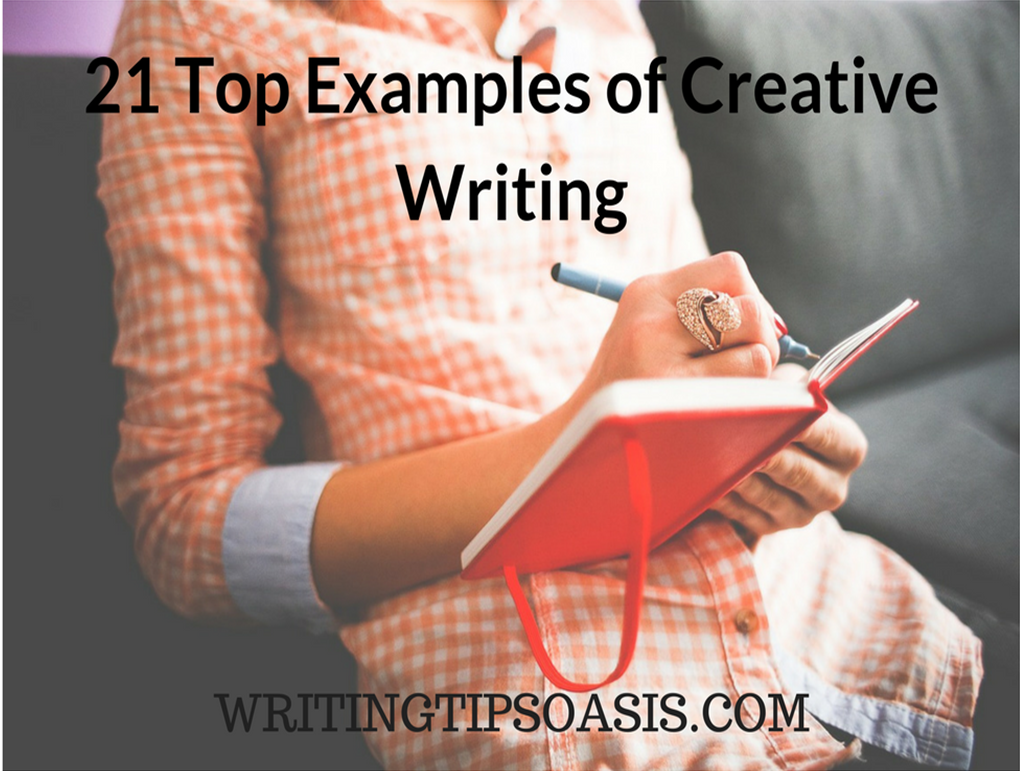
Let’s be practical: anyone can be a writer.
Sure, practicing the skill and perfecting the art takes a certain modicum of natural interest in the profession.
But the thing that so many people can often overlook is that being a “writer” isn’t defined by how much you write.
So many times we can get hung up on trying to write a bestselling novel or groundbreaking book that we can forget that there are so many other types of writing out there.
Take a step back for a moment and think about it this way:
Whether you have a blog, a social media page, or spend all day texting that special someone, there’s probably an inner literary genius inside you waiting to burst out on the page.
Maybe you don’t have the time or the patience to write a novel, and that’s okay. There are plenty of different types of writing out there and you can most likely find one category, or several, that allow you to get your thoughts on paper in a way that works for you.
If you’re curious to know more, or are just interested in trying out a new writing genre, we’ve made it easier for you by compiling a list of the top 21 examples of creative writing.
1. Novel Writing
A novel is probably the most popular example of creative writing out there. When you think “creative writing” an image of Stephen King typing madly at his computer is probably the first thing that pops into your head. And that’s okay. Given that novels have been a popular form of entertainment for centuries, it’s not surprising. Typically what distinguishes a novel from other forms of writing is that novels are usually works of fiction that are longer in length and follow a set of characters and plot structure.
2. Short Stories
When it comes to examples of imaginative writing, not unlike its longer counterpart, the novel, short stories also follow a set plot and typically feature one character or a selection of characters. However, the thing to keep in mind about short stories is that they typically resolve in fewer than 50 pages.

3. Flash Fiction
If you’re up for a real challenge, try your hand at some flash fiction . This type is similar to a short story or novel in the sense that it follows some form of a plot. However, flash fiction usually resolves within a few hundred words or less. There are a few kinds of flash fiction that exist: the six word story, the 50 word story, and the hundred word story. Additionally, flash fiction also has another faction known as sudden fiction, which usually tells a full story in about 750 words.
As an example of imaginative writing, the incredible thing about poetry is that there are so many kinds. From narrative to lyrical and even language poetry there’s so many different ways you can express yourself through a poem. You might be especially interested in pursuing poetry if you enjoy word play or experimenting with the musicality behind words.
Although rap is somewhat of a subcategory of poetry, it’s one of the few forms of poetry that can often get over looked in academic classes. However, it’s probably one of the more contemporary types of poetry available while still sticking to many of the classical rules (or tools) of poetry, including rhyme. Also, it’s one of the areas where the best writers are really produced. The reason for that is because rap forces writers to think on their feet in a way that many other genres don’t.
Playwriting is another great writing style to experiment with, especially if you enjoy the idea of seeing your work come to life. Typically, playwriting involves developing a script that both clearly sets the setting, plot, and characters while also minimizing the amount of description used. One of the key elements of a play is that it’s a collaboration of minds, even though they often don’t work together at the same time. Yet the final product, the performance, is always the end result of work done by the playwright as well as the director, actors and even set designers.
7. Scripts (T.V./Movies)
Like traditional plays, movie or T.V. scripts are often the result of collaboration between a team of people including the cast and crew. However, the big difference is that when you’re writing a T.V. or movie script , you’re often working together with the director and the actors as part of the production team.
Not a fiction writer? No problem! You probably have a unique story worth sharing: it’s called your life. Here’s the deal when it comes to memoirs: the biggest thing to remember is that not everything in your life is considered readership-worthy. In fact, most things probably aren’t. But, most likely, there is a unique angle or perspective that you can take when examining your life.
For example, if you have a really distinctive family history and you’re looking into exploring it, that could be a great subject for a memoir. Maybe you have a really interesting job that exposes you to lots of different people and events on a regular basis; you could write a book about your experiences in that field. The key to writing a good memoir is knowing what angle to take on any subject.
9. Non-Fiction Narratives
Of course, a memoir is just a subsection of a category known as the non-fiction narrative. But not all non-fiction narratives are memoirs. Take for example author Tim Hernandez, who wrote the book Mañana means Heaven . Hernandez writes in a style that is inherently descriptive and interesting, despite the fact that the book’s narrative is mostly based on research and interviews.
10. Songs/Lyrics
Another sector of poetry, songs and lyrics are also a great place where you can express your thoughts and emotions not only through words, but also through music. Whether you’re writing a love ballad or a hymn, there are lots of reasons to enjoy working in this genre. While a lot of this genre is relatively unrestrictive in terms of what you can create, it’s a really good idea to get familiar with the basics of song writing. Especially in an era where so much of the music we hear is impacted by technology, the more you know about the art of song writing, the freer you will be to experiment.
11. Speeches
Speech writing is another great way to express yourself and also reach a wider audience. The thing about speeches is that they are both a form of oral and written text, so the key to writing a really good speech is to take into consideration your phrasing, word choice and syntax. More importantly, the way a speech is delivered can really make or break its success. Practice strong enunciation, confident body language and invoking a clear voice.
12. Greeting Cards
You might hear a lot about greeting cards when people talk about how to make easy money as a writer. But the truth is, being a greeting card writer is anything but easy. You have to be able to keep the greeting card expressions short, catchy and, in a lot of cases, funny. However, if you’ve got the chops to try your hand at a few greeting cards, practice writing limericks and other forms of short poetry. More importantly, read lots of greeting cards to get an idea of how the best writers go about creating the really fun cards that you enjoy purchasing.
It used to be that blogs were the place where teenagers could go to express their teenage angst. But nowadays, blogs are also a great place to be if you’re a writer. There are an unlimited amount of topics you can successfully blog on that will garner attention from audiences. You can use your blog as a forum to share your writing or even reflect on current events, the stock market—really anything! The possibilities are endless, but the key is finding a subject and sticking to it. For example, if you decide to start a blog dedicated to rock music, stick to rock music. Avoid long tangents about politics or other unrelated subjects.
14. Feature Journalism
Feature Journalism is a great place to start if you want to get your feet wet if you’re interested in reporting. Why? Because there are a lot more creative aspects to feature journalism compared to news journalism. Feature stories typically allow you more flexibility with the kinds of details you put into the article, as well as more room for creativity in your lede.
15. Column Writing
If you like the idea of journalism but feel you could never be a journalist in light of your strong opinions, column writing is another avenue you can take. The thing about columns is that they’re typically based in ideas and opinions rather than fact. Yet, because columnists are considered experts in their respective fields, their opinion tends to hold more sway with readers.
As part of the non-fiction narrative family, the personal essay, or even the academic essay, has plenty of elements that are creative. Whether you’re writing about personal experiences or a science project, there are lots of opportunities you have to be creative and hook your reader. Even the most mundane reports have the opportunity to become interesting if you know how to present your topic. As with a lot of non-fiction writing, the secret to writing a good essay is all about your framing. When you begin writing, think about explaining the issue in the most engaging way possible. Just because your writing should cut to the chase doesn’t mean that it should be bland, boring or bogged down in technical jargon. Use anecdotes, clear and concise language, and even humor to express your findings.
17. Twitter Stories
With only 140 characters, how can you tell a story? Well, when you use Twitter, that’s exactly what you’re doing. However, a new phenomenon that’s currently taking over the site is a type of flash fiction called Twitterature, where writers tell a full story or write a poem in 140 characters or less.
18. Comic Strips
If you have a knack for writing and drawing, then you might be especially interested in working on a comic strip. Comic strips are harder project to tackle because they require a lot of preplanning before you start writing. Before you begin drafting you need to know the plot and have a strong outline for how the graphics will look.
19. Collaboration
This is typically a writing exercise that writers do with other writers to expand on their creativity. Essentially the way the exercise works is that one writer will start a story and another will finish it. You might be especially familiar with this kind of work if you’ve ever read the work of an author that was completed AFTER their death. However, collaboration is just another way you can bounce ideas off another person. You can also collaborate with other writers for world building , character development and even general brainstorming.
20. Novella
An example of creative writing, a novella is essentially the love child of a short story and a novel. Although the novella does feature a plot, the plot is typically less complicated compared to that of a novel. Usually novellas are about 50 pages.
21. Genre Writing
Another type of writing that fiction writers can do is genre writing. If you think of popular writers like Stephen King, Nora Roberts and James Patterson, then you’re probably familiar with genre writing. Essentially, genre writing is when a writer explores different stories in one particular genre, like romance, fantasy, or mystery. There’s a huge market out there for genre fiction, which makes it definitely worth pursuing if you a have preference for a particular kind of literature.
The important thing to keep in mind as a writer is that experimentation is never a bad idea. If you’re genuinely curious about one or more items on this list, give it a go! Some of the best literary works were created by accident.
What did you think of our list of 21 creative writing examples? Do you have experience in any of these types of creative writing? Do you know of any other creative writing examples? Please tell us more in the comments box below!
21 Top Examples of Creative Writing is an article from Writing Tips Oasis . Copyright © 2014-2017 Writing Tips Oasis All Rights Reserved
As a graduate from the University of Arizona in English and Creative Writing, Rofida Khairalla’s love for classical literature and post-modern fiction extends beyond the realm of books. She has provided her services independently as a freelance writer, and wrote on the news desk for the student-run newspaper, The Daily Wildcat. As an aspiring children’s book author, she’s refined her craft amongst the grand saguaros of the Southwest, and enjoys playing with her German Shepherd on the slopes of Mount Lemmon.

What is Creative Writing? A Key Piece of the Writer’s Toolbox
Not all writing is the same and there’s a type of writing that has the ability to transport, teach, and inspire others like no other.
Creative writing stands out due to its unique approach and focus on imagination. Here’s how to get started and grow as you explore the broad and beautiful world of creative writing!
What is Creative Writing?
Creative writing is a form of writing that extends beyond the bounds of regular professional, journalistic, academic, or technical forms of literature. It is characterized by its emphasis on narrative craft, character development, and the use of literary tropes or poetic techniques to express ideas in an original and imaginative way.
Creative writing can take on various forms such as:
- short stories
- screenplays
It’s a way for writers to express their thoughts, feelings, and ideas in a creative, often symbolic, way . It’s about using the power of words to transport readers into a world created by the writer.
5 Key Characteristics of Creative Writing
Creative writing is marked by several defining characteristics, each working to create a distinct form of expression:
1. Imagination and Creativity: Creative writing is all about harnessing your creativity and imagination to create an engaging and compelling piece of work. It allows writers to explore different scenarios, characters, and worlds that may not exist in reality.
2. Emotional Engagement: Creative writing often evokes strong emotions in the reader. It aims to make the reader feel something — whether it’s happiness, sorrow, excitement, or fear.
3. Originality: Creative writing values originality. It’s about presenting familiar things in new ways or exploring ideas that are less conventional.
4. Use of Literary Devices: Creative writing frequently employs literary devices such as metaphors, similes, personification, and others to enrich the text and convey meanings in a more subtle, layered manner.
5. Focus on Aesthetics: The beauty of language and the way words flow together is important in creative writing. The aim is to create a piece that’s not just interesting to read, but also beautiful to hear when read aloud.
Remember, creative writing is not just about producing a work of art. It’s also a means of self-expression and a way to share your perspective with the world. Whether you’re considering it as a hobby or contemplating a career in it, understanding the nature and characteristics of creative writing can help you hone your skills and create more engaging pieces .
For more insights into creative writing, check out our articles on creative writing jobs and what you can do with a creative writing degree and is a degree in creative writing worth it .
Styles of Creative Writing
To fully understand creative writing , you must be aware of the various styles involved. Creative writing explores a multitude of genres, each with its own unique characteristics and techniques.
Poetry is a form of creative writing that uses expressive language to evoke emotions and ideas. Poets often employ rhythm, rhyme, and other poetic devices to create pieces that are deeply personal and impactful. Poems can vary greatly in length, style, and subject matter, making this a versatile and dynamic form of creative writing.
Short Stories
Short stories are another common style of creative writing. These are brief narratives that typically revolve around a single event or idea. Despite their length, short stories can provide a powerful punch, using precise language and tight narrative structures to convey a complete story in a limited space.
Novels represent a longer form of narrative creative writing. They usually involve complex plots, multiple characters, and various themes. Writing a novel requires a significant investment of time and effort; however, the result can be a rich and immersive reading experience.
Screenplays
Screenplays are written works intended for the screen, be it television, film, or online platforms. They require a specific format, incorporating dialogue and visual descriptions to guide the production process. Screenwriters must also consider the practical aspects of filmmaking, making this an intricate and specialized form of creative writing.
If you’re interested in this style, understanding creative writing jobs and what you can do with a creative writing degree can provide useful insights.
Writing for the theater is another specialized form of creative writing. Plays, like screenplays, combine dialogue and action, but they also require an understanding of the unique dynamics of the theatrical stage. Playwrights must think about the live audience and the physical space of the theater when crafting their works.
Each of these styles offers unique opportunities for creativity and expression. Whether you’re drawn to the concise power of poetry, the detailed storytelling of novels, or the visual language of screenplays and plays, there’s a form of creative writing that will suit your artistic voice. The key is to explore, experiment, and find the style that resonates with you.
For those looking to spark their creativity, our article on creative writing prompts offers a wealth of ideas to get you started.
Importance of Creative Writing
Understanding what is creative writing involves recognizing its value and significance. Engaging in creative writing can provide numerous benefits – let’s take a closer look.
Developing Creativity and Imagination
Creative writing serves as a fertile ground for nurturing creativity and imagination. It encourages you to think outside the box, explore different perspectives, and create unique and original content. This leads to improved problem-solving skills and a broader worldview , both of which can be beneficial in various aspects of life.
Through creative writing, one can build entire worlds, create characters, and weave complex narratives, all of which are products of a creative mind and vivid imagination. This can be especially beneficial for those seeking creative writing jobs and what you can do with a creative writing degree .
Enhancing Communication Skills
Creative writing can also play a crucial role in honing communication skills. It demands clarity, precision, and a strong command of language. This helps to improve your vocabulary, grammar, and syntax, making it easier to express thoughts and ideas effectively .
Moreover, creative writing encourages empathy as you often need to portray a variety of characters from different backgrounds and perspectives. This leads to a better understanding of people and improved interpersonal communication skills.
Exploring Emotions and Ideas
One of the most profound aspects of creative writing is its ability to provide a safe space for exploring emotions and ideas. It serves as an outlet for thoughts and feelings , allowing you to express yourself in ways that might not be possible in everyday conversation.
Writing can be therapeutic, helping you process complex emotions, navigate difficult life events, and gain insight into your own experiences and perceptions. It can also be a means of self-discovery , helping you to understand yourself and the world around you better.
So, whether you’re a seasoned writer or just starting out, the benefits of creative writing are vast and varied. For those interested in developing their creative writing skills, check out our articles on creative writing prompts and how to teach creative writing . If you’re considering a career in this field, you might find our article on is a degree in creative writing worth it helpful.
4 Steps to Start Creative Writing
Creative writing can seem daunting to beginners, but with the right approach, anyone can start their journey into this creative field. Here are some steps to help you start creative writing .
1. Finding Inspiration
The first step in creative writing is finding inspiration . Inspiration can come from anywhere and anything. Observe the world around you, listen to conversations, explore different cultures, and delve into various topics of interest.
Reading widely can also be a significant source of inspiration. Read different types of books, articles, and blogs. Discover what resonates with you and sparks your imagination.
For structured creative prompts, visit our list of creative writing prompts to get your creative juices flowing.
Editor’s Note : When something excites or interests you, stop and take note – it could be the inspiration for your next creative writing piece.
2. Planning Your Piece
Once you have an idea, the next step is to plan your piece . Start by outlining:
- the main points
Remember, this can serve as a roadmap to guide your writing process. A plan doesn’t have to be rigid. It’s a flexible guideline that can be adjusted as you delve deeper into your writing. The primary purpose is to provide direction and prevent writer’s block.
3. Writing Your First Draft
After planning your piece, you can start writing your first draft . This is where you give life to your ideas and breathe life into your characters.
Don’t worry about making it perfect in the first go. The first draft is about getting your ideas down on paper . You can always refine and polish your work later. And if you don’t have a great place to write that first draft, consider a journal for writing .
4. Editing and Revising Your Work
The final step in the creative writing process is editing and revising your work . This is where you fine-tune your piece, correct grammatical errors, and improve sentence structure and flow.
Editing is also an opportunity to enhance your storytelling . You can add more descriptive details, develop your characters further, and make sure your plot is engaging and coherent.
Remember, writing is a craft that improves with practice . Don’t be discouraged if your first few pieces don’t meet your expectations. Keep writing, keep learning, and most importantly, enjoy the creative process.
For more insights on creative writing, check out our articles on how to teach creative writing or creative writing activities for kids.
Tips to Improve Creative Writing Skills
Understanding what is creative writing is the first step. But how can one improve their creative writing skills? Here are some tips that can help.
Read Widely
Reading is a vital part of becoming a better writer. By immersing oneself in a variety of genres, styles, and authors, one can gain a richer understanding of language and storytelling techniques . Different authors have unique voices and methods of telling stories, which can serve as inspiration for your own work. So, read widely and frequently!
Practice Regularly
Like any skill, creative writing improves with practice. Consistently writing — whether it be daily, weekly, or monthly — helps develop your writing style and voice . Using creative writing prompts can be a fun way to stimulate your imagination and get the words flowing.
Attend Writing Workshops and Courses
Formal education such as workshops and courses can offer structured learning and expert guidance. These can provide invaluable insights into the world of creative writing, from understanding plot development to character creation. If you’re wondering is a degree in creative writing worth it, these classes can also give you a taste of what studying creative writing at a higher level might look like .
Joining Writing Groups and Communities
Being part of a writing community can provide motivation, constructive feedback, and a sense of camaraderie. These groups often hold regular meetings where members share their work and give each other feedback. Plus, it’s a great way to connect with others who share your passion for writing.
Seeking Feedback on Your Work
Feedback is a crucial part of improving as a writer. It offers a fresh perspective on your work, highlighting areas of strength and opportunities for improvement. Whether it’s from a writing group, a mentor, or even friends and family, constructive criticism can help refine your writing .
Start Creative Writing Today!
Remember, becoming a proficient writer takes time and patience. So, don’t be discouraged by initial challenges. Keep writing, keep learning, and most importantly, keep enjoying the process. Who knows, your passion for creative writing might even lead to creative writing jobs and what you can do with a creative writing degree .
Happy writing!
Brooks Manley

Creative Primer is a resource on all things journaling, creativity, and productivity. We’ll help you produce better ideas, get more done, and live a more effective life.
My name is Brooks. I do a ton of journaling, like to think I’m a creative (jury’s out), and spend a lot of time thinking about productivity. I hope these resources and product recommendations serve you well. Reach out if you ever want to chat or let me know about a journal I need to check out!
Here’s my favorite journal for 2024:

Gratitude Journal Prompts Mindfulness Journal Prompts Journal Prompts for Anxiety Reflective Journal Prompts Healing Journal Prompts Cognitive Behavioral Therapy Journal Prompts Mental Health Journal Prompts ASMR Journal Prompts Manifestation Journal Prompts Self-Care Journal Prompts Morning Journal Prompts Evening Journal Prompts Self-Improvement Journal Prompts Creative Writing Journal Prompts Dream Journal Prompts Relationship Journal Prompts "What If" Journal Prompts New Year Journal Prompts Shadow Work Journal Prompts Journal Prompts for Overcoming Fear Journal Prompts for Dealing with Loss Journal Prompts for Discerning and Decision Making Travel Journal Prompts Fun Journal Prompts
Inspiring Ink: Expert Tips on How to Teach Creative Writing
You may also like, the 7 best bullet journals for 2024 & beyond.
What is a Vision Board and How to Make A Board Your Own
What time of day are people most creative, leave a reply cancel reply.
Save my name, email, and website in this browser for the next time I comment.
- Productivity
- Favorite Journals
Creative Writing | Definition, Techniques & Examples
Austin Valenzuela earned his bachelor's degree in psychology from Grand Canyon University and has written about psychology for over four years. He is a writer of science-fiction and fantasy. His published novel Unholy: A Gothic Fantasy and short story in the anthology Beneath the Twin Suns are available everywhere. He is a member of the Florida Writers Association and National Society of Collegiate Scholars.
Bryanna has received both her BA in English and MFA in Creative Writing. She has been a writing tutor for over six years.
Amy has taught and tutored college-level English; she has a master's degree from Colorado State University in rhetoric and composition.
Table of Contents
What is creative writing, examples of creative writing, lesson summary, creative writing: writing prompts.
The below writing prompts allow students to flex their creative writing muscles by experimenting with different types of creative writing genres and reflecting on their finished product and writing process.
Prompt 1: Poetry
Write a poem about a common, everyday object like a pencil, a spoon, a t-shirt, or a water bottle. Think about how to create striking imagery and emotion in your work—you may take time to brainstorm possible words you can use to create a visually and emotionally engaging work. In addition, your poem should include at least two metaphors or similes. After writing your poem, which should be at least ten lines long, answer the questions that follow.
- Reflect on your writing process. How did you prepare to write your poem? Did you think about the major theme(s) you wanted your poem to address before you started writing?
- Explore the techniques you used in your poem: how did you create setting? How did you establish point-of-view? How did you appeal to your audience's emotions?
Prompt 2: Short Story
In at least 750 words, write a short story about an unlikely friendship. Before writing your short story, consider tracing a plot diagram that sketches out the story's exposition, rising action, climax, falling action, and resolution. After writing your story, answer the questions that follow.
- What is the basic plot of your story? (Consider: exposition, rising action, climax, falling action, and resolution)
- How did you develop the characters in your story?
- How did you use dialogue in your story? (If you didn't use any dialogue, describe what effect this choice has on your audience.)
- What literary devices did you include in your story and what is their overall effect? (e.g. metaphor, personification, alliteration, etc.)
- What is the overall theme of your story? How do you communicate this theme to your audience?
What are the 8 elements of creative writing?
The eight elements of creative writing that are used in short stories and novels are character development, setting, plot, conflict, theme, point of view, tone, and style. Some of these elements are also often used in poems and works of creative nonfiction such as memoir and personal essay.
What is creative writing and its purpose?
Creating writing is a means of using written language to tell an interesting or enjoyable story that will engage, inspire, excite, or surprise a reader, evoking emotions and provoking thought. Its purpose is to artfully educate, entertain, or inform in a meaningful way that the reader will find enjoyable.
What are the 4 forms of creative writing?
The four forms of creative writing are fiction, creative nonfiction, poetry, and scriptwriting which is sometimes called screenwriting or play writing. Creative nonfiction can take several forms such as memoir and personal essay.
What is an example of creative writing?
One example of creative writing is fiction writing. Fiction includes traditional novels, short stories, and graphic novels. By definition, fiction is a story that is not true, although it can be realistic and include real places and facts.
The invention of the written word, sometime around 3200 B.C., launched creative writing with the recording of stories like The Odyssey and tales of Norse gods. Over time, the stories morphed and the skill of storytellers improved as well. Today, over three-fourths of the population can read and write. Oral storytellers have been using elements like voice and personality to entertain and convey human experience. But what is creative writing ? Although the craft has taken many forms from the poem to the novel, the core purpose of conveying human experience remains. Indeed, many of our oldest stories still inspire modern-day storytellers such as Christopher Tolkien and his famous Lord of the Rings trilogy.
The dictionary defines creative writing as writing that displays imagination or invention. Creative, artistic writing uses words to convey emotion or feeling. One must use imaginary scenarios invented by themselves. Rather than being limited to academic or technical subjects, which shun first-person voice and emotion, creative writing uses elements such as character development, plot, and the lyricism of words to share the author's emotion with the reader. Academic writing is different in its essential purpose because it does not allow the author to share emotion. Good creative writing does this best, as we will see in later examples.
Types of Creative Writing
There is an infinite number of ways to convey human experience using words. This is the fun of the craft. Here are some of the most common types of creative writing and their general form:
- Autobiography/Memoir - Narrative writing based on the author's memories.
- Flash Fiction - Offers character and plot in extreme brevity, with a word count of six to one thousand words.
- Novel - Long work of narrative fiction, typically with a word count of eighty-thousand to one-hundred-thousand words.
- Novella - Narrative prose of shorter length, with a word count of ten-thousand to forty-thousand words.
- Play - Work of drama consisting of mostly dialogue intended for theatrical performance.
- Poetry - Uses aesthetic and often rhythmic qualities of language to convey meaning. Poems may not follow a narrative structure.
- Screenplay - Written work by screenwriters intended for film, television, or a video game.
- Short Story - Prose fiction typically read in one sitting, between five thousand to ten thousand words.
Elements of Creative Writing
The purpose of creative writing elements is to aid in the conveyance of aesthetic or symbolic meaning. Different types of creative writing use different elements. However, these elements are used universally within their form and are all critical components of good creative writing. The most helpful elements to learn and perfect are as follows:
- Action - Movements that characters undertake in the story.
- Character - Used to progress the plot and establish inner or outer conflict.
- Conflict - Challenges, suspense, and uncertainty for whether the goal will be achieved.
- Dialogue - A verbal exchange between characters.
- Pacing - The speed at which a story is told.
- Plot - The sequence of a story's events.
- Scene - Dramatic sections in a story within a specific time and place.
- Setting - Time and location in the narrative.
- Suspense - The anticipation of an outcome or plot.
- Theme - Central topic or message of a narrative.
- Tone - The narrator's attitude toward the subject matter.
- Voice - The manner of expression.
Creative Writing Techniques
Unlike elements, creative writing techniques are not universal. They are going to be unique to each author and story. The combination of different techniques will yield different results. Some techniques work better for specific stories and styles of creative writing than others.
- Considering the Audience - When the author appeals to the expectations and emotions of the readership.
- Genre - Determined by technique, tone, content, and sometimes length. Mainly used for marketing purposes.
- Metaphor - Figure of speech meant to address an abstract concept.
- Narration/Point of View - Who is telling the story: first-person (I chased after the dog), second-person (You chased after the dog), third-person (He/she chased after the dog).
- Rhyme - Used to appeal to senses and unify stanzas.
- Structure - Common methods of building stories that specifically address adventure, suspense, and resolution.
- Style - Unique choice of words, tone, and grammar used to affect readers.
To unlock this lesson you must be a Study.com Member. Create your account

An error occurred trying to load this video.
Try refreshing the page, or contact customer support.
You must c C reate an account to continue watching
Register to view this lesson.
As a member, you'll also get unlimited access to over 88,000 lessons in math, English, science, history, and more. Plus, get practice tests, quizzes, and personalized coaching to help you succeed.
Get unlimited access to over 88,000 lessons.
Already registered? Log in here for access
Resources created by teachers for teachers.
I would definitely recommend Study.com to my colleagues. It’s like a teacher waved a magic wand and did the work for me. I feel like it’s a lifeline.
You're on a roll. Keep up the good work!
Just checking in. are you still watching.
- 0:02 Creative Writing
- 1:50 Examples
- 4:03 Lesson Summary
The best creative writing examples use the elements and techniques mentioned above to entertain and at the same time convey a meaningful, timeless message to the reader. Some writers choose to lean on the side of creative writing that is more eloquent and harder to read. In contrast, others prefer to have the meaning of their prose easy to understand. This is typically the difference between poetry and longer-form fiction. Below are some creative writing examples that show the different elements and techniques we've covered at use.
- Fire and Ice:
"Some say the world will end in fire,
Some say in ice.
From what I've tasted of desire
I hold with those who favor fire.
But if it had to perish twice,
I think I know enough of hate
To say that for destruction ice
Is also great
And would suffice."
This poem by Robert Frost effectively uses rhyme, metaphor, and juxtaposition to evoke emotion in the reader. In keeping with the creative writing tradition, this poem by Robert Frost was inspired by an earlier work by Dante Alighieri titled Inferno . The use of rhyme unites key stanzas such as lines one, three, and four, which elaborate upon the meaning of the world ending in fire. This poem is brief and calls for a reread almost immediately, inviting the reader to analyze the text deeply and draw out meaning. The ultimate message commonly interpreted from this poem by Frost is that, although the two elements of fire and ice appear entirely different, their potential destructive force is much the same. At the same time, Frost establishes a metaphor between these natural forces and human emotions of desire and hate.
- Excerpt from The Catcher in the Rye:
"There were never many girls at all at the football games. Only seniors were allowed to bring girls with them. It was a terrible school, no matter how you looked at it. I like to be somewhere at least where you can see a few girls around once in a while, even if they're only scratching their arms or blowing their noses or even just giggling or something."
This novel excerpt for J.D. Salinger's most celebrated novel is a great display of character voice used within setting and context to progress the plot and establish a theme. The novel is about a young boy who is kicked out of his private school because he does not get good grades and the following journey home to his parents' house. Holden hates this school and is probably glad to go home, no matter what. In this section at the beginning of the story, we are getting to know the main character Holden, and in this passage, we learn a lot about his outlook on the world. We know that Holden, like many teenage boys, is more interested in the girls than anything, which might be a reason why he got kicked out of the school in the first place. Moreover, the nonchalant tone of Holden's storytelling and his use of average and repeated words makes the reader feel like they know Holden in an intimate way, making them more invested with his actions and journey back to his parents' home.
While it often has beautiful and awe-inspiring elements, creative writing is best defined as using words to convey emotion to the reader through imagination and invention. Creative writing can include facts about the world but must use them in a made-up fashion to create a unique message. The primary four forms of creative writing are fiction, non-fiction, poetry, and screenwriting. Writers will use a mixture of creative elements and techniques to tell a story or evoke feelings in the reader. The main elements used include:
- Character development
- Point of View
The best creative writers combine all or most of these elements with a story that resonates with audiences of the present and future. When an author uses these elements and techniques effectively and speaks the truth from their heart, the message conveyed is timeless.
Video Transcript
Defining creative writing.
You might have heard it called different things. Traditionally referred to as literature, creative writing is an art of sorts - the art of making things up. It's writing done in a way that is not academic or technical but still attracts an audience. Though the definition is rather loose, creative writing can for the most part be considered any writing that is original and self-expressive. A news article, for example, cannot be considered creative writing because its main goal is to present facts and not to express the feelings of the writer. While a news article can be entertaining, its main purpose is to present the facts.
The purpose of creative writing is to both entertain and share human experience, like love or loss. Writers attempt to get at a truth about humanity through poetics and storytelling. If you'd like to try your hand at creative writing, just keep in mind that whether you are trying to express a feeling or a thought, the first step is to use your imagination.
Types of creative writing include:
- Movie and television scripts
- Fiction (novels, novellas, and short stories)
- Personal essays
As you can see, some nonfiction types of writing can also be considered creative writing. Memoirs and personal essays, for example, can be written creatively to inform your readers about your life in an expressive way. Because these types are written in first person, it's easier for them to be creative.
Techniques used in creative writing include:
- Plot development
- Vivid setting
- Underlying theme
- Point of view
- Metaphors and similes
- Figures of speech
- Imaginative language
- Emotional appeal
- Heavy description
Poetry and Songs
A poem or a song tends to be more elusive, or mysterious, because it has limited space. Because of its spatial limitations, however, it can make leaps in subject and time, and it doesn't have to rely on narrative structure. In poetry and songs, literary devices, like similes and metaphors, can be used to take the readers to surprising places. A good example of this is the opening of the poem 'A Life' by Sylvia Plath:
'Touch it: it won't shrink like an eyeball,
This egg-shaped bailiwick, clear as a tear.
Here's yesterday, last year ---
Palm-spear and lily distinct as flora in the vast
Windless threadwork of a tapestry.'
Note how shocking the comparison is, how it immediately captures the reader's attention. The goal of this poem's image is to build from this idea of life as an eyeball and makes the reader really try to visualize it.
Fiction and Plays
A novel or a play, on the other hand, has plenty of time to unfold. Therefore, fiction usually contains plot and character development. As a creative writer, you want your story to captivate readers. You also want to create a relationship between the readers and the characters. This requires both physical and emotional details so that readers will empathize with the action and whatever pain or pleasure the characters undergo. To use as an example, read the following excerpt from the novel Great Expectations by Charles Dickens:
'There either is or is not, that's the way things are. The colour of the day. The way it felt to be a child. The saltwater on your sunburnt legs. Sometimes the water is yellow, sometimes it's red. But what colour it may be in memory, depends on the day. I'm not going to tell you the story the way it happened. I'm going to tell it the way I remember it.'
The character's voice in this quote is really captivating. It sounds honest and thoughtful and also a little haunting. The foreshadowing of what truly happened will want to make a reader continue forward, and the character being developed is one that readers will want to learn more about.
Creative writing is the art of using words to make things up. However, a good creative writer makes things up that people will want to read. To do this, you have to use your imagination and try to capture an emotion or a human truth, like love or loss. This does not include academic or technical writing because these types of writing cannot include made-up material nor are their purposes to express the writer's feelings.
Creative writing's goal is to captivate an audience and create an emotional or thoughtful appeal, although the type of writing will determine how it will do so. Some types of creative writing, like poems and songs, have limited space, and therefore tend to be more mysterious and less narrative. Types like novels and plays have room to explore character and plot development. Anyone can write creatively; all it takes is imagination and having something to say!
Learning Outcomes
Once you are finished, you should be able to:
- Recall the purpose of creative writing
- List some of the common techniques used in creative writing
- Describe some types of creative writing
Unlock Your Education
See for yourself why 30 million people use study.com, become a study.com member and start learning now..
Already a member? Log In
Recommended Lessons and Courses for You
Related lessons, related courses, recommended lessons for you.

Creative Writing | Definition, Techniques & Examples Related Study Materials
- Related Topics
Browse by Courses
- ILTS Science - Physics (243) Prep
- FTCE Business Education 6-12 (051) Prep
- NYSTCE English Language Arts (003): Practice and Study Guide
- CSET English Subtest IV (108) Prep
- ILTS Social Science - History (246) Prep
- MCAT Test: Practice and Study Guide
- ILTS School Counselor (235) Prep
- 9th Grade English: High School
- CSET English Subtest II Prep
- American Literature: Help and Review
- Study.com ACT® Test Prep: Practice & Study Guide
- Praxis Mathematics (5165) Prep
- Praxis Economics (5911) Prep
- ILTS Social Science - Psychology (248) Prep
- English 104: College Composition I
Browse by Lessons
- Concrete Poetry: Lesson for Kids
- Haiku Poetry: Lesson for Kids
- Limericks Lesson Plan for Elementary School
- Punctuation & Capitalization in Poetry | Rules & Examples
- Teaching Slam Poetry for Middle School
- 'I Am' Poem Lesson Plan
- Writing a Mystery Story Lesson Plan
- Poetry Writing Exercises
- Second-Person Point of View: Definition & Examples
- Cinquain Poems: Lesson for Kids
- I Wish Poetry Examples, Format & Features
- Fall Writing Prompts for Middle School
- 10th Grade Assignment - Writing Original Poetry
- Photo Writing Prompts for Middle School
- Cat in the Hat Writing Prompts
Create an account to start this course today Used by over 30 million students worldwide Create an account
Explore our library of over 88,000 lessons
- Foreign Language
- Social Science
- See All College Courses
- Common Core
- High School
- See All High School Courses
- College & Career Guidance Courses
- College Placement Exams
- Entrance Exams
- General Test Prep
- K-8 Courses
- Skills Courses
- Teacher Certification Exams
- See All Other Courses
- Create a Goal
- Create custom courses
- Get your questions answered
TRY OUR FREE APP
Write your book in Reedsy Studio. Try the beloved writing app for free today.
Craft your masterpiece in Reedsy Studio
Plan, write, edit, and format your book in our free app made for authors.

Guides • Perfecting your Craft
Last updated on Dec 23, 2022
Creative Writing: 8 Fun Ways to Get Started
Creative writing is a written art form that uses the imagination to tell stories and compose essays, poetry, screenplays, novels, lyrics, and more. It can be defined in opposition to the dry and factual types of writing found in academic, technical, or journalistic texts.
Characterized by its ability to evoke emotion and engage readers, creative writing can tackle themes and ideas that one might struggle to discuss in cold, factual terms.
If you’re interested in the world of creative writing, we have eight fantastic exercises and activities to get you started.

1. Use writing prompts every week

Coming up with ideas for short stories can be challenging, which is why we created a directory of 1700+ creative writing prompts covering a wide range of genres and topics. Writing prompts are flexible in nature, they are meant to inspire you without being too constrictive. Overall, they are a great way to keep your creative muscles limber.

If you’re struggling for motivation, how does a hard deadline and a little prize money sound? Prompts-based writing contests are a fantastic way to dive into creative writing: the combination of due dates, friendly rivalries, prize money, and the potential to have your work published is often just what’s needed to propel you over the finish line.
We run a weekly writing contest over on Reedsy Prompts, where hundreds of writers from all around the world challenge themselves weekly to write a short story between 1,000 and 3,000 words for a chance to win the $250 prize. Furthermore, the community is very active in providing constructive feedback, support, and accountability to each other 一 something that will make your efforts even more worthwhile.
Take a peek at our directory of writing contests which features some of the most prestigious open writing competitions in the world.
2. Start journaling your days

Another easy way to get started with creative writing is to keep a journal. We’re not talking about an hour-by-hour account of your day, but journaling as a way to express yourself without filters and find your ‘voice in writing’. If you’re unsure what to journal about, think of any daily experiences that have had an impact on you, such as…
Special moments . Did you lock yourself out of your house? Or did you catch a beautiful sunset on your way back from groceries? Capture those moments, and how you felt about them.
People . Did you have an unusual exchange with a stranger at the bar? Or did you reconnect with someone you haven’t seen in years? Share your thoughts about it.
World events . Is there something happening in the world right now that is triggering you? That’s understandable. You can reflect on it (and let some steam off) while journaling.
Memories . Did you go down memory lane after a glass of wine? Great, honor those memories by trying to recollect them in detail on paper so that they will always stay vivid in your mind.
Life decisions . Are you having an existential crisis about what to do with your life? Write down your thought process, and the pros and cons of the possible decisions in front of you. You’ll be surprised to discover that, not only is it a great creative writing exercise, but it can also actually help you sort your life out!
If you struggle to write consistently, sign up for our How to Write a Novel course to finish a novel in just 3 months.

NEW REEDSY COURSE
How to Write a Novel
Enroll in our course and become an author in three months.
3. Create an anonymous social media account

Like anonymous blogging, an incognito Twitter account sidesteps the pressure that comes with attaching your name to your work. Anonymously putting tiny stories out into the ether gives you the freedom to create without worrying about the consequences — which is great, so long as you don’t use it as an opportunity to troll people or spread conspiracy theories.
You could use the anonymous account in different ways. For example, you could…
- Tweet from unique points of view (e.g. a dog observing human behavior );
- Create a parody account of real or fictional people (e.g. an English poet from the Middle Ages );
- Challenge yourself to write tiny flash fiction stories that fit into Twitter threads.
Just remember, you’re not doing this to fool anyone into thinking that your account is real: be a good citizen and mark yourself a fiction account in your bio.

But if you’re not really a social media kinda person, you may enjoy our next tip, which is a bit more on the analog side.

GET ACCOUNTABILITY
Meet writing coaches on Reedsy
Industry insiders can help you hone your craft, finish your draft, and get published.
4. Find an old photo and tell its story

Find a random old photo — maybe on the web, maybe from a photo album in a yard sale — and see what catches your attention. Look closely at it and try to imagine the story behind it. What was happening? Who are the people in it and how are they really feeling? Do they share a relationship, and of what kind? What are their goals and dreams?
In other words, bring the photo to life with your imagination. Don't be afraid to take artistic license with your story, as the goal is to be creative and have fun while writing.
How do you know it’s creative writing?

5. Create a character from a random name

Just as our universe started from a few simple elements, you can create a character from a few basic information, like their name, culture, and gender. Reedsy’s handy character name generator can help you with that, offering random names based on archetypes, Medieval roots, fantasy traits and more. A few examples? A Celtic heroine named Fíona O'Keefe, a hero’s sidekick named Aderine, or a Korean track star named Park Kang-Dae.
Once you've chosen their name, begin to develop their personality. Set a timer for 5–10 minutes and write anything that comes to mind about them. It could be a page from their FBI dossier, a childhood diary entry, or simply a scene about them boiling an egg.
Just ‘go with the flow’ and don’t stop writing until your time is up. Repeat the process a few times to further hone the personality. If you like what you end up with, you can always go deeper later by creating a character bible .
If a stream-of-consciousness exercise is not your thing, you can try to imagine your character in a specific situation and write down how’d they respond to it. For example, what if they were betrayed by a friend? Or if they were elected in power? To help you imagine situations to put your character in, we made a free template that you can download below.

FREE RESOURCE
Reedsy’s Character Questionnaire
40 questions to help you develop memorable characters.
6. Construct a character by people-watching

People watching is “the action of spending time idly observing people in a public place.” In a non-creepy way, ideally. Sit on a bench on a public square or on a road-side table at your favorite café, and start observing the people around you. Pay attention to any interesting quirks or behaviors, and write it down. Then put on your detective’s hat and try to figure out what that tells you about them.
For example, the man at the table next to you at the restaurant is reading the newspaper. His jacket and hat are neatly arranged next to him. The pages make a whipping sound as he briskly turns them, and he grimaces every time he reads a new article. Try to imagine what he’s reading, and why he’s reacting the way he is. Then, try to build a character with the information you have. It’s a fun creative exercise that will also, hopefully, help you better empathize with strangers.
7. “Map” something you feel strongly about into a new context

Placing your feelings into new contexts can be a powerful creative writing exercise. The idea is to start from something you feel strongly about, and frame it into a completely different context.
For example, suppose your heart is torn apart after you divorce your life-long partner: instead of journaling or crafting an entire novel about it, you could tell a story about a legendary trapeze duo whose partnership has come to an end. If you’re struggling with politicking and petty power dynamics at the office: what if you “mapped” your feelings onto an ant who resents being part of a colony? Directing your frustration at a queen ant can be a fun and cathartic writing experience (that won’t get you in trouble if your co-workers end up reading your story).
8. Capture the moment with a haiku

Haikus are poems from the Japanese tradition that aim to capture, in a few words, daily moments of insight (usually inspired by nature). In a nutshell, it’s about becoming mindful of your surroundings, and notice if you can see something in a new or deeper way 一 then use contrasting imagery to express whatever you noticed.
Here’s an example:
Bright orange bicycle
Speeding through the autumn leaves
A burst of color waves
It may sound a bit complicated, but it shouldn’t be 一 at least not for the purpose of this exercise. Learn the basics of haiku-writing , then challenge yourself to write one per day for a week or month. At the end, you’ll be able to look back at your collection of poems and 一 in the worst case scenario 一 revisit small but significant moments that you would have otherwise forgot about.
Creative writing can be any writing you put your heart and soul into. It could be made for the purpose of expressing your feelings, exploring an idea, or simply entertaining your readers. As you can see there’s many paths to get involved with it, and hundreds of exercises you can use as a starting point. In the next post, we’ll look more in detail at some creative writing examples from some fellow authors.
Join a community of over 1 million authors
Reedsy is more than just a blog. Become a member today to discover how we can help you publish a beautiful book.
Bring your stories to life
Our free writing app lets you set writing goals and track your progress, so you can finally write that book!

1 million authors trust the professionals on Reedsy. Come meet them.
Enter your email or get started with a social account:

27 Creative Writing Examples To Spark Your Imagination
With all the types of creative writing to choose from, it’s hard enough to focus on just one or two of your favorites.
When it comes to writing your own examples, don’t be hard on yourself if you hit a wall.
We’ve all done it.
Sometimes, all you need is a generous supply of well-crafted and inspirational creative writing examples.
Good thing you’re here!
For starters, let’s get clear on what creative writing is.
What Is Creative Writing?
How to start creative writing , 1. novels and novellas, 2. short stories and flash fiction, 3. twitter stories (140 char), 4. poetry or songs/lyrics, 5. scripts for plays, tv shows, and movies, 6. memoirs / autobiographical narratives, 7. speeches, 9. journalism / newspaper articles, 11. last wills and obituaries, 12. dating profiles and wanted ads, 13. greeting cards.
Knowing how to be a creative writer is impossible if you don’t know the purpose of creative writing and all the types of writing included.
As you’ll see from the categories listed further on, the words “creative writing” contain multitudes:
- Novels, novellas, short stories, flash fiction, microfiction, and even nanofiction;
- Poetry (traditional and free verse);
- Screenplays (for theatrical stage performances, TV shows, and movies)
- Blog posts and feature articles in newspapers and magazines
- Memoirs and Testimonials
- Speeches and Essays
- And more—including dating profiles, obituaries, and letters to the editor.
Read on to find some helpful examples of many of these types. Make a note of the ones that interest you most.
Once you have some idea of what you want to write, how do you get started?
Allow us to suggest some ideas that have worked for many of our readers and us:
- Keep a daily journal to record and play with your ideas as they come;
- Set aside a specific chunk of time every day (even 5 minutes) just for writing;
- Use a timer to help you stick to your daily writing habit ;
- You can also set word count goals, if you find that more motivating than time limits;
- Read as much as you can of the kind of content you want to write;
- Publish your work (on a blog), and get feedback from others.
Now that you’ve got some ideas on how to begin let’s move on to our list of examples.
Creative Writing Examples
Read through the following examples to get ideas for your own writing. Make a note of anything that stands out for you.
Inspiring novel-writing examples can come from the first paragraph of a well-loved novel (or novella), from the description on the back cover, or from anywhere in the story.
From Circe by Madeline Miller
““Little by little I began to listen better: to the sap moving in the plants, to the blood in my veins. I learned to understand my own intention, to prune and to add, to feel where the power gathered and speak the right words to draw it to its height. That was the moment I lived for, when it all came clear at last and the spell could sing with its pure note, for me and me alone.”
From The Left Hand of Darkness by Ursula K. Le Guin:
“‘I’ll make my report as if I told a story, for I was taught as a child on my homeworld that Truth is a matter of the imagination…. ”
The shorter your story, the more vital it is for each word to earn its place. Each sentence or phrase should be be necessary to your story’s message and impact.
From “A Consumer’s Guide to Shopping with PTSD” by Katherine Robb
“‘“Do you know what she said to me at the condo meeting?” I say to the salesman. She said, “Listen, the political climate is so terrible right now I think we all have PTSD. You’re just the only one making such a big deal about it.”
“The salesman nods his jowly face and says, “That Brenda sounds like a real b***h.”’
From Interpreter of Maladies by Jhumpa Lahiri (collection of short stories)
“Something happened when the house was dark. They were able to talk to each other again.” (From ‘A Temporary Matter’)
Use the hashtag #VSS to find a generous sampling of short Twitter stories in 140 or fewer characters. Here are a few examples to get you started:
From Chris Stocks on January 3rd, 2022 :
“With the invention of efficient 3D-printable #solar panels & cheap storage batteries, the world was finally able to enjoy the benefits of limitless cheap green energy. Except in the UK. We’re still awaiting the invention of a device to harness the power of light drizzle.” #vss365 (Keyword: solar)
From TinyTalesbyRedsaid1 on January 2nd, 2022 :
“A solar lamp would safely light our shack. But Mom says it’ll lure thieves. I squint at my homework by candlelight, longing for electricity.” #vss #vss365 #solar
If you’re looking for poetry or song-writing inspiration, you’ll find plenty of free examples online—including the two listed here:
From “I’m Nobody! Who are you?” by Emily Dickinson
“I’m Nobody! Who are you?
Are you – Nobody – too?
Then there’s a pair of us!
Don’t tell! they’d advertise – you know!
“How dreary – to be – Somebody!
How public – like a Frog –
To tell one’s name – the livelong June –
To an admiring Bog!
From “Enemy” by Imagine Dragons
“I wake up to the sounds
Of the silence that allows
For my mind to run around
With my ear up to the ground
I’m searching to behold
The stories that are told
When my back is to the world
That was smiling when I turned
Tell you you’re the greatest
But once you turn they hate us….”
If you enjoy writing dialogue and setting a scene, check out the following excerpts from two very different screenplays. Then jot down some notes for a screenplay (or scene) of your own.
From Mean Girls by Tina Fey (Based on the book, Queen Bees and Wannabes” by Rosalind Wiseman
“Karen: ‘So, if you’re from Africa, why are you white?’
“Gretchen: ‘Oh my god, Karen! You can’t just ask people why they’re white!’
“Regina: ‘Cady, could you give us some privacy for, like, one second?’
“Cady: ‘Sure.’
Cady makes eye contact with Janis and Damien as the Plastics confer.
“Regina (breaking huddle): ‘Okay, let me just say that we don’t do this a lot, so you should know that this is, like, a huge deal.’
“Gretchen: ‘We want to invite you to have lunch with us every day for the rest of the week.’
“Cady: ‘Oh, okay…’
“Gretchen: Great. So, we’ll see you tomorrow.’
“Karen: ‘On Tuesdays, we wear pink.’”
#10: From The Matrix by Larry and Andy Wachowski
“NEO: ‘That was you on my computer?’
“NEO: ‘How did you do that?’
“TRINITY: ‘Right now, all I can tell you, is that you are in danger. I brought you here to warn you.’
“NEO: ‘Of what?’
“TRINITY: ‘They’re watching you, Neo.’
“NEO: ‘Who is?’
“TRINITY: ‘Please. Just listen. I know why you’re here, Neo. I know what you’ve been doing. I know why you hardly sleep, why you live alone and why, night after night, you sit at your computer. You’re looking for him.’
“Her body is against his; her lips very close to his ear.
“TRINITY: ‘I know because I was once looking for the same thing, but when he found me he told me I wasn’t really looking for him. I was looking for an answer.’
“There is a hypnotic quality to her voice and Neo feels the words, like a drug, seeping into him.
“TRINITY: ‘It’s the question that drives us, the question that brought you here. You know the question just as I did.’
“NEO: ‘What is the Matrix?’
Sharing stories from your life can be both cathartic for you and inspiring or instructive (or at least entertaining) for your readers.
From The Year of Magical Thinking by Joan Didion
“It was in fact the ordinary nature of everything preceding the event that prevented me from truly believing it had happened, absorbing it, incorporating it, getting past it. I recognize now that there was nothing unusual in this: confronted with sudden disaster, we all focus on how unremarkable the circumstances were in which the unthinkable occurred: the clear blue sky from which the plane fell, the routine errand that ended on the shoulder with the car in flames, the swings where the children were playing as usual when the rattlesnake struck from the ivy. ‘He was on his way home from work—happy, successful, healthy—and then, gone,’ I read in the account of the psychiatric nurse whose husband was killed in a highway accident… ”
From Angela’s Ashes by Frank McCourt:
“When I look back on my childhood I wonder how I managed to survive at all. It was, of course, a miserable childhood: the happy childhood is hardly worth your while. Worse than the ordinary miserable childhood is the miserable Irish childhood, and worse yet is the miserable Irish Catholic childhood.”
From Call the Midwife: A True Story of the East End in the 1950s by Jennifer Worth:
“Nonnatus House was situated in the heart of the London Docklands… The area was densely-populated and most families had lived there for generations, often not moving more than a street or two away from their birthplace. Family life was lived at close-quarters and children were brought up by a widely-extended family of aunts, grandparents, cousins, and older siblings.
The purpose of most speeches is to inform, inspire, or persuade. Think of the last time you gave a speech of your own. How did you hook your listeners?
From “Is Technology Making Us Smarter or Dumber?” by Rob Clowes (Persuasive)
“It is possible to imagine that human nature, the human intellect, emotions and feelings are completely independent of our technologies; that we are essentially ahistorical beings with one constant human nature that has remained the same throughout history or even pre-history? Sometimes evolutionary psychologists—those who believe human nature was fixed on the Pleistocene Savannah—talk this way. I think this is demonstrably wrong…. “
From “Make Good Art” by Neil Gaiman (Keynote Address for the University of Fine Arts, 2012):
“…First of all: When you start out on a career in the arts you have no idea what you are doing.”
“This is great. People who know what they are doing know the rules, and know what is possible and impossible. You do not. And you should not. The rules on what is possible and impossible in the arts were made by people who had not tested the bounds of the possible by going beyond them. And you can.”
“If you don’t know it’s impossible it’s easier to do. And because nobody’s done it before, they haven’t made up rules to stop anyone doing that again, yet.”
More Related Articles
21 Of The Top Children’s Book Publishers
55 Of The Best Young Adult Creative Writing Prompts
15 Fantastic Author Websites To Inspire You
From “The Danger of a Single Story” by Chimamanda Ngozi Adichie (TEDGlobal)
“…I come from a conventional, middle-class Nigerian family. My father was a professor. My mother was an administrator. And so we had, as was the norm, live-in domestic help, who would often come from nearby rural villages. So, the year I turned eight, we got a new house boy. His name was Fide. The only thing my mother told us about him was that his family was very poor. My mother sent yams and rice, and our old clothes, to his family. And when I didn’t finish my dinner, my mother would say, “Finish your food! Don’t you know? People like Fide’s family have nothing.” So I felt enormous pity for Fide’s family.
“Then one Saturday, we went to his village to visit, and his mother showed us a beautifully patterned basket made of dyed raffia that his brother had made. I was startled. It had not occurred to me that anybody in his family could actually make something. All I had heard about them was how poor they were, so that it had become impossible for me to see them as anything else but poor. Their poverty was my single story of them.”
Essays are about arguing a particular point of view and presenting credible support for it. Think about an issue that excites or angers you. What could you write to make your case for a specific argument?
From “On Rules of Writing,” by Ursula K. Le Guin:
“Thanks to ‘show don’t tell,’ I find writers in my workshops who think exposition is wicked. They’re afraid to describe the world they’ve invented. (I make them read the first chapter of The Return of the Native , a description of a landscape, in which absolutely nothing happens until in the last paragraph a man is seen, from far away, walking along a road. If that won’t cure them nothing will.)”
From “Fairy Tale is Form, Form is Fairy Tale ” by Kate Bernheimer (from The Writer’s Notebook) :
“‘The pleasure of fairy tales,’ writes Swiss scholar Max Lüthi, ‘resides in their form.’ I find myself more and more devoted to the pleasure derived from form generally, and from the form of fairy tales specifically, and so I am eager to share what fairy-tale techniques have done for my writing and what they can do for yours. Fairy tales offer a path to rapture—the rapture of form—where the reader or writer finds a blissful and terrible home…. “
Picture yourself as a seasoned journalist brimming with ideas for your next piece. Or think of an article you’ve read that left you thinking, “Wow, they really went all out!” The following examples can inspire you to create front-page-worthy content of your own.
From “The Deadliest Jobs in America” by Christopher Cannon, Alex McIntyre and Adam Pearce (Bloomberg: May 13, 2015):
“The U.S. Department of Labor tracks how many people die at work, and why. The latest numbers were released in April and cover the last seven years through 2013. Some of the results may surprise you…. “
From “The Hunted” by Jeffrey Goldberg ( The Atlantic: March 29, 2010)
“… poachers continued to infiltrate the park, and to the Owenses they seemed more dangerous than ever. Word reached them that one band of commercial poachers had targeted them for assassination, blaming them for ruining their business. These threats—and the shooting of an elephant near their camp—provoked Mark to intensify his antipoaching activities. For some time, he had made regular night flights over the park, in search of meat-drying racks and the campfires of poachers; he would fly low, intentionally backfiring the plane and frightening away the hunters. Now he decided to escalate his efforts….. “
It doesn’t have to cost a thing to start a blog if you enjoy sharing your stories, ideas, and unique perspective with an online audience. What inspiration can you draw from the following examples?
#21: “How to Quit Your Job, Move to Paradise, and Get Paid to Change the World” by Jon Morrow of Smart Blogger (Problogger.com):
“After all, that’s the dream, right?
“Forget the mansions and limousines and other trappings of Hollywood-style wealth. Sure, it would be nice, but for the most part, we bloggers are simpler souls with much kinder dreams.
“We want to quit our jobs, spend more time with our families, and finally have time to write. We want the freedom to work when we want, where we want. We want our writing to help people, to inspire them, to change them from the inside out.
“It’s a modest dream, a dream that deserves to come true, and yet a part of you might be wondering…
“Will it?…. “
From “The Subtle Art of Not Giving a F*ck” (blog post) by Mark Manson :
Headline: “Most of us struggle throughout our lives by giving too many f*cks in situations where f*cks do not deserve to be given.”
“In my life, I have given a f*ck about many people and many things. I have also not given a f*ck about many people and many things. And those f*cks I have not given have made all the difference…. “
Whether you’re writing a tribute for a deceased celebrity or loved one, or you’re writing your own last will and testament, the following examples can help get you started.
From an obituary for the actress Betty White (1922-2021) on Legacy.com:
“Betty White was a beloved American actress who starred in “The Golden Girls” and “The Mary Tyler Moore Show.”
“Died: Friday, December 31, 2021
“Details of death: Died at her home in Los Angeles at the age of 99.
“A television fixture once known as the First Lady of Game Shows, White was blessed with a career that just wouldn’t quit — indeed, her fame only seemed to grow as she entered her 80s and 90s. By the time of her death, she was considered a national treasure, one of the best-loved and most trusted celebrities in Hollywood…. “
From a last will and testament using a template provided by LegalZoom.com :
“I, Petra Schade, a resident of Minnesota in Sherburne County — being of sound mind and memory — do hereby make, publish, and declare this to be my last will and testament…
“At the time of executing this will, I am married to Kristopher Schade. The names of my (and Kristopher’s) four children are listed below…
“I hereby express my intent not to be buried in a cemetery. I ask that my remains be cremated and then scattered at the base of a tree.
“None will have any obligation to visit my remains or leave any kind of marker. I ask that my husband honor this request more than any supposed obligation to honor my corpse with a funeral or with any kind of religious ceremony.
“I ask, too, that my children honor me by taking advantage of opportunities to grow and nurture trees in their area and (if they like) beyond, without spending more than their household budgets can support…. “
Dating profiles and wanted ads are another fun way to flex your creative writing muscles. Imagine you or a friend is getting set up on a dating app. Or pretend you’re looking for a job, a roommate, or something else that could (potentially) make your life better.
Example of dating profile:
Headline: “Female 49-year-old writer/coder looking for good company”
“Just moved to the Twin Cities metro area, and with my job keeping me busy most of the time, I haven’t gotten out much and would like to meet a friend (and possibly more) who knows their way around and is great to talk to. I don’t have pets (though I like animals) — or allergies. And with my work schedule, I need to be home by 10 pm at the latest. That said, I’d like to get better acquainted with the area — with someone who can make the time spent exploring it even more rewarding.”
Example of a wanted ad for a housekeeper:
“Divorced mother of four (living with three of them half the time) is looking for a housekeeper who can tidy up my apartment (including the two bathrooms) once a week. Pay is $20 an hour, not including tips, for three hours a week on Friday mornings from 9 am to 12 pm. Please call or text me at ###-###-#### and let me know when we could meet to discuss the job.”
These come in so many different varieties, we won’t attempt to list them here, but we will provide one upbeat example. Use it as inspiration for a birthday message for someone you know—or to write yourself the kind of message you’d love to receive.
Happy 50th Birthday card:
“Happy Birthday, and congratulations on turning 50! I remember you telling me your 40s were better than your 30s, which were better than your 20s. Here’s to the best decade yet! I have no doubt you’ll make it memorable and cross some things off your bucket list before your 51st.
“You inspire and challenge me to keep learning, to work on my relationships, and to try new things. There’s no one I’d rather call my best friend on earth.”
Now that you’ve looked through all 27 creative writing examples, which ones most closely resemble the kind of writing you enjoy?
By that, we mean, do you enjoy both reading and creating it? Or do you save some types of creative writing just for reading—and different types for your own writing? You’re allowed to mix and match. Some types of creative writing provide inspiration for others.
What kind of writing will you make time for today?
Leave a Comment Cancel reply
This site uses Akismet to reduce spam. Learn how your comment data is processed .
Home › Study Tips › Creative Writing Resources For Secondary School Students
Creative Writing Examples: 9 Types Of Creative Writing
- Published July 28, 2022

Table of Contents
Creative writing takes a lot of brainpower. You want to improve your creative writing skills, but you feel stuck. And nothing’s worse than feeling dry and wrung out of ideas!
But don’t worry. When our creative writing summer school students feel they’re in a rut, they expand their horizons. Because sometimes, all you need is to try something new .
And this article will give you a glimpse into what you need to thrive at creative writing.
Here you’ll find creative writing examples to help give you the creative boost you’re looking for. Are you dreaming of writing a novel but can’t quite get there yet?
No worries! Maybe you’d want to try your hand writing short stories first, or maybe flash fiction. You’ll know more about these in the coming sections.
9 Scintillating Creative Writing Examples
Let’s go through the 9 examples of creative writing and some of their famous pieces penned under each type.
There is hardly a 21st-century teenager who hasn’t laid their hands on a novel or two. A novel is one of the most well-loved examples of creative writing.
It’s a fictional story in prose form found in various genres, including romance, horror, Sci-Fi, Fantasy and contemporary. Novels revolve around characters whose perspectives in life change as they grow through the story. They contain an average of 50,000 to 70,000 words.
Here are some of the most famous novels:
- To Kill a Mockingbird by Harper Lee
- Pride and Prejudice by Jane Austen
- Harry Potter by J.K. Rowling
- The Chronicles of Narnia by C.S. Lewis
- Lord of the Rings by J.R.R. Tolkien
2. Flash Fiction
Flash Fiction is similar to a novel in that it offers plot development and characters. But unlike novels, it’s less than 1000 words. Some even contain fewer than 100 words! Legend has it that the shortest story ever told was Ernest Hemmingway’s six-word story, which goes like this, “For Sale: Baby shoes, never worn.”
Do you know that there are sub-categories of Flash Fiction? There’s the “Sudden Fiction” with a maximum of 750 words. “Microfiction” has 100 words at most. And the “six-word story” contains a single-digit word count.
Remarkable Flash Fiction include:
- The Long and Short of It by Michael A. Arnzen
- Chapter V Ernest Hemingway
- Gasp by Michael A. Arnzen
- Angels and Blueberries by Tara Campbell
- Curriculum by Sejal Shah
3. Short Story
What’s shorter than a novel but longer than flash fiction? Short story. It’s a brief work of fiction that contains anywhere from 1,000 to 10,000 words. Whereas a novel includes a complex plot, often with several characters interacting with each other, a short story focuses on a single significant event or mood. It also has fewer characters.
The best short stories are memorable and evoke strong emotions. They also contain a twist or some type of unexpected resolution.
Check out these famous short stories:
- The Lottery by Shirley Jackson
- The Cask of Amontillado by Edgar Allan Poe
- The Gift of the Magi by O. Henry
- The Sniper by Liam OFlaherty
- A Good Man is Hard to Find by Flannery O’Connor
4. Personal Essay
In a personal essay, you write about your personal experience. What lesson did the experience teach you? And how does it relate to the overarching theme of the essay? Themes can be about anything! From philosophical questions, political realizations, historical discussions, you name it.
Since writing a personal essay involves talking about actual personal events, it’s often called “autobiographical nonfiction.” Its tone is informal and conversational.
Have you observed that applications at universities and companies usually involve submitting personal essays? That’s because having the capability to write clear essays displays your communication and critical thinking skills.
Some of the most famous personal essays include:
- Self-Reliance by Ralph Waldo Emerson
- Once More To The Lake by E.B. White
- What I Think and Feel at 25 by F. Scott Fitzgerald
- Ticket to the Fair by David Foster Wallace
Memoirs and personal essays are autobiographical. But while you use your experiences in a personal essay to share your thoughts about a given theme, a memoir focuses on your life story. What past events do you want to share? And how has your life changed?
In a word, a memoir is all about self-exploration.
Here are among the most famous memoirs:
- I Know Why the Caged Bird Sings by Maya Angelou
- West with the Night by Beryl Markham
- Personal Memoirs of Ulysses S. Grant by Ulysses Grant
- Night By Elie Wiesel
- A Long Way Gone By Ishmael Beah
6. Poetry
Poetry is one of the oldest examples and types of creative writing . Did you know that the oldest poem in the world is the Epic of Gilgamesh, which is known to be 4,000 years old? Poetry is a type of literature that uses aesthetic and rhythmic qualities of language—such as sound, imagery, and metaphor—to evoke meaning.
There are 5 types of rhythmic feet common in poetry: trochee, anapest, dactyl, iamb, and anapest.
The most beloved poems include:
- No Man Is An Island by John Donne
- Still I Rise by Maya Angelou
- Ode to a Nightingale by John Keats
- If You Forget Me by Pablo Neruda
- Fire And Ice by Robert Frost
7. Script (Screenplay)
A script is a type of creative writing (a.k.a. screenwriting) that contains instructions for movies. Instructions indicate the characters’ movements, expressions, and dialogues. In essence, the writer is giving a visual representation of the story.
When a novel says , “Lucy aches for the love she lost,” a script must show . What is the actress of Lucy doing? How can she portray that she is aching for her lost love? All these must be included in screenwriting.
The following are some of the most brilliant scripts:
- Citizen Kane by Herman J. Mankiewicz and Orson Welles
- The Godfather by Mario Puzo and Francis Ford Coppola
- Pulp Fiction by Quentin Tarantino
- The Silence of the Lambs by Ted Tally
- Taxi Driver by Paul Schrader
8. Play (Stageplay)
If screenplay is for movies, stageplay is for live theatre. Here’s another distinction. A screenplay tells a story through pictures and dialogues, whereas a stageplay relies on the actors’ performances to bring the story to life.
That’s why dialogue is THE centre of live performance. A play doesn’t have the benefit of using camera angles and special effects to “show, don’t tell.”
Some of the most renowned plays are:
- Hamlet by William Shakespeare
- The Crucible by Arthur Miller
- A Streetcar Named Desire by Tennessee Williams
- Romeo and Juliet by William Shakespeare
- The Importance of Being Earnest by Oscar Wilde
What was the best speech you heard that moved you to action? Speeches are among the most powerful examples of creative writing. It’s meant to stir the audience and persuade them to think and feel as you do about a particular topic.
When you write a speech, you intend to present it orally. So not only do you have to consider the words you choose and the phrasing. But you also have to think about how you’ll deliver it.
Will the sentences flow smoothly onto each other so as to roll off the tongue? Do the words give you the confidence and conviction you need to express your thoughts and beliefs?
Here are some of the most stirring speeches in history:
- I Have A Dream by Martin Luther King Jr.
- The Gettysburg Address by Abraham Lincoln
- First Inaugural Address by Franklin D. Roosevelt
- I Choose To Live by Sabine Herold
- Address to the Nation on the Challenger by Ronald Reagan
What Are The Elements of Creative Writing?
You’re now familiar with the various examples of creative writing. Notice how creative writing examples fall under different categories. Can you guess what they are? That’s right! Poetry and Prose .
(uses rhythmic lines) | (freeflow writing with no rhythmic lines necessary) |
| Novel Flash Fiction Short Story Personal Essay Memoir Screenplay Stageplay Speech |
The Prose section can be broken down further into Prose Fiction and Prose Nonfiction.
| (based on Imaginary events) | (based on real, historical events) |
| NovelFlash FictionShort StoryScreenplayStageplay | Personal EssayMemoirSpeech |
Where do the Elements of Creative Writing come in? For Prose fiction . If there’s one word that can describe all forms of prose fiction, it’s STORY. So what are the Elements of a Story (Creative Writing?)
The character is a being (person, animal, thing) through which the reader experiences the story. They speak, act, and interact with the environment and other characters.
- Elizabeth Bennet in Pride & Prejudice
- Simba in Lion King
- Woody in Toy Story
The two most essential types of characters are the Protagonist and Antagonist. Who is the Protagonist? They’re the main character, and the story revolves around them. Elizabeth, Simba, and Woody are the protagonists in their stories.
And who is the Antagonist? The one who causes conflict for the protagonist.
| Elizabeth Bennet | George Wickham |
| Simba | Scar |
| Woody | Sidney “Sid” Phillips |
The setting answers the question, “when and where does the story set place?” It’s the story’s time and location. Providing context that helps the reader visualise the events in clearer detail.
| Pride & Prejudice | Rural England, early 19th century |
| Lion King | Pride Lands |
| Toy Story | San Francisco Bay area, at Andy’s Home (for I and II) |
What is the Plot? It’s the sequence of events in the story. If you break it down, the plot looks like this:
Exposition – you can also call this the introduction. Where you first catch a glimpse of the characters and setting. In the Lion King (Part 1), this is where Simba is introduced to all the animals on top of Pride Rock as the future King.
Rising Action – the story gets complicated. The tension builds, and you see the conflict arise. It’s a time of crisis for the main characters. So what’s the Rising Action for Lion King? It would be when Simba’s uncle Scar murders his father and tells him to “Run away and NEVER return.”
Climax – you’re at the edge of your seat as the story reaches its crescendo. The most defining (and intense) moment arrives when the protagonist faces the conflict (enemy/challenge) head-on. Simba finally goes back to Pride Rock to confront his wicked uncle Scar. And an epic fight begins. Simba even almost falls off a cliff! *gasp
Falling Action – here you catch your breath as the story starts to calm down. The characters unwind and work towards their respective conclusions. Simba didn’t fall off the cliff. Instead, he won the fight. And he roars atop Pride Rock to reclaim his rightful place as King. The lionesses proclaim their joyful acceptance by roaring back.
Resolution – remaining conflict concludes, and the story ends. In Lion King, Pride Land is once again lush and peaceful. And Simba looks on with pride as he introduces his daughter Kiara on top of Pride Rock.
You can think of the theme as the main idea. What meaning is the writer trying to express in the story? The other elements, such as setting, plot, and characters, work together to convey the theme.
| Pride & Prejudice | Love, prejudice, social status |
| Lion King | Family, betrayal, running from responsibility |
| Toy Story | Friendship, jealousy, good vs. evil |
Point of View
Through what lens or “eye” does the narrating voice tell the story? There are three points of view common in writing stories:
First Person
In the first person point of view, the narrating voice is the main character. Much of the lines talk of “I” and “me.” Everything you know about the other characters, places, and dialogues in the story comes from the main character’s perspective.
Third Person
From the third person point of view, the narrating voice is separate from the main character. Meaning the narrator uses “he/she/they” when following the main character in the story. There are generally two types of third-person points of view.
Limited. In a third-person limited point of view, the narrator only knows about the main character’s inner world – their thoughts and feelings. But they have no idea about the thoughts and feelings of other characters.
Omniscient. What does “omniscient” mean? All-knowing. So in the Third Person Omniscient point of view, the narrator knows about the feelings and thoughts of all the characters. Not just that of the main character.
In a story that uses a third-person omniscient point of view, the all-knowing narrator sometimes follows the story from multiple characters’ perspectives.
There you have it! By now, you’ve learned about creative writing examples, plus creative elements should you want to write a story. Browse our creative writing tips if you’re looking for a bit of help to engage your audience.
Still feel like you need more heavy-lifting? If it’s a talented Oxford, Cambridge, or Ivy League tutor you need to help you master creative writing, check out these creative writing online courses .
Related Content
Immerse education: is london the ideal study destination for you.
Download Our Prospectus
Let us know a little about yourself and we’ll send you a prospectus with full details of the Immerse Education Summer School offerings
- I'm a Parent
- I'm a Student
- Hidden Name * First Last
- Full Name *
- School SF ID
- Which subjects interest you? (Optional) Architecture Artificial Intelligence Banking and Finance Biology Biotechnology Business Management Chemistry Coding Computer Science Computer Science and Artificial Intelligence Creative Writing Creative Writing and Film Criminology Data Science and Analytics Earth Science Economics Encryption and Cybersecurity Engineering English Literature Entrepreneurship Fashion and Design Female Future Leaders Film Studies Fine Arts Global Society and Sustainability Health and Biotechnology History International Relations Law Marketing and Entertainment Mathematics Medicine Medicine and Health Sciences Nanotechnology Natural Sciences Philosophy Philosophy Politics and Economics Physics Psychology Software Development and AI Software Development and Gaming Veterinary Studies Online Research Programme
- Yes. See Privacy Policy.
Secure priority enrolment for our new summer school location with a small refundable deposit.
" * " indicates required fields
Receive priority enrolment for new summer school locations by registering your interest below.
Our programme consultant will contact you to talk about your options.
- Family Name *
- Phone Number
- First Name *
Would you like to receive anything else?
- Prospectuses
- Residential Syllabus Overviews (ages 13-15)
- Residential Syllabus Overviews (ages 15-18)
- Residential Syllabus Overviews (ages 16-18)
- Online Syllabus Overviews (ages 13-18)
- Immerse Education Prospectus 2024
- Career Insights - London Course Guide
- Career Insights New York
- Career Insights San Francisco
- Online Insights Prospectus
- Online Research Programme Prospectus
- Academic Insights - Cambridge & Oxford Prospectus
- Academic Insights Sydney
- Academic Insights Toronto
- Female Future Leaders
- Dates & Fees
- Architecture
- Artificial Intelligence
- Business Management
- Business Management (Sydney)
- Business Management (Career Insights)
- Computer Science
- Creative Writing
- Creative Writing (Sydney)
- Creative Writing & Film (Career Insights)
- Earth Sciences
- Engineering
- Engineering (Career Insights)
- Engineering (Sydney)
- Film Studies
- International Relations
- International Relations (Sydney)
- Medicine (Career Insights)
- Medicine (Sydney)
- Natural Sciences
- Psychology (Sydney)
- Veterinary Studies (Sydney)
- Banking & Finance (New York)
- Business Management (London)
- Data Science & Analytics (San Francisco)
- Creative Writing & Film (London)
- Entrepreneurship (San Francisco)
- Engineering (London)
- Fashion & Design (New York)
- Health Tech & Biotechnology (San Francisco)
- Marketing & Entertainment (New York)
- Medicine (London)
- Law (New York)
- Software Development & AI (San Francisco)
- Architecture & Design (Career Insights)
- Biotechnology
- Business Management (Toronto)
- Computer Science & AI (Toronto)
- Criminology
- Engineering (Toronto)
- English Literature
- Fine Art (Career Insights)
- Game Design (Career Insights)
- Law (Career Insights)
- Mathematics
- Medicine (Toronto)
- Nanotechnology
- Computer Science & AI
- Sustainability
Complete Your Request
Subject is unavailable at location.
You have selected a subject that is not available at the location that you have previously chosen.
The location filter has been reset, and you are now able to search for all the courses where we offer the subject.
Become a Bestseller
Follow our 5-step publishing path.
Fundamentals of Fiction & Story
Bring your story to life with a proven plan.
Market Your Book
Learn how to sell more copies.
Edit Your Book
Get professional editing support.
Author Advantage Accelerator Nonfiction
Grow your business, authority, and income.
Author Advantage Accelerator Fiction
Become a full-time fiction author.
Author Accelerator Elite
Take the fast-track to publishing success.
Take the Quiz
Let us pair you with the right fit.
Free Copy of Published.
Book title generator, nonfiction outline template, writing software quiz, book royalties calculator.
Learn how to write your book
Learn how to edit your book
Learn how to self-publish your book
Learn how to sell more books
Learn how to grow your business
Learn about self-help books
Learn about nonfiction writing
Learn about fiction writing
How to Get An ISBN Number
A Beginner’s Guide to Self-Publishing
How Much Do Self-Published Authors Make on Amazon?
Book Template: 9 Free Layouts
How to Write a Book in 12 Steps
The 15 Best Book Writing Software Tools
Creative Writing Ultimate Guide
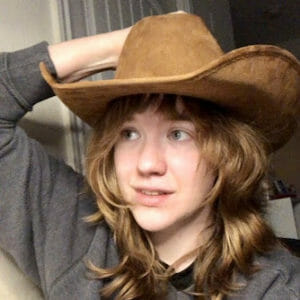
I don’t know about you, but when I start learning a new skill, I want to know everything about it right away. How do I get started? What do I need to get started? How could this new skill transform my life?
Being an incessant researcher of new pastimes, I love a good master post. So, I’ve made one today for one of my favorite things in the world: creative writing .
I wrote this for people who are just getting into creative writing, but even if you’ve been writing for a while, stay tuned—some of the tricks and resources in this post will be helpful for you, too.
Need A Fiction Book Outline?
What is creative writing?
Creative writing examples, how to start creative writing, creative writing prompts, creative writing jobs, creative writing degrees, online creative writing courses.
Creative writing is imaginative writing. It’s meant to entertain its readers and get some emotional response from them. You’ll note that I said imaginative , but I didn’t say fictional writing, because while fiction is a subcategory of creative writing, it doesn’t define creative writing. All fiction is creative writing, but not all creative writing is fiction.
While technical, legal, or academic writing might be focused on conveying information in the most efficient and clear manner possible, the goal of creative writing is slightly different. You still want to communicate effectively and clearly, but you also want to put some pep in there. Creative writing uses tools like metaphor and imagery to evoke an image, emotion, or both from the reader.
Another way to look at it: if you were to say what makes creative writing distinct as a form, you could say it’s the artsy one.
Creative writing covers more than just fiction, or even just novels . Here’s a quick rundown of some types of creative writing you might encounter.
Novels (which fall under the ‘fiction’ umbrella) are a type of creative writing where the reader follows a character or characters through a plot. A novel might be a standalone, or it might be part of a series.
Example: Parable of the Sower by Octavia Butler
2. Short Stories
Short stories (which also fall under the ‘fiction’ umbrella) follow a character through a plot, like you’d see in a novel, but short stories are, well, shorter. Generally, short stories run between 1,000 and 10,000 words, with works under 1,000 words falling under the subcategory ‘flash fiction.’
Example: The Yellow Wallpaper by Charlotte Perkins Gilman
Poetry is a form of writing which focuses heavily on imagery, metaphor, symbolism, and other figurative tools. It also involves a lot of technical work with form; meter and rhythm are commonly used to enhance meaning. You can generally tell what poems are by looking at them, since they’re usually divided into groups of lines (stanzas) instead of paragraphs, like you might see in other forms of creative writing.
Example: Little Beast by Richard Siken
Related: Where to Publish Poetry
Plays are written for the stage. They include stage direction, brief scene descriptions, and character dialogue, but there’s often not a lot of prose. Plays are intended to be watched by an audience instead of read, so whatever prose exists, it is intended for the people participating in the play.
Example: Hamlet by Shakespeare
Songs are similar to poetry in terms of their structure and use of figurative language, but songs are meant to be performed. People don’t generally read song lyrics without listening to it, and the instrumentation and production often enhance the meaning of a song. Songwriters also use music theory to play with meaning—at a basic level, for example, minor chords generally convey sadness, while major chords generally convey happiness.
Example: Let it Be by the Beatles
6. Memoirs & Personal Essays
Memoirs and personal essays are a form of creative writing where an author draws on their real lived experience to create a narrative. Memoir specifically sometimes plays with chronological order and specific technical fact in favor of symbolic resonance—the author is getting at an emotional truth rather than a literal or objective truth.
Example: Me Talk Pretty One Day by David Sedaris
7. Journaling
Not everyone uses journaling as a creative writing exercise—some people want to log their daily activities and be done with it—but if you’ve ever poured your heart out about a breakup to the nonjudgmental pages of a notebook, you’ve probably already done some creative writing!
Want to find more examples? I wrote on this topic for another site, and it includes even more examples of creative writing for you to try.
Now that you know what creative writing looks like, let’s talk about how to get started, even if you’ve never practiced creative writing before.
1. Try stuff on until something fits
Take a look at the list above (or do a Google search for ‘types of creative writing’ and see if there’s anything else you might be interested in—I won’t be offended) and pick one that seems fun. If you want to try, for example, a screenplay, but you’re not sure how to write one, read a bunch. Get a feel for how they work.
Maybe you do that and decide you don't want to write screenplays after all. Okay! Try short stories. Try poetry. Try songwriting. Practicing different forms will make you a more well-rounded writer in the long run, and you might be surprised at what resonates with you.
2. Practice, practice, practice
Once you’ve found a form or a few forms that suit you, your job as a newbie is simple: practice. Write whatever you want as often as you can and, if possible, for your eyes only. Create a relationship between yourself and your craft.
Some say you should start with short stories before jumping into novels so you can practice completing narrative arcs. That might work great! But if you hate writing short stories, just practice with writing novels.
If you have an idea that feels a little too advanced for you, that’s probably what you should be working on, since it’ll teach you a lot about the craft along the way. Don’t be intimidated, and don’t worry about anyone else’s opinions (this includes any fretting about publishing). Your singular goal here is to create, and your secondary goal is to challenge yourself.
3. Join some kind of writerly group
But hold on, you might be thinking. How do I know I’m not getting worse the more I practice? How do I know I’m not just churning out garbage?
At some point, especially if your goal is to publish , you’ll want feedback on your work. And while it’s important to have the support of your loved ones, it’s also important to get feedback from other writers.
I do not recommend sending your very first manuscript to an editor or well-established writer for feedback—their feedback, generally aimed at moderate to advanced writers, is probably going to devastate you at the fledgling stage. I do recommend finding other writers at approximately your skill level to bounce ideas off of and exchange critiques. These other writers can be found online or at local writing circles—check your local public library for creative writing workshops.
Have you picked out a form of creative writing to try, but you just can’t come up with any ideas? Try using a creative writing prompt to get those creative gears turning. These are totally for you to use however is most helpful: use the prompt as-is, tweak it a little, whatever works.
Prompts are a great way to explore different types of tones in writing and hone your own personal style as an author!
Use this FREE tool: Writing Prompts Generator
Looking to make some money with your creative writing endeavors? Here’s a few options to kickstart your job search:
Ghostwriting
As a ghostwriter, your job is to write the story your client assigns you . This might be a fictional novel, or it might be a memoir. The client often has specific requests for content, length, and so on. The catch? Your name is not on the book. You’re not allowed to say that you wrote it—the client’s name or pen name usually goes on the author line. You can find ghostwriting gigs on sites like Upwork or Fiverr.
Marketing does involve some technical elements like copywriting, but creative writers have a place in marketing, too. Brands need catchy slogans, funny commercials, and even social media gurus to run entertaining Twitter accounts. For more ideas on how to market your upcoming book , check out our post on the topic.
Columnist/Blog Writer
You can also look for work as an op-ed columnist or blog writer. This might be something you do for an existing website, or it might be a blog you start from scratch on Wix, SquareSpace, or Tumblr.
You might have heard of people getting creative writing degrees, or at least you might have heard some of the discourse surrounding these degrees. Off the bat, I want to say that you don’t need a creative writing degree to be a writer. It doesn’t make you a ‘real’ writer, and it doesn’t indicate your seriousness toward the craft.
If you do want to get a creative writing degree, though, you’re looking (broadly) at two options:
Undergraduate writing programs
This is your BFA in creative writing. Not all colleges offer them—many (like my alma mater) offer a creative writing concentration or focus as part of an English degree. So you might graduate, hypothetically, for example, with a degree in English with a concentration in creative writing. Some colleges don’t offer a major, but they do offer minors.
Check to see what sorts of courses your college or prospective college offers. Do you have to be an English major to take their creative writing course? Does their creative writing course offer guidance in the type of creative writing you want to pursue? For example, my alma mater offered a creative writing concentration with two tracks, one for fiction and one for poetry. There was also a separate film studies concentration for aspiring screenplay writers and film students.
Graduate writing programs (a.k.a., the MFA)
MFA programs can be extremely competitive and prohibitively expensive, not to mention that you’re obviously not guaranteed to come out of them a better writer. They can be a great tool, but they’re not a necessary one. Look at it this way: are you willing to get this MFA if it means you might come out of it without a successfully published novel? If so, proceed.
If you want to pursue an MFA, do your research. Don’t go straight for the Iowa Writers Workshop application page and hope for the best—investigate the universities that look appealing to you, see if your interests align with theirs, and make that application fee count.
Going to college isn’t the only way to take classes on creative writing! If you’re looking for more cost-friendly options, the Internet is your friend. I’ve linked to a few places loaded with creative writing courses to get you started.
1. Intelligent.com: The Best 10 Online Creative Writing Courses
2. Coursera: Best Creative Writing Courses and Certifications
3. Self-Publishing School: Best Self-Publishing Courses
4. Our Programs: Fiction Write Your Book Program
Are you ready to try an online creative writing course? Are you ready to start some creative writing prompts? Or, are you think you're ready to go for a full creative writing project of your own? Here is a resource to help you get started:

What is a Biography? Definition, Elements, and More
Editorial, Writing
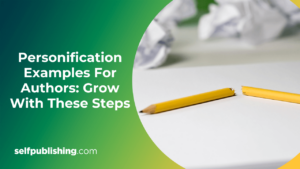
25 Personification Examples for Writers: What It Is & How to Use It
Fiction, Learning, Writing
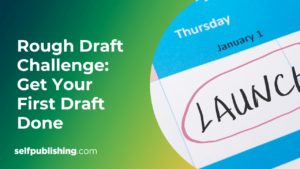
5 Tips For Mastering Your Rough Draft
Join the community.
Join 100,000 other aspiring authors who receive weekly emails from us to help them reach their author dreams. Get the latest product updates, company news, and special offers delivered right to your inbox.
Last places remaining for June 30th, July 14th and July 28th courses . Enrol now and join students from 175 countries for the summer of a lifetime
- What Is Creative Writing? The ULTIMATE Guide!

At Oxford Royale Academy, we offer a range of summer school programmes that have become extremely popular amongst students of all ages. The subject of creative writing continues to intrigue many academics as it can help to develop a range of skills that will benefit you throughout your career and life.
Nevertheless, that initial question is one that continues to linger and be asked time and time again: what is creative writing? More specifically, what does it mean or encompass? How does creative writing differ from other styles of writing?
During our Oxford Summer School programme , we will provide you with in-depth an immersive educational experience on campus in the colleges of the best university in the world. However, in this guide, we want to provide a detailed analysis of everything to do with creative writing, helping you understand more about what it is and why it could benefit you to become a creative writer.
The best place to start is with a definition.
What is creative writing?
The dictionary definition of creative writing is that it is original writing that expresses ideas and thoughts in an imaginative way. [1] Some academics will also define it as the art of making things up, but both of these definitions are too simplistic in the grand scheme of things.
It’s challenging to settle on a concrete definition as creative writing can relate to so many different things and formats. Naturally, as the name suggests, it is all built around the idea of being creative or imaginative. It’s to do with using your brain and your own thoughts to create writing that goes outside the realms of what’s expected. This type of writing tends to be more unique as it comes from a personal place. Each individual has their own level of creativity, combined with their own thoughts and views on different things. Therefore, you can conjure up your own text and stories that could be completely different from others.
Understanding creative writing can be challenging when viewed on its own. Consequently, the best way to truly understand this medium is by exploring the other main forms of writing. From here, we can compare and contrast them with the art of creative writing, making it easier to find a definition or separate this form of writing from others.
What are the main forms of writing?
In modern society, we can identify five main types of writing styles [1] that will be used throughout daily life and a plethora of careers:
- Narrative Writing
- Descriptive Writing
- Persuasive Writing
- Expository Writing
- Creative Writing
Narrative writing refers to storytelling in its most basic form. Traditionally, this involves telling a story about a character and walking the readers through the journey they go on. It can be a long novel or a short story that’s only a few hundred words long. There are no rules on length, and it can be completely true or a work of fiction.
A fundamental aspect of narrative writing that makes it different from other forms is that it should includes the key elements of storytelling. As per UX Planet, there are seven core elements of a good story or narrative [2] : the plot, characters, theme, dialogue, melody, decor and spectacle. Narrative writing will include all of these elements to take the ready on a journey that starts at the beginning, has a middle point, but always comes to a conclusion. This style of writing is typically used when writing stories, presenting anecdotes about your life, creating presentations or speeches and for some academic essays.
Descriptive writing, on the other hand, is more focused on the details. When this type of writing is used, it’s focused on capturing the reader’s attention and making them feel like they are part of the story. You want them to live and feel every element of a scene, so they can close their eyes and be whisked away to whatever place or setting you describe.
In many ways, descriptive writing is writing as an art form. Good writers can be given a blank canvas, using their words to paint a picture for the audience. There’s a firm focus on the five senses all humans have; sight, smell, touch, sound and taste. Descriptive writing touches on all of these senses to tell the reader everything they need to know and imagine about a particular scene.
This is also a style of writing that makes good use of both similes and metaphors. A simile is used to describe something as something else, while a metaphor is used to show that something is something else. There’s a subtle difference between the two, but they both aid descriptive writing immensely. According to many writing experts, similes and metaphors allow an author to emphasise, exaggerate, and add interest to a story to create a more vivid picture for the reader [3] .
Looking at persuasive writing and we have a form of writing that’s all about making yourself heard. You have an opinion that you want to get across to the reader, convincing them of it. The key is to persuade others to think differently, often helping them broaden their mind or see things from another point of view. This is often confused with something called opinionative writing, which is all about providing your opinions. While the two seem similar, the key difference is that persuasive writing is built around the idea of submitting evidence and backing your thoughts up. It’s not as simple as stating your opinion for other to read; no, you want to persuade them that your thoughts are worth listening to and perhaps worth acting on.
This style of writing is commonly used journalistically in news articles and other pieces designed to shine a light on certain issues or opinions. It is also typically backed up with statistical evidence to give more weight to your opinions and can be a very technical form of writing that’s not overly emotional.
Expository writing is more focused on teaching readers new things. If we look at its name, we can take the word exposure from it. According to Merriam-Webster [4] , one of the many definitions of exposure is to reveal something to others or present them with something they otherwise didn’t know. In terms of writing, it can refer to the act of revealing new information to others or exposing them to new ideas.
Effectively, expository writing focuses on the goal of leaving the reader with new knowledge of a certain topic or subject. Again, it is predominately seen in journalistic formats, such as explainer articles or ‘how-to’ blogs. Furthermore, you also come across it in academic textbooks or business writing.
This brings us back to the centre of attention for this guide: what is creative writing?
Interestingly, creative writing is often seen as the style of writing that combines many of these forms together in one go. Narrative writing can be seen as creative writing as you are coming up with a story to keep readers engaged, telling a tale for them to enjoy or learn from. Descriptive writing is very much a key part of creative writing as you are using your imagination and creative skills to come up with detailed descriptions that transport the reader out of their home and into a different place.
Creative writing can even use persuasive writing styles in some formats. Many writers will combine persuasive writing with a narrative structure to come up with a creative way of telling a story to educate readers and provide new opinions for them to view or be convinced of. Expository writing can also be involved here, using creativity and your imagination to answer questions or provide advice to the reader.
Essentially, creative writing can combine other writing types to create a unique and new way of telling a story or producing content. At the same time, it can include absolutely none of the other forms at all. The whole purpose of creative writing is to think outside the box and stray from traditional structures and norms. Fundamentally, we can say there are no real rules when it comes to creative writing, which is what makes it different from the other writing styles discussed above.
What is the purpose of creative writing?
Another way to understand and explore the idea of creative writing is to look at its purpose. What is the aim of most creative works of writing? What do they hope to provide the reader with?
We can look at the words of Bryanna Licciardi, an experienced creative writing tutor, to understand the purpose of creative writing. She writes that the primary purpose is to entertain and share human experiences, like love or loss. Writers attempt to reveal the truth with regard to humanity through poetics and storytelling. [5] She also goes on to add that the first step of creative writing is to use one’s imagination.
When students sign up to our creative writing courses, we will teach them how to write with this purpose. Your goal is to create stories or writing for readers that entertain them while also providing information that can have an impact on their lives. It’s about influencing readers through creative storytelling that calls upon your imagination and uses the thoughts inside your head. The deeper you dive into the art of creative writing, the more complex it can be. This is largely because it can be expressed in so many different formats. When you think of creative writing, your instinct takes you to stories and novels. Indeed, these are both key forms of creative writing that we see all the time. However, there are many other forms of creative writing that are expressed throughout the world.
What are the different forms of creative writing?
Looking back at the original and simple definition of creative writing, it relates to original writing in a creative and imaginative way. Consequently, this can span across so many genres and types of writing that differ greatly from one another. This section will explore and analyse the different types of creative writing, displaying just how diverse this writing style can be – while also showcasing just what you’re capable of when you learn how to be a creative writer.
The majority of students will first come across creative writing in the form of essays . The point of an essay is to present a coherent argument in response to a stimulus or question. [6] In essence, you are persuading the reader that your answer to the question is correct. Thus, creative writing is required to get your point across as coherently as possible, while also using great descriptive writing skills to paint the right message for the reader.
Moreover, essays can include personal essays – such as writing a cover letter for work or a university application. Here, great creativity is needed to almost write a story about yourself that captivates the reader and takes them on a journey with you. Excellent imagination and persuasive writing skills can help you tell your story and persuade those reading that you are the right person for the job or university place.
Arguably, this is the most common way in which creative writing is expressed. Fictional work includes novels, novellas, short stories – and anything else that is made up. The very definition of fiction by the Cambridge Dictionary states that it is the type of book or story that is written about imaginary characters and events not based on real people and facts. [7] As such, it means that your imagination is called upon to create something out of nothing. It is a quintessential test of your creative writing skills, meaning you need to come up with characters, settings, plots, descriptions and so much more.
Fictional creative writing in itself takes on many different forms and can be completely different depending on the writer. That is the real beauty of creative writing; you can have entirely different stories and characters from two different writers. Just look at the vast collection of fictional work around you today; it’s the perfect way to see just how versatile creative writing can be depending on the writer.
Similarly, scripts can be a type of creative writing that appeals to many. Technically, a script can be considered a work of fiction. Nevertheless, it depends on the script in question. Scripts for fictional television shows, plays or movies are obviously works of fiction. You, the writer, has come up with the characters and story of the show/play/movie, bringing it all to life through the script. But, scripts can also be non-fictional. Creating a play or movie that adapts real-life events will mean you need to write a script based on something that genuinely happened.
Here, it’s a perfect test of creative writing skills as you take a real event and use your creative talents to make it more interesting. The plot and narrative may already be there for you, so it’s a case of using your descriptive writing skills to really sell it to others and keep readers – or viewers – on the edge of their seats.
A speech is definitely a work of creative writing. The aim of a speech can vary depending on what type of speech it is. A politician delivering a speech in the House of Commons will want to get a point across to persuade others in the room. They’ll need to use creative writing to captivate their audience and have them hanging on their every word. A recent example of a great speech was the one by Sir David Attenborough at the recent COP26 global climate summit. [8] Listening to the speech is a brilliant way of understanding how creative writing can help get points across. His speech went viral around the world because of how electrifying and enthralling it is. The use of many descriptive and persuasive words had people hanging onto everything he said. He really created a picture and an image for people to see, convincing them that the time is now to work on stopping and reversing climate change.
From this speech to a completely different one, you can see creative writing at play for speeches at weddings and other jovial events. Here, the purpose is more to entertain guests and make them laugh. At the same time, someone giving a wedding speech will hope to create a lovely story for the guests to enjoy, displaying the true love that the married couple share for one another. Regardless of what type of speech an individual is giving, creative writing skills are required for it to be good and captivating.
Poetry & Songs
The final example of creative writing is twofold; poetry and songs. Both of these formats are similar to one another, relying on creativity to deliver a combination of things. Poetry can take so many forms and styles, but it aims to inspire readers and get them thinking. Poems often have hidden meanings behind them, and it takes a great deal of imagination and creativity to come up with these meanings while also creating a powerful poem. Some argue that poetry is the most creative of all creative writing forms.
Songwriting is similar in that you use creativity to come up with lyrics that can have powerful meanings while also conjuring up a story for people. The best songwriters will use lyrics that stay in people’s minds and get them thinking about the meaning behind the song. If you lack imagination and creativity, you will never be a good songwriter.
In truth, there are so many other types and examples of creative writing that you can explore. The ones listed above are the most common and powerful, and they all do a great job of demonstrating how diverse creative writing can be. If you can hone your skills in creative writing, it opens up many opportunities for you in life. Primarily, creative writing focuses on fictional pieces of work, but as you can see, non-fiction also requires a good deal of creativity.
What’s needed to make a piece of creative writing?
Our in-depth analysis of creative writing has led to a point where you’re aware of this style of writing and its purpose, along with some examples of it in the real world. The next question to delve into is what do you need to do to make a piece of creative writing. To phrase this another way; how do you write something that comes under the creative heading rather than another form of writing?
There is an element of difficulty in answering this question as creative writing has so many different types and genres. Consequently, there isn’t a set recipe for the perfect piece of creative writing, and that’s what makes this format so enjoyable and unique. Nevertheless, we can discover some crucial elements or principles that will help make a piece of writing as creative and imaginative as possible:
A target audience
All creative works will begin by defining a target audience. There are many ways to define a target audience, with some writers suggesting that you think about who is most likely to read your work. However, this can still be challenging as you’re unsure of the correct demographic to target. Writer’s Digest makes a good point of defining your target audience by considering your main motivation for writing in the first place. [9] It’s a case of considering what made you want to start writing – whether it’s a blog post, novel, song, poem, speech, etc. Figuring out your motivation behind it will help you zero in on your target audience.
Defining your audience is vital for creative writing as it helps you know exactly what to write and how to write it. All of your work should appeal to this audience and be written in a way that they can engage with. As a simple example, authors that write children’s stories will adapt their writing to appeal to the younger audience. Their stories include lots of descriptions and words that children understand, rather than being full of long words and overly academic writing.
Establishing the audience lets the writer know which direction to take things in. As a result, this can aid with things like character choices, plot, storylines, settings, and much more.
A story of sorts
Furthermore, great works of creative writing will always include a story of sorts. This is obvious for works such as novels, short stories, scripts, etc. However, even for things like poems, songs or speeches, a story helps make it creative. It gives the audience something to follow, helping them make sense of the work. Even if you’re giving a speech, setting a story can help you create a scene in people’s minds that makes them connect to what you’re saying. It’s a very effective way of persuading others and presenting different views for people to consider.
Moreover, consider the definition of a story/narrative arc. One definition describes it as a term that describes a story’s full progression. It visually evokes the idea that every story has a relatively calm beginning, a middle where tension, character conflict and narrative momentum builds to a peak and an end where the conflict is resolved. [10]
Simplifying this, we can say that all works of creative writing need a general beginning, middle and end. It’s a way of bringing some sort of structure to your writing so you know where you are going, rather than filling it with fluff or waffle.
A good imagination
Imagination is a buzzword that we’ve used plenty of times throughout this deep dive into creative writing. Every creative writing course you go on will spend a lot of time focusing on the idea of using your imagination. The human brain is a marvellously powerful thing that holds the key to creative freedom and expressing yourself in new and unique ways. If you want to make something creative, you need to tap into your imagination.
People use their imagination in different ways; some will be able to conjure up ideas for stories or worlds that exist beyond our own. Others will use theirs to think of ways of describing things in a more creative and imaginative way. Ultimately, a good imagination is what sets your work apart from others within your genre. This doesn’t mean you need to come up with the most fantastical novel of all time to have something classified as creative writing. No, using your imagination and creativity can extend to something as simple as your writing style.
Ultimately, it’s more about using your imagination to find your own personal flair and creative style. You will then be able to write unique pieces that stand out from the others and keep audiences engaged.
How can creative writing skills benefit you?
When most individuals or students consider creative writing, they imagine a world where they are writing stories for a living. There’s a common misconception that creative writing skills are only beneficial for people pursuing careers in scriptwriting, storytelling, etc. Realistically, enhancing ones creative writing skills can open up many windows of opportunity throughout your education and career.
- Improve essay writing – Naturally, creative writing forms a core part of essays and other written assignments in school and university. Improving your skills in this department can help a student get better at writing powerful essays and achieving top marks. In turn, this can impact your career by helping you get better grades to access better jobs in the future.
- Become a journalist – Journalists depend on creative writing to make stories that capture audiences and have people hanging on their every word. You need high levels of creativity to turn a news story into something people are keen to read or watch.
- Start a blog – In modern times, blogging is a useful tool that can help people find profitable and successful careers. The whole purpose of a blog is to provide your opinions to the masses while also entertaining, informing and educating. Again, having a firm grasp of creative writing skills will aid you in building your blog audience.
- Write marketing content – From advert scripts to content on websites, marketing is fuelled by creative writing. The best marketers will have creative writing skills to draw an audience in and convince them to buy products. If you can learn to get people hanging on your every word, you can make it in this industry.
These points all demonstrate the different ways in which creative writing can impact your life and alter your career. In terms of general career skills, this is one that you simply cannot go without.
How to improve your creative writing
One final part of this analysis of creative writing is to look at how students can improve. It begins by reading as much as you can and taking in lots of different content. Read books, poems, scripts, articles, blogs – anything you can find. Listen to music and pay attention to the words people use and the structure of their writing. It can help you pick up on things like metaphors, similes, and how to use your imagination. Of course, writing is the key to improving; the more you write, the more creative you can get as you will start unlocking the powers of your brain.
Conclusion: What is creative writing
In conclusion, creative writing uses a mixture of different types of writing to create stories that stray from traditional structures and norms. It revolves around the idea of using your imagination to find a writing style that suits you and gets your points across to an audience, keeping them engaged in everything you say. From novels to speeches, there are many forms of creative writing that can help you in numerous career paths throughout your life.
[1] SkillShare: The 5 Types of Writing Styles with Examples
[2] Elements of Good Story Telling – UX Planet
[3] Simile vs Metaphor: What’s the Difference? – ProWritingAid
[4] Definition of Exposure by Merriam-Webster
[5] The Higher Purpose of Creative Writing | by Terveen Gill
[6] Essay purpose – Western Sydney University
[7] FICTION | meaning in the Cambridge English Dictionary
[8] ‘Not fear, but hope’ – Attenborough speech in full – BBC News
[9] Writer’s Digest: Who Is Your Target Reader?
[10] What is a Narrative Arc? • A Guide to Storytelling Structure

14 Types of Creative Writing
by Melissa Donovan | Apr 6, 2021 | Creative Writing | 20 comments
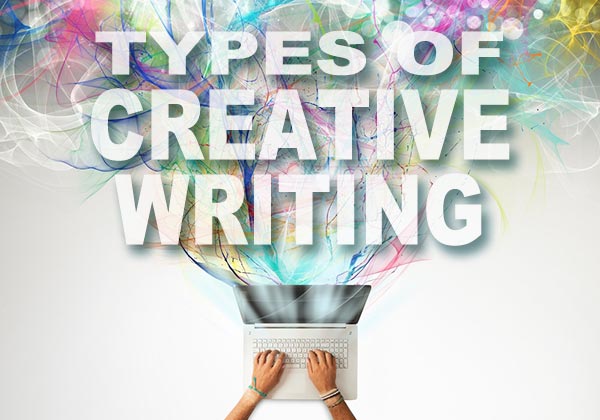
Which types of creative writing have you tried?
When we talk about creative writing, fiction and poetry often take the spotlight, but there are many other types of creative writing that we can explore.
Most writers develop a preference for one form (and genre) above all others. This can be a good thing, because you can specialize in your form and genre and become quite proficient. However, occasionally working with other types of writing is beneficial. It prevents your work from becoming stale and overladen with form- or genre-specific clichés, and it’s a good way to acquire a variety of techniques that are uncommon in your preferred form and genre but that can be used to enhance it.
Let’s look at some different types of creative writing. As you read through the list, note the types of writing you’ve experimented with and the types you’d like to try.
Types of Creative Writing
Free writing: Open a notebook or an electronic document and just start writing. Allow strange words and images to find their way to the page. Anything goes! Also called stream-of-consciousness writing, free writing is the pinnacle of creative writing.
Journals: A journal is any written log. You could keep a gratitude journal, a memory journal, a dream journal, or a goals journal. Many writers keep idea journals or all-purpose omni-journals that can be used for everything from daily free writes to brainstorming and project planning.
Diaries: A diary is a type of journal in which you write about your daily life. Some diaries are written in letter format (“Dear Diary…”). If you ever want to write a memoir, then it’s a good idea to start keeping a diary.
Letters: Because the ability to communicate effectively is increasingly valuable, letter writing is a useful skill. There is a long tradition of publishing letters, so take extra care with those emails you’re shooting off to friends, family, and business associates. Hot tip: one way to get published if you don’t have a lot of clips and credits is to write letters to the editor of a news publication.
Memoir: A genre of creative nonfiction , memoirs are books that contain personal accounts (or stories) that focus on specific experiences. For example, one might write a travel memoir.
Essays. Essays are often associated with academic writing, but there are many types of essays, including personal essays, descriptive essays, and persuasive essays, all of which can be quite creative (and not especially academic).
Journalism: Some forms of journalism are more creative than others. Traditionally, journalism was objective reporting on facts, people, and events. Today, journalists often infuse their writing with opinion and storytelling to make their pieces more compelling or convincing.
Poetry: Poetry is a popular but under-appreciated type of writing, and it’s easily the most artistic form of writing. You can write form poetry, free-form poetry, and prose poetry.
Song Lyrics: Song lyrics combine the craft of writing with the artistry of music. Composing lyrics is similar to writing poetry, and this is an ideal type of writing for anyone who can play a musical instrument.
Scripts: Hit the screen or the stage by writing scripts for film, television, theater, or video games. Beware: film is a director’s medium, not a writer’s medium, but movies have the potential to reach a non-reading audience.
Storytelling: Storytelling is the most popular form of creative writing and is found in the realms of both fiction and nonfiction writing. Popular forms of fiction include flash fiction, short stories, novellas, and full-length novels; and there are tons of genres to choose from. True stories, which are usually firsthand or secondhand accounts of real people and events, can be found in essays, diaries, memoirs, speeches, and more. Storytelling is a tremendously valuable skill, as it can be found in all other forms of writing, from poetry to speech writing.
Speeches: Whether persuasive, inspirational, or informative, speech writing can lead to interesting career opportunities in almost any field or industry. Also, speech-writing skills will come in handy if you’re ever asked to write and deliver a speech at an important event, such as a graduation, wedding, or award ceremony.
Vignettes: A vignette is defined as “a brief evocative description, account, or episode.” Vignettes can be poems, stories, descriptions, personal accounts…anything goes really. The key is that a vignette is extremely short — just a quick snippet.
Honorable Mention: Blogs. A blog is not a type of writing; it’s a publishing platform — a piece of technology that displays web-based content on an electronic device. A blog can be used to publish any type of writing. Most blogs feature articles and essays, but you can also find blogs that contain diaries or journals, poetry, fiction, journalism, and more.
Which of these types of creative writing have you tried? Are there any forms of writing on this list that you’d like to experiment with? Can you think of any other types of creative writing to add to this list? Share your thoughts by leaving a comment, and keep writing.

20 Comments
What is “flash” writing or stories.
Flash fiction refers to super short stories, a few hundred words or fewer.
its very helpful especially to those students like me who wasn’t capable or good in doing a creative writing
I’m glad you found this post helpful, Elena.
I also found this to be very helpful, especially because I don’t do very well at writing.
Thanks for letting me know you found this helpful. Like anything else, writing improves with practice.
Thank you Melissa. It’s very helpful!
You’re welcome!
Over all good list. Yes blogs can be publishing platforms but only if something is written first. I read what you wrote on a blog.
Thanks a lot Good job
Are these types of creaitve writing the same or different if I need to teach children’s creative writing? Can you recommend a website to teach these?
Hi Marie. Thanks for your question. I’ve come across many websites for teaching children’s creative writing. I recommend a search on Google, which will lead you to a ton of resources.
these are very helpful when it comes to getting in college or essays or just to improve my writing
Thanks, Donte. I’m glad you found this helpful.
Free writing really helps me get going. For some reason my prose are much better when I am not beholden to an overall plot or narrative with specific defined characters. I like to free writer “excerpts” on theprose.com. It allows me to practice writing and receive feedback at the same time. I am also trying to blog about writing my first novel, both for writing practice and to keep myself accountable. It really helps!
I feel the same way. Free writing is always a fun and creative experience for me.
Was trying to give an inservice on writing skills and the different types of writing.
Your wok here really helped. Thanks.
You’re welcome.
Hi, Melissa can you assist me ? I’m trying to improve my writing skills as quickly as possible. Plz send me some more tips and trick to improve my writing and communication skills.
You are welcome to peruse this website, which is packed with tips for improving your writing. I’d recommend focusing on the categories Better Writing and Writing Tips for writing improvement. You can also subscribe to get new articles send directly to your email. Thanks!
Trackbacks/Pingbacks
- 23 Calming Hobbies to Restore Your Energy | NunziaDreams - […] You can do a lot with creative writing. […]
Submit a Comment Cancel reply
Your email address will not be published. Required fields are marked *
This site uses Akismet to reduce spam. Learn how your comment data is processed .

Subscribe and get The Writer’s Creed graphic e-booklet, plus a weekly digest with the latest articles on writing, as well as special offers and exclusive content.

Recent Posts
- Poetry Writing Exercises to Engage the Senses
- Tips for Developing Story Writing Ideas
- Reading, Writing, and Reviewing Good Poems
- Consuming Art to Fuel Your Writing
- How to Improve Your Writing
Write on, shine on!
Pin It on Pinterest

Creative Writing 101
You love to write and have been told you have a way with words. So you’ve decided to give writing a try—creative writing.
Problem is, you’re finding it tougher than it looks.
You may even have a great story idea , but you’re not sure how to turn it into something people will read.
Don’t be discouraged—writing a compelling story can be grueling, even for veterans. Conflicting advice online may confuse you and make you want to quit before you start.
But you know more than you think. Stories saturate our lives.
We tell and hear stories every day in music, on television, in video games, in books, in movies, even in relationships.
Most stories, regardless the genre, feature a main character who wants something.
There’s a need, a goal, some sort of effort to get that something.
The character begins an adventure, a journey, or a quest, faces obstacles, and is ultimately transformed.
The work of developing such a story will come. But first, let’s look at the basics.
- What is Creative Writing?
It’s prose (fiction or nonfiction) that tells a story.
Journalistic, academic, technical writing relays facts.
Creative writing can also educate, but it’s best when it also entertains and emotionally moves the reader.
It triggers the imagination and appeals to the heart.
- Elements of Creative Writing

Writing a story is much like building a house.
You may have all the right tools and design ideas, but if your foundation isn’t solid, even the most beautiful structure won’t stand.
Most storytelling experts agree, these 7 key elements must exist in a story.
Plot (more on that below) is what happens in a story. Theme is why it happens.
Before you begin writing, determine why you want to tell your story.
- What message do you wish to convey?
- What will it teach the reader?
Resist the urge to explicitly state your theme. Just tell the story, and let it make its own point.
Give your readers credit. Subtly weave your theme into the story and trust them to get it.
They may remember a great plot, but you want them thinking about your theme long after they’ve finished reading.
2. Characters
Every story needs believable characters who feel knowable.
In fiction, your main character is the protagonist, also known as the lead or hero/heroine.
The protagonist must have:
- redeemable flaws
- potentially heroic qualities that emerge in the climax
- a character arc (he must be different, better, stronger by the end)
Resist the temptation to create a perfect lead. Perfect is boring. (Even Indiana Jones suffered a snake phobia.)
You also need an antagonist, the villain , who should be every bit as formidable and compelling as your hero.
Don’t make your bad guy bad just because he’s the bad guy. Make him a worthy foe by giving him motives for his actions.
Villains don’t see themselves as bad. They think they’re right! A fully rounded bad guy is much more realistic and memorable.
Depending on the length of your story , you may also need important orbital cast members.
For each character, ask:
- What do they want?
- What or who is keeping them from getting it?
- What will they do about it?
The more challenges your characters face, the more relatable they are.
Much as in real life, the toughest challenges result in the most transformation.
Setting may include a location, time, or era, but it should also include how things look, smell, taste, feel, and sound.
Thoroughly research details about your setting so it informs your writing, but use those details as seasoning, not the main course. The main course is the story.
But, beware.
Agents and acquisitions editors tell me one of the biggest mistakes beginning writers make is feeling they must begin by describing the setting.
That’s important, don’t get me wrong. But a sure way to put readers to sleep is to promise a thrilling story on the cover—only to start with some variation of:
The house sat in a deep wood surrounded by…
Rather than describing your setting, subtly layer it into the story.
Show readers your setting. Don’t tell them. Description as a separate element slows your story to crawl.
By layering in what things look and feel and sound like you subtly register the setting in the theater of readers’ minds.
While they concentrating on the action, the dialogue , the tension , the drama, and conflict that keep them turning the pages, they’re also getting a look and feel for your setting.
4. Point of View
POV is more than which voice you choose to tell your story: First Person ( I, me ), Second Person ( you, your ), or Third Person ( he, she, or it ).
Determine your perspective (POV) character for each scene—the one who serves as your camera and recorder—by deciding who has the most at stake. Who’s story is this?
The cardinal rule is that you’re limited to one perspective character per scene, but I prefer only one per chapter, and ideally one per novel.
Readers experience everything in your story from this character’s perspective.
For a more in-depth explanation of Voice and POV, read A Writer’s Guide to Point of View .
This is the sequence of events that make up a story —in short, what happens. It either compels your reader to keep turning pages or set the book aside.
A successful story answers:
- What happens? (Plot)
- What does it mean? (Theme: see above)
Writing coaches call various story structures by different names, but they’re all largely similar. All such structures include some variation of:
- An Inciting Incident that changes everything
- A series of Crises that build tension
- A Resolution (or Conclusion)
How effectively you create drama, intrigue, conflict, and tension, determines whether you can grab readers from the start and keep them to the end.
6. Conflict
This is the engine of fiction and crucial to effective nonfiction as well.
Readers crave conflict and what results from it.
If everything in your plot is going well and everyone is agreeing, you’ll quickly bore your reader—the cardinal sin of writing.
If two characters are chatting amiably and the scene feels flat (which it will), inject conflict. Have one say something that makes the other storm out, revealing a deep-seated rift.
Readers will stay with you to find out what it’s all about.
7. Resolution
Whether you’re an Outliner or a Pantser like me (one who writes by the seat of your pants), you must have an idea where your story is going.
How you expect the story to end should inform every scene and chapter. It may change, evolve, and grow as you and your characters do, but never leave it to chance.
Keep your lead character center stage to the very end. Everything he learns through all the complications you plunged him into should, in the end, allow him to rise to the occasion and succeed.
If you get near the end and something’s missing, don’t rush it. Give your ending a few days, even a few weeks if necessary.
Read through everything you’ve written. Take a long walk. Think about it. Sleep on it. Jot notes. Let your subconscious work. Play what-if games. Reach for the heart, and deliver a satisfying ending that resonates .
Give your readers a payoff for their investment by making it unforgettable.
- Creative Writing Examples
- Short Story
- Narrative nonfiction
- Autobiography
- Song lyrics
- Screenwriting
- Playwriting
- Creative Writing Tips
In How to Write a Novel , I cover each step of the writing process:
- Come up with a great story idea .
- Determine whether you’re an Outliner or a Pantser.
- Create an unforgettable main character.
- Expand your idea into a plot.
- Do your research.
- Choose your Voice and Point of View.
- Start in medias res (in the midst of things).
- Intensify your main character’s problems.
- Make the predicament appear hopeless.
- Bring it all to a climax.
- Leave readers wholly satisfied.
- More to Think About
1. Carry a writing pad, electronic or otherwise. I like the famous Moleskine™ notebook .
Ideas can come at any moment. Record ideas for:
- Anything that might expand your story
2. Start small.
Take time to build your craft and hone your skills on smaller projects before you try to write a book .
Journal. Write a newsletter. Start a blog. Write short stories . Submit articles to magazines, newspapers, or e-zines.
Take a night school or online course in journalism or creative writing. Attend a writers conference.
3. Throw perfection to the wind.
Separate your writing from your editing .
Anytime you’re writing a first draft, take off your perfectionist cap. You can return to editor mode to your heart’s content while revising, but for now, just write the story.
Separate these tasks and watch your daily production soar.
- Time to Get to Work
Few pleasures in life compare to getting lost in a great story.
Learn how to write creatively, and the characters you birth have the potential to live in hearts for years.
- 1. Carry a writing pad, electronic or otherwise. I like the famous Moleskine™ notebook.

Are You Making This #1 Amateur Writing Mistake?

Faith-Based Words and Phrases

What You and I Can Learn From Patricia Raybon

Before you go, be sure to grab my FREE guide:
How to Write a Book: Everything You Need to Know in 20 Steps
Just tell me where to send it:

Enter your email to instantly access my ultimate guide:
How to write a novel: a 12-step guide.
8 Creative Writing Examples That Will Spark Your Writing Genius
Jane Ng • 15 November, 2023 • 9 min read
Looking for some creative writing examples to ignite your imagination? You’ve come to the right place! Whether you’re an aspiring writer searching for inspiration, or a student aiming to enhance your creative writing skills, we’ve got you covered. In this blog post, we’ll provide creative writing examples, explore different styles, and techniques, and showcase some truly inspiring pieces.
So, let’s begin our adventure into the world of creativity and expression.
Table Of Contents
What is creative writing.
- Types of Creative Writing Styles
Key Takeaways
- FAQs About Creative Writing Examples
More Tips with AhaSlides
- Six Thinking Hats
- What is Systems Thinking?
Looking for Creative Presentations?
Gather your team members by an interactive quiz on AhaSlides. Sign up to take free quiz from AhaSlides template library!
Creative writing is the art of using words to express thoughts, ideas, and emotions in imaginative and unique ways. It’s a writing form that goes beyond the technical and conventional aspects of writing like grammar and structure, focusing instead on capturing the essence of storytelling and personal expression.
In creative writing, writers have the freedom to invent characters, settings, and plots, allowing their creativity to flow without the constraints of strict rules or guidelines. This form of writing can take various forms, including short stories, poetry, novels, plays, and more which we’ll explore in the next section.

Types Of Creative Writing Styles
Creative writing encompasses a variety of styles, each with its unique characteristics and purposes. Here are some common types of creative writing styles:
- Fiction: Storytelling with invented characters, plots, and settings across genres like mystery, romance, science fiction, fantasy, flash fiction and literary fiction.
- Poetry: Expressive writing using rhyme, meter, and figurative language to convey emotions and imagery, including forms like sonnets, haikus, and free verse.
- Drama/Playwriting: Crafting scripts for theatrical performances, incorporating dialogue, stage directions, and character development for stage productions.
- Creative Nonfiction: Merging facts with narrative storytelling techniques to create engaging personal essays, memoirs, and travel writing.
- Screenwriting: Developing scripts for movies and television, adhering to a specific format, and including scenes, dialogues, and camera directions.
- Short Stories: Concise narratives exploring single themes with well-developed characters and plots within a limited word count.
- Blogging: Creating conversational and relatable content, combining personal experiences, opinions, and information, covering a wide range of topics and formats.
- Songwriting: Crafting lyrics and melodies to convey emotions and stories through music, blending language with melody in a unique creative form.
1/ Flash Fiction – Short Creative Writing Examples:
Ernest Hemingway’s Six-Word Story:
“ For sale: baby shoes, never worn. “
This poignant six-word story is often attributed to Hemingway, although its true authorship is debated. Regardless, it showcases the power of flash fiction to convey a complete narrative with just a handful of words. In this case, it tells a heartbreaking story of loss and unfulfilled hopes in a remarkably concise manner.
2/ GCSE Creative Writing Examples:
Here’s a GCSE (General Certificate of Secondary Education) creative writing example. GCSE creative writing tasks often require students to demonstrate their ability to craft engaging narratives.
Task: The Unexpected Visitor
“Imagine you are at home alone on a rainy evening. Your parents are out, and you’re engrossed in a book. Suddenly, there’s a knock at the door. You weren’t expecting anyone, and the hour is late. Write a short story (around 300-400 words) about what happens next.”
3/ Haiku Poetry – Creative Writing Examples:
Haikus are a traditional form of Japanese poetry known for their brevity and focus on nature and the changing seasons. Each haiku typically consists of three lines with a syllable pattern of 5-7-5, making them a concise yet evocative form of creative expression.
Matsuo Basho (1644-1694):
“An old silent pond…
A frog jumps into the pond—
Splash! Silence again.”

4/ Screen Writing – Creative Writing Examples:
Screenwriting is a unique form of creative writing that brings stories to life on big and small screens. Here are a few famous examples of screenwriting from iconic films and TV series:
1/ Movie – “Get Out” (2017) Script – Written by Jordan Peele:
Jordan Peele’s screenplay combines horror and social commentary, making “Get Out” a thought-provoking and chilling cinematic experience.
2/ TV Series – “Breaking Bad” (2008-2013) – Created by Vince Gilligan:
Vince Gilligan’s screenplay for “Breaking Bad” masterfully portrays the transformation of a high school chemistry teacher, Walter White, into a drug lord. The series is celebrated for its character development and moral ambiguity.
5/ Playwriting – Creative Writing Examples:
These plays represent a diverse range of styles and themes within the world of playwriting. They have had a significant impact on the theater and continue to be performed and studied worldwide.
1/ “Romeo and Juliet” by William Shakespeare:
This timeless tragedy explores themes of love and conflict between the Montagues and the Capulets. It’s one of Shakespeare’s most famous plays, known for its poetic language and unforgettable characters.
2/ “Death of a Salesman” by Arthur Miller:
Arthur Miller’s classic play delves into the American Dream and the disillusionment of a traveling salesman named Willy Loman. It’s celebrated for its exploration of the human condition and the pursuit of success.


6/ Personal Essay – Creative Writing Examples:
Personal essay examples showcase how writers can draw from their own life experiences to create engaging narratives that resonate with readers.
1/ “A Journey to Self-Discovery”
In this personal essay, the author reflects on a transformative backpacking trip through the mountains. They recount the physical and emotional challenges faced during the journey and how these challenges ultimately led to profound self-discovery and growth. The essay explores themes of resilience, introspection, and the power of nature to inspire personal change.
2/ “Lessons from My Grandmother’s Kitchen”
This personal essay takes readers into the author’s childhood memories of spending time with their grandmother in the kitchen. Through vivid descriptions of cooking rituals and family gatherings, the author reflects on the valuable life lessons and cultural heritage passed down through generations. The essay touches on themes of family, tradition, and the importance of preserving cultural identity.
7/ Blogging – Creative Writing Examples:
Here are a few famous examples of blogs known for their creative and engaging writing styles:
1/ Wait But Why by Tim Urban:
Wait But Why is known for its in-depth articles and entertaining infographics that explore a wide range of topics, from science and technology to philosophy and human behavior.
2/ Cup of Jo by Joanna Goddard:
Cup of Jo is a lifestyle blog that features thoughtful and relatable content on relationships, parenting, travel, and more. Joanna Goddard’s writing style is warm and inviting.
8/ Songwriting – Creative Writing Examples:
Here are three famous examples of songwriting known for their creative and impactful lyrics:
1/ “Bohemian Rhapsody” by Queen:
Queen’s epic and operatic “Bohemian Rhapsody” features intricate lyrics that tell a complex narrative and create a timeless rock masterpiece.
2/ “Yesterday” by The Beatles:
“Yesterday” by The Beatles is a classic ballad with introspective lyrics that explore themes of nostalgia and lost love.
3/ “What’s Going On” by Marvin Gaye:
Marvin Gaye’s “What’s Going On” is a socially conscious song with lyrics that address issues like war, racism, and environmental concerns.
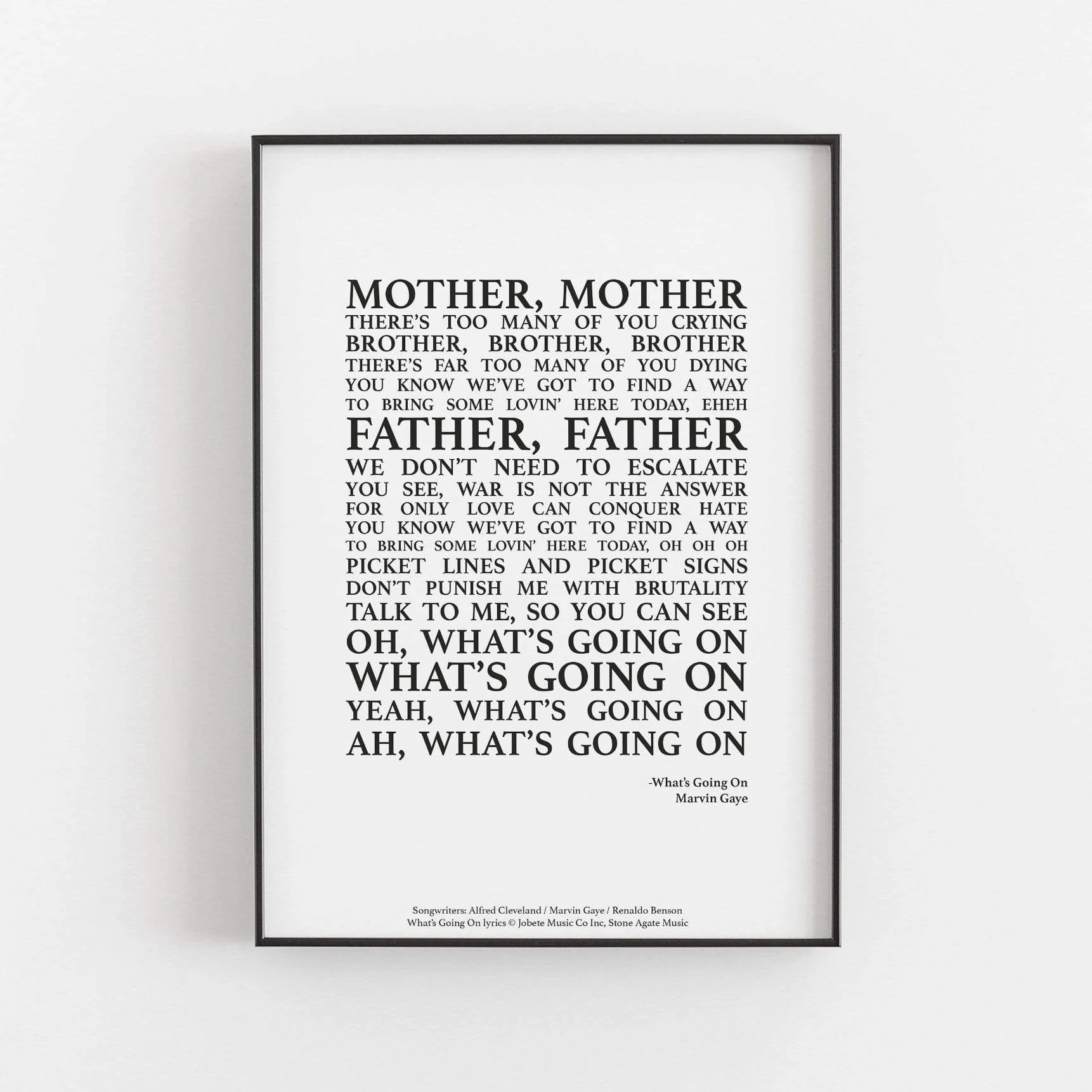
Through the power of words, writers can transport readers to distant worlds, evoke deep emotions, and share profound insights. Throughout this exploration of creative writing examples, we’ve witnessed the diverse tapestry of possibilities, from captivating personal essays to timeless poetry, from gripping screenplays to enchanting song lyrics.
Whether you’re a seasoned writer or just starting your creative journey, the key lies in unlocking your imagination and letting your ideas flow freely. So don’t forget that AhaSlides provides a dynamic platform for creative writing, offering interactive features that can enhance your storytelling. Whether you’re crafting a captivating presentation, conducting a workshop, or seeking feedback on your work, AhaSlides empowers you to engage with your audience in new and exciting ways.
FAQs About Creative Writing Examples
What is a good example of creative writing.
One famous example of creative writing is the opening paragraph of Charles Dickens’ novel “ A Tale of Two Cities “: “It was the best of times, it was the worst of times, it was the age of wisdom, it was the age of foolishness, it was the epoch of belief, it was the epoch of incredulity, it was the season of Light, it was the season of Darkness, it was the spring of hope, it was the winter of despair, we had everything before us, we had nothing before us, we were all going direct to Heaven, we were all going direct the other way—in short, the period was so far like the present period, that some of its noisiest authorities insisted on its being received, for good or for evil, in the superlative degree of comparison only.”
Is a verse example of creative writing?
Ref: Study.com

A writer who wants to create practical and valuable content for the audience
Tips to Engage with Polls & Trivia
More from AhaSlides

BloomTech’s Downfall: A Long Time Coming
Your source for the latest news and trends in online education.
600 Free Google Certifications
Most common
Popular subjects.
Digital Marketing
Web Development
Microsoft Excel
Popular courses
Mindfulness for Wellbeing and Peak Performance
Food as Medicine
Tsinghua Chinese: Start Talking with 1.3 Billion People
Class Central
- classcentral.com
- Browse Courses
- Write a Review
- About Class Central
- Best Courses
- Free Certificates
- Best Free Online Courses of All Time
- Most Popular Online Courses of All Time
- Featured Articles
- Online Learning Guides
- Student Voices
Disclosure: Class Central is learner-supported. When you buy through links on our site, we may earn an affiliate commission.
10 Best Creative Writing Courses for 2024: Craft Authentic Stories
Learn how to tell your story and engage your readers with great storytelling.
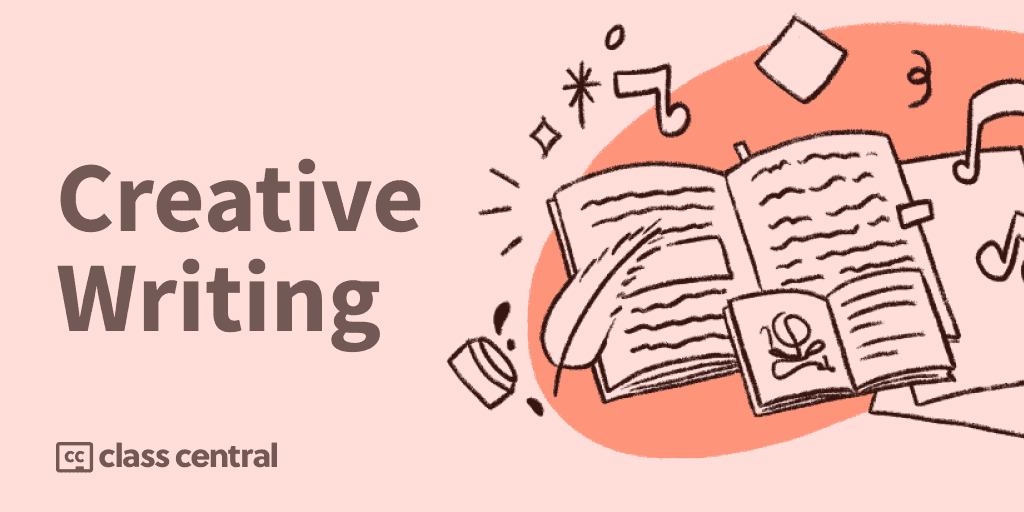
As a lifelong literature enthusiast, I decided to challenge myself in 2010 by participating in NaNoWriMo (National Novel Writing Month), which tasks participants with writing a 50,000-word draft within a month. Although I’ve only achieved this goal twice since then, the experience has been invaluable. I’ve connected with a wonderful community of writers, both online and in person.
Through my experience, I can confidently say that creative writing is a skill that can be developed and honed, just like any other. While traditionally associated with literature, creative writing is increasingly being recognized as a powerful tool in various forms of writing, from copywriting and storytelling to novels and poetry. It has the ability to captivate readers and elevate the impact of written expression.

If you’re searching for the best online Creative Writing courses and resources, you’ve come to the right place. This Best Courses Guide (BCG) is built from Class Central’s catalog of over 300 Creative Writing courses and selected according to a methodology that you can check below.
Click on the shortcuts for more details:
What is Creative Writing?
Courses overview, why you should trust us, how we made our picks and tested them, here are our top picks.
Click on one to skip to the course details:
| 15 hours | |
| 5-6 hours | |
| 4-5 hours | |
| 12 hours | |
| 1-2 hours | |
| 2 hours | |
| 5-6 hours | |
| 1-2 hours | |
| 1 hour | |
| 18 hours | |
| NA |

Related Guides
- Copywriting
- Content Marketing
- 2D Animation
- Digital Art
Special Picks
- Fashion Design
- Music Theory
- Emotional Intelligence
Trending Guides
- Design Thinking
- Graphic Design
- American Sign Language (ASL)
Creative writing is a genre of writing that seeks to evoke emotions and feelings in its readers. It surpasses the limits of traditional forms of literature and emphasizes narrative craft, character development, and the use of literary tropes and poetic traditions. Creative writing finds application in various forms of writing, including screenplays, plays, novels, poems, and other written works. In this guide, I will delve into some of its most popular facets.
Enhancing resilience and creativity through writing
Research shows that the brains of professional writers work differently from those of novice writers. Moreover, creative writing has been found to boost resilience in students . If you want to enjoy the benefits of writing, it’s important to develop the habit of jotting down your thoughts and words. Doing so can help you overcome writer’s block.
Creative writing is so powerful that it’s used in prisons to give inmates a chance to express themselves in programs like PEN America . “By providing resources, mentorship, and audiences outside the walls, we help these writers to join and enrich the broader literary community.”
Creative writing is a skill that can be learned and practiced like any other. Techniques such as ABDCE structure, 1st or 3rd person point of view, “show don’t tell”, dialogues, and tropes can be easily learned through the online courses in this guide.
- Together, they account for over 1M enrollments
- Skillshare, with 2 courses, is the most featured provider
- The single most popular course has nearly 400k enrollments
- Three courses are entirely free or free-to-audit.
Best Fantasy And Short-Stories Writing Lessons For Beginners (Brandon Sanderson)
Besides being an awesome writer, Sanderson is an instructor with a very unique talent for keeping us engaged. He has also made available a full course in creative writing on YouTube , originally presented at Brigham Young University, which includes the most crucial tools for any beginner or even experienced writers. The course is comprehensive and rich in content, with great sound and video quality.
Each video discusses a specific tool or technique, so you can easily select the theme you want to explore next or watch it all in sequence. It’s up to you. I recommend you take your time, watch one video at a time and experiment with each concept, or even better, find a writing buddy or form a group to practice writing together.
What you’ll learn:
- Plot construction, character development, and engaging storytelling
- Techniques for crafting immersive worlds and believable viewpoints
- Insights into the publishing industry, tailored for emerging writers
- Strategies for writing compelling short stories and leveraging them for larger projects.
“Very informative! I’m a beginner writer looking to study writing for video games, and this class gave me a lot of helpful tools to start understanding how stories work/how to organize my ideas! Will definitely be returning to some of these lectures in the future for guidance 👍” – Paige Webster
| Brigham Young University | |
| Youtube | |
| Brandon Sanderson | |
| Beginner | |
| 15 hours | |
| 1.8M | |
| 5/5 (6 reviews) | |
| None |
Best University-level Creative Writing Course (Wesleyan University)

Creative Writing by Wesleyan University is a specialization for those looking for a way to improve their writing structure, scene and character creations and finding your style. Each course includes writing practice (for paying learners) and insightful interviews. It’s worth your time and effort if you are a disorganized writer like myself.
- Techniques for crafting a bracing story with memorable characters and an interesting setting
- How to employ a fresh descriptive style in your writing
- Skills for analyzing and constructively evaluating peer writing
- The ability to refine your writing, critique writing in general, and draw inspiration from existing literature
- The process of drafting, rewriting, and completing an original story in the genre of your choosing.
It should be noted that the peer-grading system often lacks depth. However, the assignments are well-crafted and can be easily evaluated with minimal effort, providing some insights from other participants in the form of feedback or inspiration from their submissions.
“Great information about plot and scene structure. The information about revision was entirely new to me – thank you! The exercises were good and difficult in a good way that helped me hone my writing.” – Laura B, Coursera learner
| Wesleyan University | |
| Coursera | |
| Brando Skyhorse, Amity Gaige, Amy Bloom and Salvatore Scibona | |
| Beginner | |
| 40 hours | |
| 126K | |
| 4.7 (5K) | |
| Yes, paid |
Best Course to Find Your Voice (Neil Gaiman)
Neil Gaiman is currently one the most prolific writers I know of: he’s written books , comics , movies and even TV shows . Even if you’re not a fan of his style, there is definitely something you can learn from him.
In Neil Gaiman Teaches The Art Of Storytelling you will discover Neil’s philosophy on what drives a story and learn to unlock new stories within yourself.
While MasterClass doesn’t sell single courses, a subscription provides access to their entire library, including other writing courses like Margaret Atwood Teaches Creative Writing , Dan Brown Teaches Writing Thrillers , Malcolm Gladwell Teaches Writing , and James Patterson Teaches Writing . If you are considering the purchase, you should definitely enjoy the rest of their catalog.
By the end of this course, you will be able to:
- Discover and develop your unique writing voice
- Generate and develop original ideas
- Create dynamic, well-rounded characters that come to life on the page.
This course includes a 94-page workbook that includes assignments and supplemental material.
| MasterClass | |
| Neil Gaiman | |
| Beginner | |
| 4-5 hours worth of lectures | |
| Paid Certificate Available |
Best Practical Writing Course With Support (Trace Crawford)
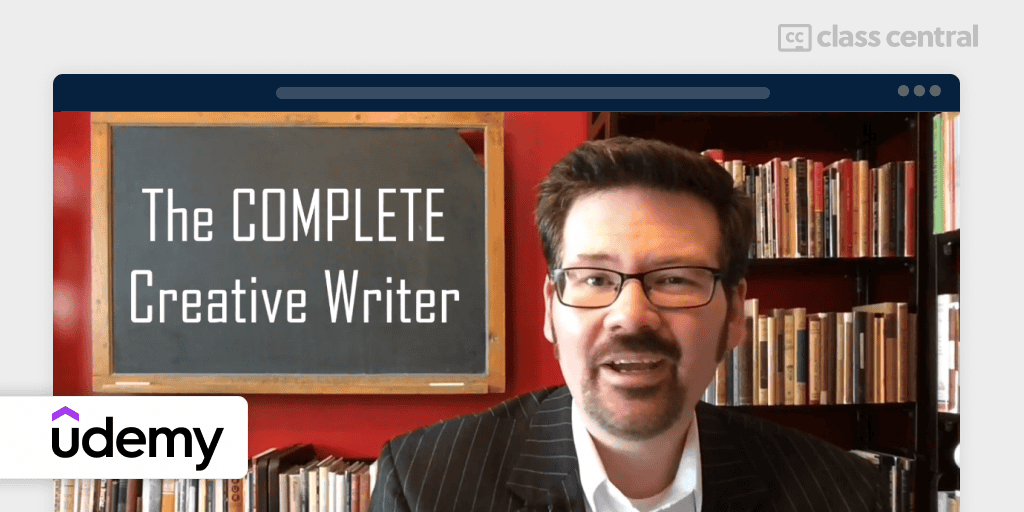
I love it when a passionate teacher like Trace Crawford puts the effort into creating a comprehensive curriculum. COMPLETE Creative Writing – All Genres is a 12-hour course with 145 downloadable resources. In this course, you will learn how to write engaging fiction, poetry, drama, and creative non-fiction, helping you become the successful writer you want to be.
- The four genres of creative writing: fiction, poetry, drama, and creative non-fiction
- How to discover, refine, and share your unique writing voice
- A series of authentic writing assignments designed to target the skills you need to develop
- Writing techniques, literary devices, and specialized skills to enhance your writing
- Opportunities for publishing, podcasts, and how to create a professional creative writing portfolio
- Discover multiple public outlets to share your writing with others as you gain confidence and experience success in your writing ability.
This is a practical creative writing course that includes assignments reviewed by the instructor, though response time may vary.
“The short snippets of theory in combination with the short assignments suits my learning style. I don’t remember the last time I’ve written anything creative, but this course gave me the incentive to set some foundation and its actually quite enjoyable if you stick to it.” – Nikolaos-Stylianos Z., Udemy learner
| Udemy | |
| Trace Crawford | |
| Beginner | |
| 12 hours | |
| 37 quizzes and writing practice | |
| 31K | |
| 4.7 (3.9K) | |
| Available, paid |
Best Course to Overcome Writer’s Block: 10-Day Journaling Challenge (Emily Gould)

I couldn’t resist adding Creative Writing for All: A 10-Day Journaling Challenge to this guide. Emily Gould is a delightful instructor, and her approach to inviting you to participate in the challenge is impossible to decline. It’s the perfect course to overcome writer’s block, which is exactly what she proposes. In this 10-day creative writing challenge, filled with inspiring examples, observation prompts, and clever revision tricks, writers and enthusiasts will be able to express their creativity in a personal and artful way.
This course is the shortest one on the list, and it’s more about the challenge of keeping a journal. If you decide to subscribe to Skillshare, you can also enjoy their entire library of courses. In addition to the other two recommended courses on this list, you can also check out these other Skillshare courses: Writing Suspense: How to Write Stories That Thrill in Any Genre and The Writer’s Toolkit: 6 Steps to a Successful Writing Habit .
| Skillshare | |
| Emily Gould | |
| Beginner | |
| 26 min | |
| 58K | |
| 99% (1K) | |
| Available, paid |
Best Course to Create Fiction From Personal Experience (Shaun Levin)

Shaun’s approach to writing in Short Story Writing: Create Fiction from Personal Experience is an unusual one. It draws from your personal experience to create a compelling fictional story. I can say from experience that this technique will help you write with more depth and authenticity. Every time we bring our own life to the story, it becomes alive, believable and relatable. In a way, all fictional stories are based on the author’s life.
This course will help you with techniques and a series of practical exercises to start writing your scenes from a more philosophical point of view, creating compelling stories. You’ll learn how to delve into your imagination to find everything you’ll need to become a prolific writer, no matter where you are.
By the end of the course, you will have a final project that will receive feedback from Shaun and other learners as well. Actually, if you want to check it out, in the course page on Domestika you can open the submitted projects and read the comments.
Shaun’s other courses: Creative Writing for Beginners: Bringing Your Story to Life .
“A practical course. Shaun Levin talks about theory but also demonstrates his process, which was invaluable. The exercises got my creative juices flowing. Thinking about doing his other course in the future.” – Maya Dicheva
| Domestika | |
| Shaun Levin | |
| Beginner | |
| 2 hours | |
| 30K | |
| 99% (764) | |
| Available, paid |
Best Course to Make Writing Less Stressful with Best Practices (Jennie Nash)
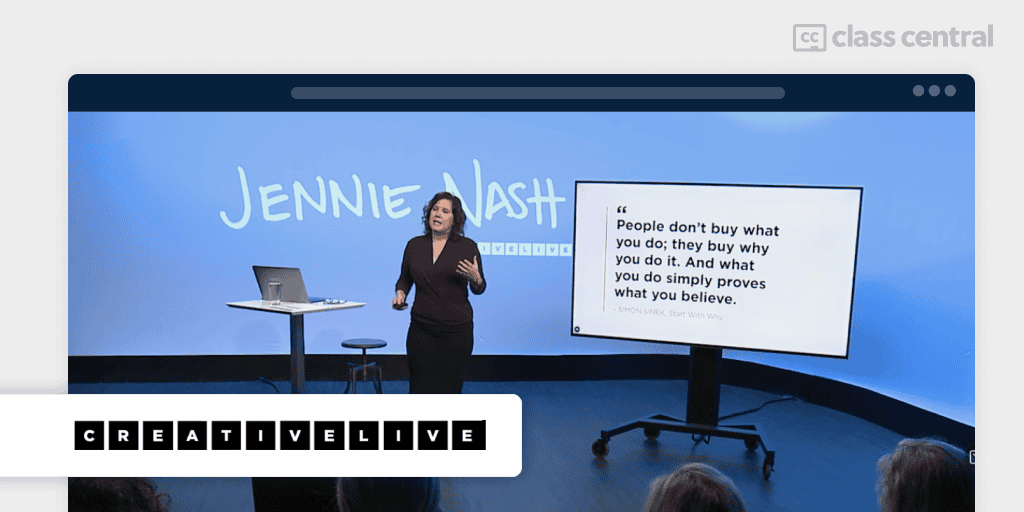
If you struggle to start or get stuck in your writing, Write Your Book: Start Strong and Get It Done can help. With good advice and emotional support, you’ll learn techniques to make writing less stressful. The accompanying workbook guides you to think methodically by asking the right questions to keep you focused on your story and not chasing your own tail.
In this class, you’ll learn how to:
- Design every element of your novel or memoir, including the protagonist, plot, story structure and a project success plan
- Define your narrator’s voice
- Determine where your story begins and where it ends
- Decide what point you’re making about human nature
- Make sure you’re giving your ideal reader exactly what they want
- Gain the confidence you need to push past any doubts and finish your book.
This course is more of a masterclass, so there are no assignments included but it teaches good practices and provides a very useful workbook.
| CreativeLive | |
| Jennie Nash | |
| Beginner | |
| 5-6 hours | |
| 18.8K | |
| 100% (29) | |
| None |
Best Course to Create A Compelling Story (Lisa Cron)
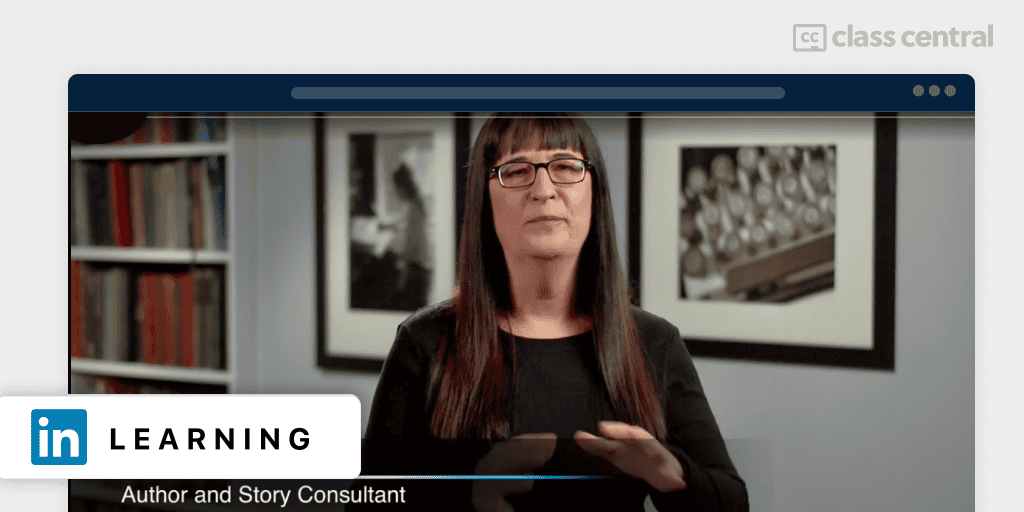
Writing: The Craft of Story is a series of well-produced lectures covering the basic building blocks of a story. Taught by author Lisa Cron, you will learn how to create compelling stories based on the way the brain responds to storytelling. This course emphasizes the importance of capturing the reader’s attention through techniques such as suspense, exploring the protagonist’s inner issues and dreams, specificity, and cause and effect. Upon completion of the quizzes, you will receive a certificate for your LinkedIn profile. Additionally, you can watch all the videos without subscribing to the course.
“Learning the fundamentals of crafting a story was and is a fascinating experience. And yes, I would highly recommend writing to anyone interested in learning how to express the communication of feeling.” – Nicole Gillard, LinkedIn learner.
| LinkedIn Learning | |
| Lisa Cron | |
| Beginner | |
| 1-2 hours worth of material | |
| 100K | |
| 4.7 (649) | |
| Available, paid |
Best Course to Write Personal Essays with Impact (Roxane Gay)

Discover the art of crafting powerful personal essays with best-selling author Roxane Gay in her course, Creative Writing: Crafting Personal Essays with Impact . Through her honest and thoughtful approach, Roxane will help you find your story, craft your truth, and write to make a difference.
This master class offers eight video lessons that are filled with practical guidance, actionable tactics, and example essays to guide you from the first idea to a final, publication-ready work.
You’ll learn how to:
- Find a specific purpose for telling your story
- Connect your work to larger conversations and timely themes
- Conduct crucial research to support your work
- Navigate personal memories to write your truth
- Write and revise your final work, and submit your work for publication.
Additionally, the class provides a downloadable worksheet to support your ongoing creative nonfiction writing practice, as well as links to additional resources.
If you enjoy creative nonfiction writing, you might consider this course that’s also on Skillshare: Creative Nonfiction: Write Truth with Style (Skillshare Original) by Susan Orlean
| Skillshare | |
| Roxane Gay | |
| Beginner | |
| 1 hour | |
| 45K | |
| 100% (1.2K) | |
| Available, paid. |
Best Course to Develop Your Ideas And Research for Characters (The Open University)
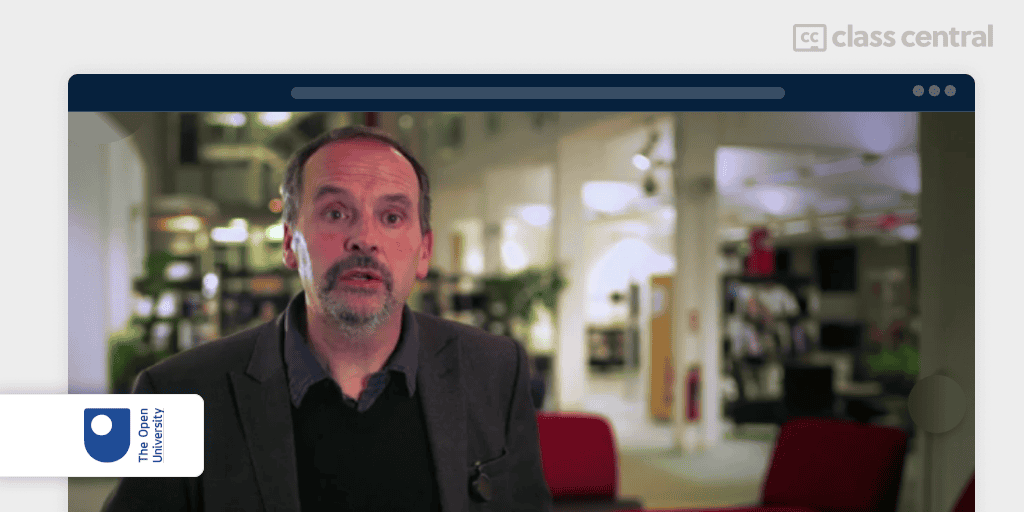
Start Writing Fiction explores the writing process, from journaling and idea development to reflection and editing. It features insights from established writers such as Louis de Bernières, Patricia Duncker, Alex Garland, Abdulrazak Gurnah, Tim Pears, Michèle Roberts, and Monique Roffey, who share their approaches to research and turning events into plot. Led by Derek Neale, a novelist and short story writer, this course provides a comprehensive understanding of the writing rituals and techniques used by successful writers.
You’ll get to critique the work of other writers and receive feedback. This course is designed for individuals interested in starting or improving their fiction writing and does not require prior experience in the subject.
You’ll learn:
- Creation of characters in fiction
- Different sources and ways of presenting characters in stories
- Reading as a writer
- Writing practice including creativity, research, observation and editing
- Peer reviewing, workshops and the importance of feedback.
“This course takes learners through many aspects of writing such as developing characters, observing and describing details, finding inspiration, writing and editing. It includes some peer reviews which can be varying in quality. I was lucky enough to have some of my writing reviewed by a reviewer who gave very helpful and positive feedback.” – Pat Bowden
| The Open University | |
| Future Learn | |
| Derek Neale | |
| Beginner | |
| 24 hours | |
| 389,780 learners | |
| 4.7 (923) | |
| Available, paid |
What’s Next
Scribophile is one of the largest online writing communities. You can get feedback on your writing and join writing groups. If you decide to join with a free plan, you need to collect points by reviewing other writers’ work before submitting your own work for review. They also developed some advanced tools for evaluating work and guidelines to make sure you give/receive feedback that is actually meaningful.
NaNoWriMo started out as a month-long challenge where you invite your friends and join other writers in your region, be it online in their forums or in person, to challenge yourself in writing your first draft. Nowadays, they run all-year round writing challenges (but November is still the biggest one in terms of participation). What is cool about it is you actually get to meet people in real life with various writing skills and backgrounds. I was able to make some great friends over the years and even met a few professional writers that decided to join our local group just to support us.
If you have any resources you would like to have added here, leave a comment below.
Class Central , a Tripadvisor for online education, has helped 60 million learners find their next course. We’ve been combing through online education for more than a decade to aggregate a catalog of 200,000 online courses and 200,000 reviews written by our users. And we’re online learners ourselves: combined, the Class Central team has completed over 400 online courses, including online degrees.
Trying to find “the best” can be daunting, even for those of us who live and breathe online courses. Here’s how I approached this task.
First, I combed through Class Central’s Catalog and the internet to find a variety of free and paid open courses, some with certificates. You don’t need to enroll in a university to learn about creative writing.
When choosing courses, I considered the following factors:
- Renowned Institutions : I looked for recognized institutions in creative writing
- Instructor experience : I sought instructors with extensive experience in creative writing and engaging presentation styles
- Popularity : I checked numbers of enrollments and views to find popular courses
- Course content : I examined courses that covered a range of topics and presentation styles, including the basics and more advanced topics. I watched some course videos to sample courses I hadn’t already taken
- Learner reviews : I read learner reviews (when available) to get a sense of the quality of each course, leveraging the Class Central database with its thousands of course ratings and reviews written by our users as well as available course provider reviews.
Then, I defined the scope for these recommendations. A creative writing course can cover various topics, so I chose top courses from a range of sub-fields.
Ultimately, I used a combination of data and my own judgment to make these picks. I’m confident these recommendations will be a reliable way to learn about creative writing.
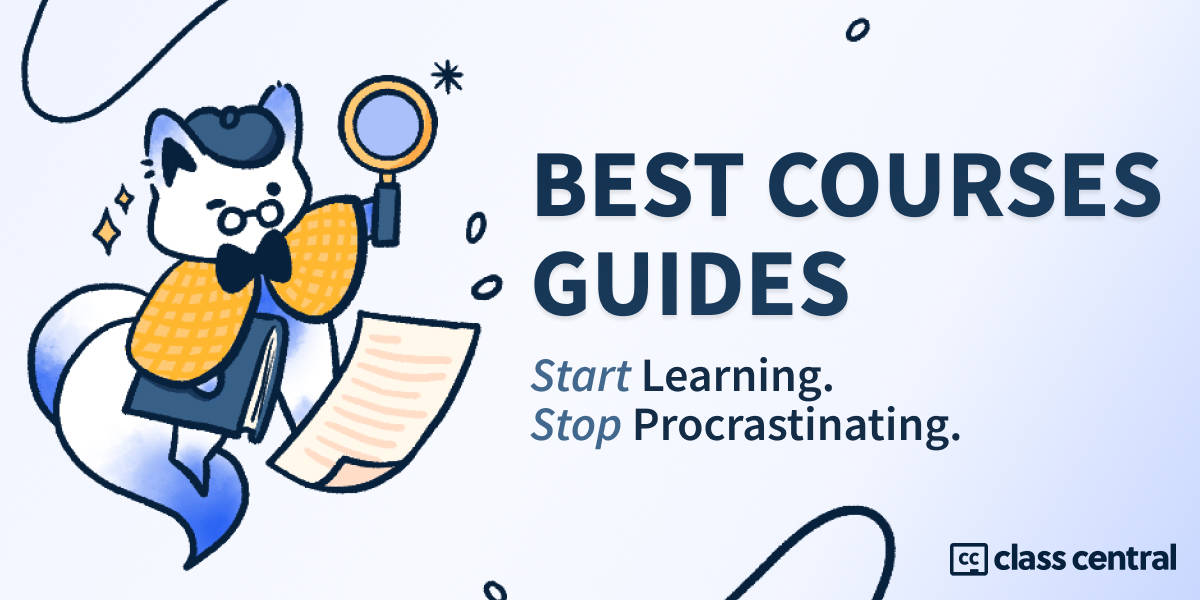
Fabio Dantas
Leave a reply.
This site uses Akismet to reduce spam. Learn how your comment data is processed .
Browse our catalog
Discover thousands of free online courses from top universities around the world like MIT, Stanford, and Harvard.
Computer Science 13,166 courses
- Artificial Intelligence
- Algorithms and Data Structures
- Internet of Things
- Information Technology
- Computer Networking
- Machine Learning
- Deep Learning
- Cryptography
- Quantum Computing
- Human-Computer Interaction (HCI)
- Distributed Systems
- Blockchain Development
- Operating Systems
- Computer Graphics
- Automata Theory
- Digital Image Processing
- CSS Animation
- Morph Transition
Business 21,416 courses
- Management & Leadership
- Entrepreneurship
- Strategic Management
- Industry Specific
- Business Intelligence
- Human Resources
- Project Management
- Business Software
- Customer Service
- Nonprofit Management
- Operations Management
- Corporate Governance
- Business Plan
- Business Proposal
- Management Consulting
- Business Math
Humanities 8,299 courses
- Language Learning
- Grammar & Writing
- Linguistics
- Library Science
- Crisis Management
- Emergency Management
- Language Arts
Data Science 4,788 courses
- Bioinformatics
- Data Mining
- Data Analysis
- Data Visualization
- Jupyter Notebooks
- Process Mining
- Text Mining
- Topological Data Analysis
Personal Development 5,702 courses
- Communication Skills
- Career Development
- Self Improvement
- Presentation Skills
- Self-Acceptance
- Mental Toughness
- Self-Doubt Management
- Personal Empowerment
- Habit Tracking
Art & Design 20,638 courses
- Digital Media
- Visual Arts
- Design & Creativity
- Art Therapy
- Art Composition
Purdue Online Writing Lab Purdue OWL® College of Liberal Arts
Welcome to the Purdue Online Writing Lab

Welcome to the Purdue OWL
This page is brought to you by the OWL at Purdue University. When printing this page, you must include the entire legal notice.
Copyright ©1995-2018 by The Writing Lab & The OWL at Purdue and Purdue University. All rights reserved. This material may not be published, reproduced, broadcast, rewritten, or redistributed without permission. Use of this site constitutes acceptance of our terms and conditions of fair use.
The Online Writing Lab (the Purdue OWL) at Purdue University houses writing resources and instructional material, and we provide these as a free service at Purdue. Students, members of the community, and users worldwide will find information to assist with many writing projects. Teachers and trainers may use this material for in-class and out-of-class instruction.
The On-Campus and Online versions of Purdue OWL assist clients in their development as writers—no matter what their skill level—with on-campus consultations, online participation, and community engagement. The Purdue OWL serves the Purdue West Lafayette and Indianapolis campuses and coordinates with local literacy initiatives. The Purdue OWL offers global support through online reference materials and services.
Social Media
Facebook twitter.
- Our Mission
Creative Writing in the Early Elementary Grades
A project that incorporates both standard and creative elements of storytelling can help young learners strengthen their literacy skills.

What can creative writing look, feel, and sound like in a first grade classroom? How can creative writing become a joyful and meaningful learning experience, and how can we educators facilitate the creative process and allow young writers to use their imagination when writing?
Graphic organizers, mind maps, and storyboards are certainly great tools for narrative building and planning, but they do not necessarily scaffold the creative process that story writing requires. In reality, they might even restrict students’ creativity while they “box” ideas in predetermined templates. This year, in my class, going play-based and hands-on has turned out to be a tremendous success.
Examining Elements of Creative Writing in First Grade
For this particular unit, my first grade students were examining literature and storytelling. After they had enjoyed several read-alouds, explored story elements, and studied the story mountain (beginning, rising action, conflict, resolution, and ending) as a team, it was time for them to write their very own stories.
They kicked off by creating their main character and decided on the character’s appearance, personality, likes, and dislikes. They also had the choice to play the main character role in the story. In both cases, while still brainstorming, it was time for action: They drew and decorated their characters with markers and pencils, cut them out, and used a Popsicle stick to make a puppet.
They became even more motivated to continue as they saw their characters come to life. My students spontaneously started interacting with each other and their puppets—creating stories and being imaginative—they went right into storytelling mode. This created the perfect opportunity for me to step back and observe my students’ initiative, creativity, and social and communication skills, not to mention their sense of accomplishment and joy.
Adding Artful Components to the Story
After they had engaged with their characters and interacted with others, it was time for the young writers to further develop their stories and think of a scenario leading to the rising action and resolution. This was the point when loose parts played a crucial role in the storytelling process. Counters, pipe cleaners, bits of paper, pebbles, dice, and buttons became houses, trees, magic wands, you name it. These bits and bobs from around the classroom became a valuable, zero-cost resource.
While students actively arranged and rearranged their chosen loose parts, they wondered about what would happen next in their stories. Unexpectedly, some students chose to collaborate and co-created stories by joining their imagination and characters in one story. In this step of the creative process, the use of loose parts was truly empowering: Before jotting anything down in their notebooks, my students physically, mentally, and verbally constructed their narratives and shared them with their partners.
Turning Ideas Into Words
With the mental representation of their narratives ready, it was all a matter of scribing their ideas. For that, we followed our usual class routines and resources such as word banks, sentence starters, and buddy support. All my students were engaged and confident, and when struggling with ideas, they resorted to loose parts again. As my first grade is a multicultural classroom, some of my students needed language support . However, with all of them hooked on their stories, supporting those who needed help with vocabulary, sentence construction, and spelling was simplified.
I conferred with students individually and in small groups to understand their thinking and offered feedback on paragraphing and some word choice. Instead of using notebooks for their first drafts, they chose to use mini-boards, which motivated them even more and supported them to make quick adjustments to their narratives. Finally, after receiving feedback, they moved on to writing their final drafts and designing their covers in order to turn their stories into books. Each student took their book home to share it with their family after reading it with the class.
Sharing Stories and Making Memorable Learning Experiences
What good is a book if it isn’t read and enjoyed? Buddy reading was the last step of the process but certainly not the least exciting. My students read aloud to each other, commenting on their favorite bits of the story and appreciating the illustrations. The whole project, from getting their characters ready to publishing and reading their books, took around five hours divided into five days.
When reflecting on the writing process, my students said that what they appreciated the most was the making of their puppets and illustrating their stories, highlighting the importance of integrating arts and writing. When asked about what was challenging, they replied that it was creating all the parts of the story mountain. However, they all said that using loose parts was a helpful strategy that they would use again—which they spontaneously have done in subsequent writing engagements. Lastly, when asked how they felt, some of the words they used were “proud,” “good,” and “joyful!”
A recent UNESCO report on the importance of happiness in learning refers to neuroscience research that proves our affective and cognitive domains are interconnected and interdependent. Therefore, emotions do affect learning! Joy is not a trade-off for academic achievement. Creating positive learning experiences makes learning stick.
Very often, students fear and avoid writing as a consequence of previous negative writing experiences. Combining art and a play-based approach to creative writing in first grade can set students on a path to success by building on their confidence, creativity, imagination, and sense of accomplishment. I have witnessed that the integration of art and writing has helped my students discover how writing can be a joyful and memorable experience where they can all be amazing storytellers and writers.
Filter by Keywords
50 Writing Prompts to Transform Your Creative Process at Work
Sudarshan Somanathan
Head of Content
June 15, 2024
Ever feel like your brain’s gone on vacation, leaving you staring at a blank page (or screen) in pure panic? We’ve all been there—alone in a room with a blank screen, the cursor blinking like a judgmental eye.
Today, we’re cracking open a treasure chest of inspiration: 50 thought-provoking prompts designed to increase your workplace creativity and transform your work process from ‘meh’ to ‘magnificent!’
Whether you’re crafting formal emails, brainstorming out-of-the-box marketing campaigns, or wrestling with a stubborn report, these prompts will get your creative juices flowing quickly.
We’re talking fresh ideas, unexpected angles, and a whole lot of ‘aha!’ moments.
Let’s also explore the diverse benefits of writing prompts in various professional contexts. And learn how to master the art of crafting your own prompts with some clever, cutting-edge tools.
Igniting your creativity at work
Building a routine of excellence, structuring successful narratives, tracking progress and staying accountable, reflecting, growing, and excelling, self-assessment and development writing prompt examples, industry and company knowledge writing prompt examples, communication and teamwork writing prompt examples, overall performance and impact writing prompt examples, decision-making and problem-solving writing prompt examples, be clear and concise, encourage critical thinking .
- Relate to the audience’s interests
Use open-ended questions
Leverage technology , lending more impact to your words with writing prompts.
The Benefits of Using Writing Prompts
Writing prompts do more than fill a page—they spark innovation, build solid writing habits, organize jumbled ideas into coherent sentences, uphold goals, and inspire deeper thinking.
Here’s how they make a meaningful positive impact:
Good writing prompts help break through the dreaded writer’s block or offer a new perspective on routine tasks.
For instance, a prompt like ‘Describe how an everyday object in your office could be improved’ can encourage team members to think innovatively and identify opportunities for enhancement that might otherwise be overlooked.
With regular use, prompts encourage cultivating a writing habit that can significantly improve communication skills and analytical thinking.
In a classroom setting, a teacher might use daily prompts such as ‘What is the most important thing you learned yesterday in school?’ or ‘Describe your favorite childhood memory or a funny story from your childhood’ to encourage students to start writing regularly, reinforcing valuable lessons, and ensuring continual improvement.
Journal writing prompts can serve as a framework for writers to build complete narratives, starting with a few words.
This is particularly beneficial in professional environments where structured thinking aids clarity and productivity.
For instance, prompts like ‘compare, explain, and contrast two characters from the novel you are reading’ help writers and students organize their thoughts systematically, leading to clearer and more detailed essays.
For individuals and teams, prompts can be a part of scheduled writing tasks that help keep participants accountable for their learning or professional goals.
They can be used as tools in performance evaluations or as part of professional development exercises.
A prompt like ‘draft a weekly progress update on your main project’ requires employees to regularly document and reflect on their achievements and challenges, maintaining responsibility and visibility within the team.
Reflection prompts encourage deeper thinking about personal experiences and work processes.
This can enhance self-awareness and professional growth, leading to better decision-making and more effective workplace interactions.
Prompts such as ‘reflect on a recent decision that did not go as planned and how you handled it’ can provide insights into personal and organizational resilience and adaptability, which are crucial for professional development.
50 Writing Prompts to Spark Creativity at Work
Here’s a list of diverse writing prompt examples to help you get started. You can use them as is, customize them, or take inspiration from them to build or expand your own prompts.
- Describe a project you’re working on and how you could improve it
- Write about a professional challenge you overcame recently
- What new skill would you like to learn at work and why?
- Reflect on the best piece of advice you’ve received in your career
- Imagine your ideal work day. What would it look like?
- How do you motivate yourself on challenging days?
- Write about how you handle feedback and criticism at work
- Reflect on a time when you learned from a mistake
- How do you prioritize tasks when everything seems urgent?
- Describe how you approach learning new skills or information
- Describe a hobby that improves your work performance
- What are your long-term career goals?
- Write about a time you had to adapt to a significant change at work
- How do you manage stress in high-pressure situations?
- What lessons have you learned from working in diverse teams?
- Describe your process for setting professional boundaries
- How has your industry changed in the past five years?
- Write about a leader you admire and why
- What are the emerging trends in your field?
- What are the biggest challenges facing your field today?
- How do you stay informed about industry developments?
- Reflect on a team project that didn’t go as planned
- What makes a good mentor or leader?
- What are the essential skills someone should have in your industry?
- Describe the culture of your workplace
- If you could change one thing about your work environment, what would it be?
- Imagine a new product or service that could revolutionize your industry
- What role does innovation play in your job?
- Write about a policy you would implement at work and why
- What are the ethical considerations in your profession?
- Write about a time you contributed to a major decision at work
- How do you ensure your work aligns with your values?
- Describe how you would mentor a new colleague
- Write about how you approach conflict resolution
- What are the key elements of an effective team?
- How do you balance work and personal life?
- What strategies do you use for effective communication?
- Reflect on a time when you went above and beyond in your role
- How do you foster creativity and innovation in your team?
- What does success look like in your role?
- Describe a successful project and the steps you took to achieve success
- Evaluate success in your projects
- Describe how technology impacts your daily work
- Write about a moment you felt proud at work
- How do you approach making difficult decisions?
- Reflect on how your role contributes to the overall goals of your organization
- What impact do you hope to have in your career?
- Write about a book or article that has influenced your professional life
- Describe a time when you had to think on your feet
By reflecting on these prompts and crafting thoughtful responses, you can gain valuable insights into your strengths, weaknesses, and career and life aspirations. Overall, these prompts are a great resource for anyone who wants to live, learn, and work more intentionally.
Tips for Crafting Effective Writing Prompts
Crafting creative writing prompts isn’t just about generating questions but sparking a conversation and inspiring self-reflection.
Here’s how to make sure your prompts not only engage but also transform your audience’s thinking:
Your prompts should cut through the noise. Clarity wins over complexity every time.
Craft your prompts to be straightforward, eliminating any ambiguity that might cloud the purpose or confuse your audience.
Go beyond the basics. Design prompts that provoke thought, invite debate and inspire deep analysis.
Instead of simple yes or no answers, your prompts should encourage a detailed exploration of ideas and perspectives.
Relate to the audience’s interests
Connect with your audience on a personal level. Make your prompts resonate by aligning them with your audience’s interests, daily realities, and current life.
Whether they’re CEOs or interns, tailor your questions to reflect the challenges and aspirations specific to each person and their professional world.
Open-ended questions encourage diverse responses, allowing respondents to take their answers in unexpected and creatively rich directions. They also prevent bias or preconceived ideas from the prompter from seeping into the questions or prompts .
Use smart tools like ClickUp to elevate your prompt game. ClickUp is a comprehensive platform tailored to writers aiming to refine their workflows and enhance their creativity.
With ClickUp Docs and ClickUp Brain , you can gain access to advanced features that can help optimize your writing tasks.
These features enable you to:
1. Draft, edit, and organize your work
ClickUp Docs is a writing tool and document management platform that lets you create a wide variety of written material, ranging from lecture notes and research summaries to full-fledged articles, blog posts, social media posts and captions, business memos, policies and SOPs, detailed wikis, and more.
Using Docs’ rich formatting options, you can capture ideas in bulleted or numbered lists, generate paragraphs , change fonts and font sizes, demarcate headings from body copy, apply templates with callouts and highlighted sections, and so much more.
This space serves as an all-in-one workspace for drafting, editing, and organizing documents and is ideal for writers who structure their creative writing around specific prompts.
For more refined project management, ClickUp Docs double as a collaborative writing tool that supports features like comment reactions, subtasks, multiple assignees, simultaneous editing with your colleagues, and prioritization. These are all designed to improve the efficiency and tracking of your content-related projects and workflows.
2. Generate and structure new ideas
ClickUp Brain is a supportive AI-powered writing aide that offers you innovative ways to break through writer’s block.

It can craft outlines, summaries, and writing prompts, propelling the writing process forward for any project.
It has two features that can help with writing prompts and generating content:
- AI Knowledge Manager: It can analyze the context of your workspace to provide insights that can enrich your writing prompts. It also offers quick access to information that you can use to support or expand upon a writing prompt
- AI Writer for Work: This tool assists in creating content and replying quickly with an assistant tailored for work. It can suggest ideas or themes based on the context of your workspace or previous documents you’ve worked on. Use it to brainstorm ideas, generate first drafts, check (and fix) your writing for obvious spelling and grammar errors, and polish your rough ideas into fleshed-out narratives.
These features help you structure your ideas, develop a coherent flow for your documents, and quickly generate content such as essays , blog posts, short stories, and more.
3. Save time with knowledge management features
Discover how easy it is to organize your data with ClickUp’s Knowledge Graph Generator with ClickUp Brain. This tool uses artificial intelligence to connect and organize your information quickly. Just enter your data, such as facts, relationships, and entities, and watch the AI sort and link it all into a clear, visual network.
This tool is great for spotting hidden patterns, brainstorming ideas , and pulling out key insights, helping you make sense of complex data. It’s convenient for writers and researchers who create a lot of content. Give it a try and see how it simplifies your data management.
4. Reduce time from the first draft to publish-ready pieces with ready-made templates
ClickUp’s Content Writing Template simplifies the process of note-taking and creation of various types of content, from blog posts and press releases to technical documentation.

This template provides a structured starting point for your projects, ensuring consistency and quality. It allows you to create tasks with custom statuses to accurately monitor progress across different writing tasks.
Additionally, custom fields let you categorize and add specific attributes to each content piece, making it easier to visualize progress.
ClickUp’s Content Plan Template is another tool to help you master self-discipline and manage your writing workload efficiently.

The template is perfect for organizing your workdays and visualizing schedules effectively.
- Use multiple views to visualize your workload
- Begin with the Content Plan List View to create tasks for each writing prompt , specifying details like priority, status, purpose, content type, audience, keywords, and assigned writers
- Customize the fields to track progress and other relevant data that aligns with your objectives
- Adjust tasks by their due dates in the Content Calendar View. Adjust the view to show daily or weekly, depending on your schedule’s intensity
Using these templates will help you eliminate the blank-page problem for good. With ClickUp templates and these powerful prompts, your writing process never needs to start from scratch.
Writing prompts are versatile tools that stimulate creativity and bring the gifts of structure, consistency, and reflection to your professional writing process.
By following these tips for crafting effective prompts and using tools like ClickUp, you’ll be able to optimize your writing workflows, cultivate creativity, and keep your writing goals in sight.
This combination of features solidifies the role of technology tools like ClickUp to meet the diverse needs of writers, educators, or individuals interested in using various writing prompts for self-reflection, creativity, and personal growth.
It’s a free tool, so why wait to have your writing make a greater impact? Sign up for ClickUp today !
Questions? Comments? Visit our Help Center for support.
Receive the latest WriteClick Newsletter updates.
Thanks for subscribing to our blog!
Please enter a valid email
- Free training & 24-hour support
- Serious about security & privacy
- 99.99% uptime the last 12 months

- Onsite training
3,000,000+ delegates
15,000+ clients
1,000+ locations
- KnowledgePass
- Log a ticket
01344203999 Available 24/7
Objectives of Creative Writing
Delve into the "Objectives of Creative Writing" and explore the multifaceted aims of this expressive art form. Uncover the diverse purposes, entertainment, education, and social commentary, that creative writing serves. Gain a deeper understanding of how creative writing transcends mere words, providing insight into the human experience.

Exclusive 40% OFF
Training Outcomes Within Your Budget!
We ensure quality, budget-alignment, and timely delivery by our expert instructors.
Share this Resource
- Creative Writing Course
- Report Writing Course
- Attention Management Training
- Cake Decorating Getting Started Workshop
- Bag Making Course

In this blog, we delve into the Objectives of Creative Writing and its purposes, shedding light on its significance in our lives. From the art of storytelling to the therapeutic release of emotions, Creative Writing is a dynamic and versatile discipline that has enchanted both writers and readers for generations.
Table of C ontents
1) Objectives of Creative Writing
a) Self-expression
b) Entertainment
c) Education
d) Social commentary
2) Purpose of Creative Writing
3) Conclusion
Objectives of Creative Writing
Creative Writing serves as a versatile and dynamic form of expression, encompassing a range of objectives that go beyond mere storytelling. Here, we delve into the fundamental objectives that drive creative writers to craft their narratives and explore the depths of human creativity:
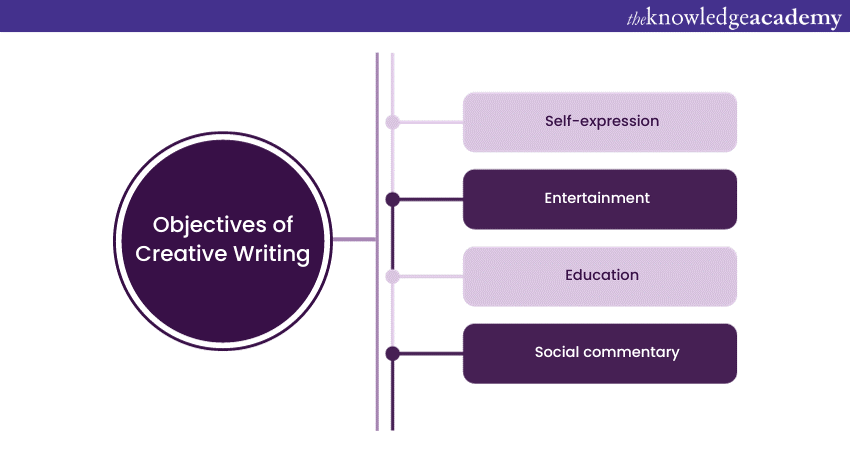
Self-expression
Creative Writing is, at its core, a powerful means of self-expression. It provides writers with a unique canvas upon which they can paint the colours of their innermost thoughts, emotions, and experiences. This objective of Creative Writing is deeply personal and cathartic, as it allows individuals to articulate their inner worlds in ways that spoken language often cannot.
Through the act of writing, authors can explore the complexities of their own psyche, giving shape and substance to feelings that might otherwise remain elusive. Whether it's capturing the euphoria of love, the depths of sorrow, or the intricacies of human relationships, Creative Writing serves as a conduit for unfiltered self-expression.
Moreover, Creative Writing grants the freedom to experiment with different writing styles, tones, and literary devices, enabling writers to find their unique voices. In the process, it cultivates self-awareness, self-discovery, and a deeper understanding of one's own experiences. For many, the act of putting pen to paper or fingers to keyboard is a therapeutic release, a way to make sense of the chaos within, and an avenue for personal growth and reflection. In essence, Creative Writing empowers individuals to share their inner narratives with the world, fostering connection and empathy among fellow readers who may find solace, resonance, or inspiration in the tales of others.
Entertainment
One of the primary and most recognisable objectives of Creative Writing is to entertain. Creative writers craft stories, poems, and essays that are designed to captivate readers, transporting them to different worlds, evoking emotions, and engaging their imaginations.
At its heart, Creative Writing is the art of storytelling, and storytelling has been an integral part of human culture since time immemorial. Whether it's a thrilling mystery, a heartwarming romance, or a thought-provoking science fiction narrative, Creative Writing offers an escape from the ordinary into realms of fantasy, intrigue, and wonder. It weaves narratives with vivid imagery, compelling characters, and gripping plots, all working together to hold the reader's attention.
Through Creative Writing, authors create emotional connections between the reader and the characters, fostering a sense of empathy and identification. As readers immerse themselves in a well-crafted story, they experience a wide range of emotions, from laughter to tears, joy to sorrow. It is this emotional journey that makes Creative Writing such a potent form of entertainment, offering readers a pleasurable escape from reality, a chance to explore new perspectives and a memorable experience that lingers long after the last page is turned.

Education
Creative Writing is not only a source of entertainment but also a powerful educational tool. It engages writers in a process that goes beyond storytelling; it encourages research, critical thinking, and the development of effective communication skills.
Writers often embark on extensive research journeys to create authentic settings, characters, and plots. This quest for accuracy and depth enriches their knowledge in various fields, ranging from history and science to culture and psychology. As they delve into their chosen topics, writers gain valuable insights and expand their intellectual horizons.
Furthermore, Creative Writing teaches readers important life lessons and imparts knowledge. It introduces them to diverse perspectives, cultures, and experiences, fostering empathy and understanding. Reading well-crafted works can be an enlightening experience, challenging preconceptions and encouraging critical thinking. It also enhances vocabulary, language skills, and the ability to express thoughts and emotions effectively.
In educational settings, Creative Writing nurtures creativity, encourages self-expression, and helps students develop essential communication and analytical skills. This educational objective of Creative Writing underscores its value as a holistic tool for personal and intellectual growth, making it an integral part of both formal and informal learning processes.
Social commentary
Creative Writing often serves as a potent medium for social commentary, embodying a powerful objective that transcends mere storytelling. Through the art of narrative, poets, novelists, and essayists alike can engage in meaningful discourse about society's values, issues, and challenges.
Writers use their creative works to shine a light on important societal concerns, question norms, and provoke thought. They employ allegory, satire, symbolism, and other literary techniques to critique, challenge, or explore various aspects of the human condition and the world we inhabit. Whether addressing issues such as inequality, injustice, environmental crises, or political corruption, Creative Writing can be a catalyst for change.
By portraying the complexities of real-life situations and characters, writers encourage readers to reflect on their own lives and the world around them. This introspection can lead to increased awareness and, ideally, inspire action to address pressing societal issues.
In essence, the social commentary objective of Creative Writing underscores its role as a mirror reflecting the world's triumphs and flaws. It empowers writers to be advocates for change, storytellers with a purpose, and champions of social justice, ensuring that Creative Writing continues to be a powerful force for positive transformation in society.
Tap into your creative potential with our Creative Writing Training – Get started today!
Purpose of Creative Writing
Creative Writing serves a multitude of purposes, making it a dynamic and invaluable art form. Beyond its objectives, Creative Writing plays a crucial role in our lives and society, contributing to personal growth, cultural preservation, inspiration, and connection.
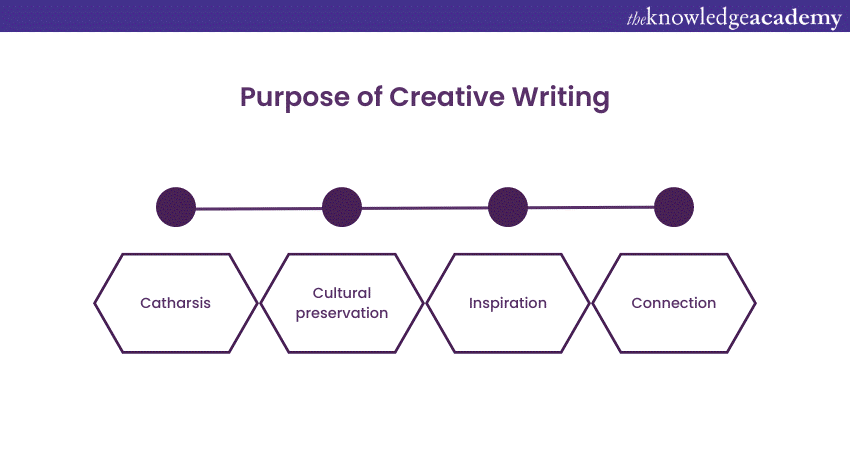
Catharsis
One of the profound and therapeutic purposes of Creative Writing is catharsis. This aspect of Creative Writing is deeply personal, as it offers writers a means to release pent-up emotions, confront inner turmoil, and find a sense of closure.
Through the act of writing, individuals can explore their innermost thoughts and feelings in a safe and controlled environment. Whether it's grappling with grief, heartbreak, trauma, or any other emotional burden, Creative Writing provides an outlet to give shape and voice to those complex emotions. It allows writers to dissect their experiences, providing a space for self-reflection and healing.
The process of transforming raw emotions into words can be both liberating and transformative. It can provide a sense of relief, allowing writers to gain insight into their emotional landscapes. Moreover, sharing these emotions through writing can foster connection and empathy among readers who may have experienced similar feelings or situations, creating a sense of community and understanding.
Ultimately, catharsis through Creative Writing is a journey of self-discovery and emotional release, offering solace, healing, and a path towards personal growth and resilience. It highlights the profound impact of the written word in helping individuals navigate the complexities of their own inner worlds.
Cultural preservation
Creative Writing serves a noble purpose beyond personal expression and entertainment—it plays a vital role in cultural preservation. This objective of Creative Writing involves safeguarding the rich tapestry of human heritage, traditions, and stories for future generations.
Cultures are defined by their narratives, folklore, and historical accounts. Creative writers, whether chroniclers of oral traditions or authors of historical fiction are the custodians of these invaluable cultural treasures. They document the stories passed down through generations, ensuring they are not lost to time.
Through Creative Writing, cultures are celebrated, languages are preserved, and unique identities are immortalised. Folktales, myths, and legends are retold, keeping them relevant and alive. These narratives provide insights into the beliefs, values, and wisdom of a society, fostering a deeper understanding of its roots.
Moreover, Creative Writing bridges cultural divides by sharing stories from diverse backgrounds, fostering empathy and appreciation for the richness of human experience. In this way, Creative Writing becomes a bridge across generations, connecting the past with the present and preserving the collective memory of humanity for a brighter future.
Inspiration
One of the transformative purposes of Creative Writing is to inspire others. It is a beacon that shines brightly, guiding aspiring writers and kindling the creative flames within them. Through the power of storytelling and the written word, Creative Writing has the remarkable ability to ignite the spark of imagination and motivation.
Exceptional works of literature often leave an indelible mark on readers. They can evoke a sense of wonder, curiosity, and passion, motivating individuals to embark on their own creative journeys. Many renowned authors found their calling through the inspiration they drew from the words of others, perpetuating a beautiful cycle of creativity.
Creative Writing serves as a testament to human potential, showcasing the boundless depths of imagination and the infinite possibilities of language. It encourages individuals to explore their unique perspectives, cultivate their voices, and craft stories that resonate with the human experience.
For writers and readers alike, Creative Writing is a wellspring of inspiration, a reminder that the world of imagination is boundless and that the written word has the power to shape minds, hearts, and the course of history. Through the act of creation and the sharing of stories, Creative Writing continues to inspire generations to dream, create, and connect with the world in profound ways.
Connection
Creative Writing holds a remarkable purpose - it fosters connections. It serves as a bridge between authors and readers, offering a means of understanding, empathy, and human connection that transcends time, space, and cultural boundaries.
When readers immerse themselves in a well-crafted story, they embark on an emotional journey alongside the characters. This shared experience creates a bond between the author and the reader as both parties navigate the complexities of the human condition together. Readers can see the world through the eyes of characters from diverse backgrounds and cultures, fostering empathy and understanding.
Furthermore, Creative Writing connects individuals across generations. Literary classics, for example, allow us to connect with the thoughts and emotions of people who lived centuries ago. These timeless works offer insights into the universal aspects of the human experience, reminding us of our shared humanity.
Creative Writing also has the power to connect people in the present. Through reading and discussion, individuals can form communities, share their interpretations, and engage in meaningful dialogue. Book clubs, literary events, and online forums all provide platforms for people to connect over their love for literature.
Conclusion
In conclusion, Creative Writing is a multifaceted art form with diverse objectives and purposes. From self-expression and entertainment to education, social commentary, catharsis, cultural preservation, inspiration, and connection, it enriches our lives in myriad ways. This timeless craft continues to captivate, inspire, and connect us, shaping our world through the power of words.
Embark on your personal growth journey with our Personal Development Training – Explore now!
Frequently Asked Questions
Upcoming business skills resources batches & dates.
Fri 28th Jun 2024
Fri 26th Jul 2024
Fri 23rd Aug 2024
Fri 27th Sep 2024
Fri 25th Oct 2024
Fri 22nd Nov 2024
Fri 27th Dec 2024
Fri 10th Jan 2025
Fri 14th Mar 2025
Fri 9th May 2025
Fri 11th Jul 2025
Fri 12th Sep 2025
Fri 14th Nov 2025
Get A Quote
WHO WILL BE FUNDING THE COURSE?
My employer
By submitting your details you agree to be contacted in order to respond to your enquiry
- Business Analysis
- Lean Six Sigma Certification
Share this course
Our biggest spring sale.
* WHO WILL BE FUNDING THE COURSE?
We cannot process your enquiry without contacting you, please tick to confirm your consent to us for contacting you about your enquiry.
By submitting your details you agree to be contacted in order to respond to your enquiry.
We may not have the course you’re looking for. If you enquire or give us a call on 01344203999 and speak to our training experts, we may still be able to help with your training requirements.
Or select from our popular topics
- ITIL® Certification
- Scrum Certification
- Change Management Certification
- Business Analysis Courses
- Microsoft Azure Certification
- Microsoft Excel Courses
- Microsoft Project
- Explore more courses
Press esc to close
Fill out your contact details below and our training experts will be in touch.
Fill out your contact details below
Thank you for your enquiry!
One of our training experts will be in touch shortly to go over your training requirements.
Back to Course Information
Fill out your contact details below so we can get in touch with you regarding your training requirements.
Preferred Contact Method
No preference
Back to course information
Fill out your training details below
Fill out your training details below so we have a better idea of what your training requirements are.
HOW MANY DELEGATES NEED TRAINING?
HOW DO YOU WANT THE COURSE DELIVERED?
Online Instructor-led
Online Self-paced
WHEN WOULD YOU LIKE TO TAKE THIS COURSE?
Next 2 - 4 months
WHAT IS YOUR REASON FOR ENQUIRING?
Looking for some information
Looking for a discount
I want to book but have questions
One of our training experts will be in touch shortly to go overy your training requirements.
Your privacy & cookies!
Like many websites we use cookies. We care about your data and experience, so to give you the best possible experience using our site, we store a very limited amount of your data. Continuing to use this site or clicking “Accept & close” means that you agree to our use of cookies. Learn more about our privacy policy and cookie policy cookie policy .
We use cookies that are essential for our site to work. Please visit our cookie policy for more information. To accept all cookies click 'Accept & close'.
You are using an outdated browser. Please upgrade your browser or activate Google Chrome Frame to improve your experience.
33 Interesting Writing Prompts for Language Learners (of All Levels)
When your language teachers and tutors advise you to get more writing practice , it can be hard to follow their guidance.
If your daily life isn’t action-packed, keeping a diary in your target language can get boring and repetitive, but what other topics can you discuss?
Whether you’re a beginner or an advanced learner, there are plenty of great things to write about. Here are 33 writing prompts for language learners to get you started.
Beginner Writing Prompts
1. who are you, 2. what are your favorite hobbies, 3. what’s your family like, 4. what’s your best friend like, 5. where do you live, 6. what’s your favorite food, 7. what’s your favorite season, 8. what’s your favorite movie or tv show, 9. describe your daily routine., 10. what are you going to do this weekend, 11. what’s your favorite animal, intermediate writing prompts, 12. what’s the funniest thing that has ever happened to you, 13. where would you like to go on vacation, 14. what’s the best vacation, trip or outing you’ve ever had, 15. where do you see yourself in five years, 16. what are your goals for the future, 17. what were you like as a child, 18. write a poem (rhyming or not) about something that inspires you., 19. pretend you’re instructing someone on how to do your favorite activity., 20. what’s your favorite (or your family’s favorite) tradition.
- 21. What do you think the world will be like in 50 years?
22. Why is education important?
Advanced writing prompts, 23. if you were given three wishes, what would you wish for, 24. what do you think the most significant world problem is, 25. if you could change one thing about society, what would you change, 26. how has the internet affected communication how do you see it affecting communication in the future, 27. what do you think would be an ideal political system does an ideal system exist, 28. who’s responsible for poverty why does it exist, and how could it be resolved, 29. what’s your favorite literary work, and what has it taught you, 30. if you could teach your future children or other children of the future one lesson, what would it be, 31. what medical issues have you or your loved ones faced how did you handle them or how do you continue to handle them, 32. what topics are not adequately addressed in schools today why should these topics be addressed more, 33. describe a recent world event. what are the potential consequences of this event, why use foreign language writing prompts, how to get the most out of writing prompts for language learners, and one more thing....
Download: This blog post is available as a convenient and portable PDF that you can take anywhere. Click here to get a copy. (Download)
Beginning level students usually know basic vocabulary related to describing people, weather, food, animals, routines and related topics.
Writing as a beginning student can be a bit tricky because you don’t yet have a vast vocabulary. Additionally, your verb conjugation abilities are probably limited, so you may need to stick to the present tense.
These writing prompts can be answered with simple, general vocabulary and present tense verbs , so they’re ideal for beginning students.
You can take this question in a wide variety of directions. Based on what vocabulary you want to practice, you might describe your appearance, your job and/or your interests. If you want to try using more advanced-level vocabulary, you could try getting more philosophical with your response.
Everyone has something they like to do. What are your favorite hobbies? If your vocabulary is limited, you might try simple responses, like “I like sports.” However, as your vocabulary gets more advanced, you can add more detail into your response. For instance, “I like sports, especially soccer. My favorite thing about soccer is hitting the ball with my head.”
What do they look like? What are their personalities like? How is each person related to you? What are their interests? This prompt can be used for quick, easy writing practice or for a book-length extended project.
You can describe your friend physically, describe their personality and/or explain what you like to do together. If you already know some past tense verbs, you might even tell a story about something that happened with your friend in the past to illustrate what your friend is like.
You could even break this one down into a series of prompts. Describe your neighborhood. Describe your city. Describe your state. Describe your country. You might discuss the layout, culture, businesses, natural environment or how you feel about your location.
Not only can you name the dish and list the ingredients, you can also describe how it tastes. As your language skills progress, you might even try explaining how the dish is made.
With this prompt, you can address a variety of subtopics. What is the weather like? What does the season look like? How does it feel? What events or holidays happen during the season?
You can describe what happens in the movie or TV show in either past or present tense. You might also note the genre and/or describe the characters.
Major bonus points if you can describe a Netflix movie or TV show that you also watch in your target language!
Beginning students commonly learn words related to daily routines, so go through your day and explain what you do. When do you wake up? How do you get ready for work or school? What do you eat for breakfast? When do you leave for work or school? How do you get there? What do you do once you’re there? What do you eat for lunch? When do you leave? What do you eat for dinner? How do you relax in the evening?
This question can be a little more advanced in that you could use future tense verbs. However, if you don’t yet know future tense, depending on what your target language is, you may be able to simply use “I am going to…” constructions. Writing about your plans can help you practice words for common activities and prepare you for real conversations you may have with native speakers.
You might describe the animal, what it looks like, what it eats, where it lives, etc. This can give you practice with animal words, physical descriptions, food words and location-related vocabulary.
As an intermediate writer, it’s time to up your game. Now, you can use a broader range of vocabulary words and verb tenses. These prompts will help you make good use of your advancing skills.
Whip out your past tense verbs for this one! Consider writing the story of the funniest thing you’ve experienced. Maybe it’s something that happened to you or maybe it’s just something you witnessed. Regardless, this will give you practice with more diverse vocabulary and past tense verbs.
This prompt invites you to give your conditional verb tenses a workout. Where would you like to go? Why would you like to visit this location? What would you like to do there? Who would you go with?
Describing the best out-of-the-ordinary experience you’ve had, whether a vacation or any other break from daily routine, gives you an opportunity to use plenty of past tense verbs. You might even work in some less common verbs to describe specific activities you participated in, like snorkeling or skiing. You can describe the experience, who you were with, what you did and what made it so enjoyable. Feeling nostalgic? Look at old photos if you have them and describe them in your target language.
Oh, the age-old interview question! In your native language, it’s probably an uncomfortable opportunity to reflect on your goals, but in your target language, it can be a valuable way to practice using future, conditional and/or subjunctive verb tenses while also employing industry-specific vocabulary.
Plus, if you ever need to do a job interview in your target language, you’ll be happy you have the practice. If you like this prompt, you might even consider using some of The Muse’s list of common interview questions for additional writing prompts.
What do you hope to achieve in your life? You might use future tense here, but if you prefer present tense, you can use an “I want to…” or related construction. From there, you can use all sorts of vocabulary words related to your career, family, housing, etc.
Use past tense to describe yourself as a child. You might describe your appearance or personality. To work in more advanced vocabulary, you might also note in what ways you challenged your parents and what you wanted to be when you grew up.
Writing poetry can be a fun way to use your language skills. To make it a little trickier, write in rhyme. You can write about whatever you like, but you can’t go wrong with a love poem. After all, you can always re-purpose it down the road if need be.
Whether it’s cooking, painting or playing Fortnite, this will require the use of commands and a strong vocabulary related to whatever activity you write about.
Whether they’re monthly or yearly, passed down through generations or made up on the spot, traditions shared by people can be a lot of fun. But they also afford a lot of opportunities to use whatever verb conjugations you need to practice. You can talk about your favorite tradition from the past, how you practice it today or how you hope to practice it in the future. You could even instruct readers on how to adopt your favorite tradition.
21. What do you think the world will be like in 50 years?
Think about society, culture and major world issues. How do you think everything will change and evolve? Not only can you use future tense verbs, but this prompt will give you the opportunity to use more advanced vocabulary related to science, technology, culture and/or politics. Depending on your vision, you could even expand your work into a sci-fi or dystopian novel.
This prompt could work with either present tense or conditional verbs. However, more importantly, it invites you to use plenty of more advanced vocabulary relating to learning, careers and society. Responding to this prompt could even serve as extra motivation by reminding you why education or learning of any kind (including your language learning) is so important to you.
As an advanced student, you should be aiming to write without having to think too much. You should be able to navigate seamlessly between any verb tenses and use your large and diverse vocabulary effectively. These prompts aim to help you exercise a broad array of skills.
Okay, you might not have a genie in a bottle, but what would you ask for if you did? This question invites the use of conditional tense verbs. Plus, the vocabulary you use is likely to be as diverse and varied as your dreams.
Writing about current world problems can help you use vocabulary words that are relevant today but might not be terribly common. While you could use present tense, you might also use future and/or conditional tense to examine how this issue could cause long-term consequences.
Take this world’s problems and turn them around! Considering what you would change about society will give you an opportunity to use conditional tense and/or commands to explain what needs to change and how.
Past and future tense in one prompt? How can you resist? Not only that, this prompt invites you to use the latest technology-related words, which are super useful for advanced learners.
This prompt invites you to use advanced vocabulary related to politics and society. Plus, you can use it to practice the conditional tense, future tense and/or subjunctive tense verbs.
This question may feel nearly impossible to answer in your native language, so it will be even more challenging in your target language. However, if you give it a try, you’ll be able to practice words related to society and politics. While you’ll probably use mostly present tense verbs, you might also work in some conditional, subjunctive, future and/or past tense.
Using key literary terms is often reserved for academia, so writing about your favorite literary work will certainly give your vocabulary a workout. While this will be largely in present tense, you might throw in a few other verb tenses for good measure.
What’s the best lesson you’ve learned? Why do you want others to learn it? This question is complex enough that you might incorporate a huge array of verb tenses.
Medical terminology can be a little tricky, but practicing using it is useful , particularly if it relates to a medical condition you or loved ones have. Writing about medical issues and their treatments will reinforce medical vocabulary and past tense verbs. Plus, if you ever experience a medical emergency abroad, you might be relieved to have practiced relevant vocabulary.
You’re educated. You know what’s up. What do you think should be covered more in schools? Addressing this issue gives you an opportunity to use education terms, present tense verbs and conditional verbs.
Not only can you use vocabulary that’s currently relevant, you can also use an array of verb tenses. Start with past tense and then transition to future, conditional and/or subjunctive tenses. Using this writing prompt can help you practice transitioning smoothly between tenses.
- Using foreign language writing prompts can help reduce anxiety when writing in your target language . Staring at a blank page can be stressful and can make you want to procrastinate trying to write, but writing prompts can make writing seem less like hard work.
- You can also use foreign language writing prompts to determine what vocabulary and/or grammar you need to work on . Writing can help you detect what grammar rules you’re struggling with and what holes in your vocabulary you need to fill.
- Writing prompts can help you keep your target language in shape . Skills can slip over time, so continuing to practice your writing can help prevent backsliding.
- Using writing prompts can help make it so that writing in your target language feels easy and requires less conscious effort . Writing in a foreign language is a skill like any other. The more you practice it, the easier it will become.
- Don’t just write. Read. To write well in your target language, you’ll need to also read in your target language. Luckily, there are plenty of places to read content in your target language . Project Gutenberg offers many classic works in several languages, and BBC News gives you news stories in a variety of languages.
- Write as often as possible. Writing as often as possible not only gives you the practice you need to improve your skills, it also keeps you in the habit. If you set aside a few minutes each day for your writing practice, you’re less likely to forget to do it.
- Try to use specific rules or vocabulary you’ve recently learned. Trying to use specific grammar rules and vocabulary you’ve recently learned is a terrific way to practice using your new skills. It reinforces them and makes them easier to use the next time.
- As you write, note what you’re struggling with. While you’re writing, you’ll probably notice a few hiccups. For instance, you may want a word but realize you don’t know it. Whenever you encounter one of these problems, jot it down. Then, after you write, you can go over your notes to work to resolve whatever issues you struggled with.
- Read what you’ve written and correct your own work. Once you’ve responded to a writing prompt, read over your work with a critical eye. What errors do you notice? How could you improve your writing? Going over your work gives you an opportunity to spot some errors you didn’t notice as you wrote.
- Consider having a native speaker correct your work. You might ask a friend or a tutor to read over your writing and tell you what they think. You could also consider finding a tutor through italki. Even finding someone to do a one-time check of your writing on occasion can be a huge help.
With these writing prompts for all levels, you’ll never be at a loss for words.
FluentU takes authentic videos—like music videos, movie trailers, news and inspiring talks—and turns them into personalized language learning lessons.
You can try FluentU for free for 2 weeks. Check out the website or download the iOS app or Android app.
P.S. Click here to take advantage of our current sale! (Expires at the end of this month.)

Try FluentU for FREE!
If you dig the idea of learning on your own time from the comfort of your smart device with real-life authentic language content, you'll love using FluentU .
With FluentU, you'll learn real languages—as they're spoken by native speakers. FluentU has a wide variety of videos as you can see here:

FluentU App Browse Screen.
FluentU has interactive captions that let you tap on any word to see an image, definition, audio and useful examples. Now native language content is within reach with interactive transcripts.
Didn't catch something? Go back and listen again. Missed a word? Hover your mouse over the subtitles to instantly view definitions.

Interactive, dual-language subtitles.
You can learn all the vocabulary in any video with FluentU's "learn mode." Swipe left or right to see more examples for the word you’re learning.

FluentU Has Quizzes for Every Video
And FluentU always keeps track of vocabulary that you’re learning. It gives you extra practice with difficult words—and reminds you when it’s time to review what you’ve learned. You get a truly personalized experience.
Start using the FluentU website on your computer or tablet or, better yet, download the FluentU app from the iTunes or Google Play store. Click here to take advantage of our current sale! (Expires at the end of this month.)
Related posts:
Enter your e-mail address to get your free pdf.
We hate SPAM and promise to keep your email address safe
30+ Resume Objective Examples (Plus, Tips on How to Write Yours)

Resume objectives are a bit controversial. Some career experts see them as outdated, while others believe job seekers can still use them to their advantage. Although resume objective statements have slowly been replaced by resume summaries, they remain useful in certain situations—and that's why you should know how to write one, just in case.
For instance, if you're changing careers and your previous work experience doesn't quite match the new role you're after, an objective statement could help communicate your professional goals to the hiring manager. Likewise, if you're a recent graduate or looking to relocate, you could use this section of your resume to highlight these intentions.
We've gathered 32 resume objective examples—plus, some tips on how to craft one that grabs the hiring manager's attention.
What is a resume objective
A resume objective is a brief statement outlining your short-term career goals, usually one to two sentences long. It should be tailored to the specific job or industry you're pursuing and is placed at the top of your resume, just below the header.
What is a good objective for a resume, and when are they welcomed? That's what we'll show you in a moment.
When you should use a resume objective
Resume objectives aren't quite the norm these days, so they should be only used when you need to clarify why you're applying for that particular role or company. Here are three situations where using an objective statement is a good idea:
- If you're doing a career pivot: A resume objective can guide recruiters on your career goals and prevent you from being disqualified when transitioning to a new field.
- If you're changing locations: Applying for jobs outside your current state or city can leave recruiters uncertain about your location; a resume objective can clearly express your willingness to relocate.
- If you're a recent graduate: Since you likely have little to no work experience to show, a resume objective can give a glimpse into who you are and what you aim to achieve.
- If you've worked in a variety of roles: When your work history is all over the place, a resume objective statement can be a helpful tool to highlight your most relevant skills, experiences, and what you're looking for in your next role .
Resume objective vs. resume summary
A resume objective outlines your career goals and what you aim to achieve in a position, while a resume summary focuses on skills, accomplishments, education, and relevant experiences for the role.
“Think of the resume objective as your career aspiration and the summary as your professional snapshot,” says Angela Tait, People Operations Specialist and Founder of Tait Consulting . “The objective sets your sights forward, while the summary looks at your past and present achievements.”
How to write a resume objective
If you decide to write a resume objective, it'll be the first thing recruiters see on your resume, right after your name and contact information. This means their first impression will be based on how well-written your objective statement is. Here are key tips to do it right:
1. Mention your area of expertise
“Start by mentioning your area of expertise and the role you are applying for,” Tait says. This way, you let the employer know right away about your background and what you want to achieve professionally.
2. Show how you can add value to the company
Your objective statement—and your whole resume, actually—should be tailored to each job opening. “Personalize your resume objective by stating how you can add value to the company you're applying to,” Tait says. “For instance, ‘ Seeking to leverage my expertise in digital marketing to drive brand growth and engagement at XYZ Corp.’”
3. Highlight skills relevant to the role
Once again, to write an effective resume objective, keep in mind the role you're going for. “Focus on how your skills and interests align with that specific job opportunity,” says Conor Hughes, certified in Strategic Human Resource Management (SHRM) and HR Consultant at SMB Guide .
For example, for a software developer, skills in programming with languages like Java, C++, and Python are pretty important. Meanwhile, a graphic designer should highlight technical skills in creating and editing visual projects using tools like Photoshop, Illustrator, and Figma.
4. Optimize your statement for ATS machines
These days, most resumes get scanned by an ATS robot before reaching human recruiters. So, it's crucial to optimize your objective statement for these ATS machines. How? “Use keywords from the job description to show you have the relevant abilities they're looking for,” Hughes says.
If a job posting specifies “experience in copywriting” and “SEO optimization” as requirements, you should incorporate these exact keywords in your objective statement—and wherever else they fit on your resume. Using just “SEO” or only “copywriting” might not be enough; precision is key.
Need some help? Here's how to read the job description the right way —so you can stop sending resumes into the void.
5. Make it as concise as possible
Recruiters go through resumes really fast—that's one of the reasons two-page resumes aren't usually recommended. When writing your resume objective, keep it concise. “To one or two sentences max,” Hughes says. Remember, the goal is to give enough information about why you're applying for that role, not to share your whole life history.
32 resume objective examples to guide you
Now that we've covered the basics, here are 32 good examples of objectives for resumes categorized by job title and different professional situations, like career pivoting and entry-level positions. Use these examples as a guide, and don't forget to inject your own personality and core information.
General resume objectives examples
1. career change.
Copywriter with five years of experience, now transitioning into the UX Writing field, looking to leverage my writing and content creation skills to create digital experiences that drive business growth. Strong background in content strategy and data-driven decision making.
Find UX writer jobs on The Muse »
2. Relocation
Experienced customer service representative relocating to New York in July, seeking employment with an established customer support agency. I bring my strong communication skills , conflict resolution and customer retention ability developed in seven years working in the industry.
Find customer service jobs on The Muse »
3. Entry-level
Creative marketing graduate seeking a social media assistant entry-level position at a fast-growing marketing agency. My goal is to apply my strong storytelling and creative writing skills to create impactful content for clients and foster professional development.
Find marketing jobs on The Muse »
Compassionate and enthusiastic elementary school teacher with four years of experience teaching young students. Seeking to leverage my creative ideas, multitasking and organizational skills to create a safe and stimulating environment where children can play and learn.
Find teacher jobs on The Muse »
Registered nurse with three years of experience in patient care , currently specializing in pediatric nursing. Seeking to join the Grey Hospital nursing team and bring my knowledge of patient care and my critical thinking skills to foster a safe and empathic environment for patients.
Find registered nurse jobs on The Muse »
6. Journalist
Seasoned journalist seeking a News Reporter position at the USPN channel. I bring my five years of experience working on live television, interviewing sources, gathering and reporting information in fast-paced environments.
Find journalist jobs on The Muse »
Seeking a litigation paralegal position at The Law Group. I bring my three years of experience in conducting legal research, processing legal documents, and witness preparation for deposition and trial.
Find lawyer jobs on The Muse »
8. Architect
Experienced architect relocating to Houston, Texas in August. In my 10 years of experience in the architecture industry I was able to work both in industrial and residential projects, holding high proficiency in AutoCAD and Photoshop.
Find architect jobs on The Muse »
9. Real estate specialist
Passionate and proactive real estate specialist with solid experience in lease negotiation and facility management. Looking for a similar role to manage a real estate portfolio, implementing strategies to improve profitability and cost effectiveness.
Find real estate jobs on The Muse »
10. Waiter/Waitress
Seeking a waitress position at a local, family-led restaurant where my two years of experience in customer service and hospitality industry would contribute to create an exceptional experience to customers, guests, and clients.
Find waiter/waitress jobs on The Muse »
Resume objective examples for tech professionals
11. software engineer.
Software engineer with 5 years of experience in the banking industry, pivoting to the customer service industry to foster professional growth. Deep knowledge of object oriented programming, experienced with Java, C++, C#, Ruby, Python, and relational database schema design.
Find software engineer jobs on The Muse »
12. Software developer
Computer science graduate seeking an entry-level position as software developer. I bring my experience with Git, Java, and Python, as well as strong documentation abilities and communication skills .
Find software developer jobs on The Muse »
13. Data scientist
Experienced data scientist, seeking a senior position in the e-commerce industry. My goal is to leverage my ability to write complex and efficient SQL queries to extract data and translate business needs into analytical frameworks.
Find data scientist jobs on The Muse »
14. SEO analyst
SEO analyst, passionate about SEO and digital audience growth. 7 years of experience with site migrations, SEO analytics tools (Google Search Console, Chartbeat, Google Analytics, and SEMRush), reporting and sharing data insights, and making data-driven decisions.
Find SEO analyst jobs on The Muse »
15. UI/UX Designer
Mid level UI/UX Designer, seeking employment in a fast-growing tech startup. Solid experience with user-centered design principles, knowledge of responsive design, strong analytical and problem-solving skills.
Find UI/UX Designer jobs on The Muse »
Examples of resume objectives for creative jobs
16. content writer.
Results-driven content writer with two years of experience writing for blogs and websites. Skilled in SEO, creative copywriting, and storytelling, looking forward to applying my skills and creative ideas to help XYZ build an engaged audience.
Find content writer jobs on The Muse »
17. Graphic designer
Creative graphic designer seeking an entry level-position in the education industry. Proficient with InDesign, Illustrator, Photoshop, Figma, and After Effects, quick learner with strong time management skills.
Find graphic designer jobs on The Muse »
18. Video editor
Outcome-oriented video editor, proficient with Final Cut, After Effects, Adobe Premiere, and Photoshop. Seeking employment in the entertainment industry where I intend to apply my extensive experience in storytelling and project management to create engaging stories.
Find video editor jobs on The Muse »
19. Social media manager
Experienced social media professional, seeking a manager position at a high-growth company. I bring my in-depth knowledge of social media strategy and five years of agency experience creating content that is engaging and exciting to the community.
Find social media manager jobs on The Muse »
Resume objective examples for administrative roles
20. front desk.
Highly energetic tourism and hospitality graduate, looking for a front desk clerk position. 1.5 years of experience in customer service. Strong time management and organizational skills, attention to detail, ability to learn quick and adapt in fast paced environments.
Find front desk jobs on The Muse »
21. Receptionist
Looking for a receptionist position in the real estate industry. Three years experience in customer-facing roles, communication and leadership skills, ability to work with tight deadlines focusing on all aspects of a task or project.
Find receptionist jobs on The Muse »
22. Administrative assistant
Seeking an administrative assistant role in the healthcare industry. I bring five years of experience in customer service, advanced Excel skills, and ability to multitask to perform my duties in a timely and efficient manner.
Find administrative assistant jobs on The Muse »
23. Human resources
Human resources graduate, looking for an entry level human resources generalist position with ABC company to apply my strong verbal and written communication skills , analytical abilities, and proficiency in Microsoft applications to provide hands-on assistance to the HR team.
Find human resources jobs on The Muse »
24. Logistics
Logistics supervisor seeking a manager position at AABB company. I bring my extensive experience in global logistics operations and project management to enhance supply chain and logistics efficiency and achieve cost-effectiveness.
Find logistics jobs on The Muse »
25. Executive assistant
Seeking an executive assistant role at XYZ company. I'm an experienced professional with strong interpersonal skills, ability to multitask, and attention to detail to provide timely and high quality administrative office support to senior level leaders.
Find executive assistant jobs on The Muse »
26. Office manager
Experienced administrative assistant seeking an office manager position in a fast-paced work environment to apply my written communication skills, time management, prioritization, and planning abilities and provide exceptional service and foster professional growth.
Find office manager jobs on The Muse »
Resume objective examples for sales jobs
27. sales assistant.
Problem solver and team player sales professional, seeking a sales assistant position in a challenging work environment. I bring my experience supporting high acquisition organizations, willingness to learn, and winning team spirit to support sales teams.
Find sales assistant jobs on The Muse »
28. Sales manager
Dynamic sales manager seeking employment in the pharmaceutical industry to develop strategic sales plans and achieve revenue and market share objectives. Two years of experience in pharmaceutical sales plus three years of experience in general sales, excellent communication and leadership skills.
Find sales manager jobs on The Muse »
29. Cashier
Recent high school graduate looking for a cashier position at a company with a culture of recognition and excellence. One year of experience in retail sales, strong organizational, leadership, and communication skills to represent the company in a professional manner.
Find cashier jobs on The Muse »
Examples of resume objectives for finance careers
30. banking.
Seasoned relationship banker looking to secure an investment banking analyst position at Bank of America. 15 years of experience in the banking industry, advanced knowledge of banking transactions, strong interpersonal skills, and ability to develop and expand relationships with stakeholders.
Find banking jobs on The Muse »
31. Accounting
B.S. graduate in accounting seeking an entry-level accounting associate position to use my growth mindset, desire to learn, and organizational skills to ensure financial goals are achieved and foster professional development.
Find accounting jobs on The Muse »
32. Financial analyst
Chartered Financial Analyst (CFA) looking to secure a senior position in a competitive and results-driven work environment. 10 years of experience in financial analysis in banking and technology industries, advanced Excel and SQL skills, and ability to articulate analysis outcomes and relevant insights.
Find financial analyst jobs on The Muse »
Key takeaways
Resume objectives aren't the favorite of most recruiters, but they still serve a purpose. If you're career pivoting, relocating, applying for your first job, or have a diverse professional background, an objective statement can help the hiring manager understand your career goals and how they align with the job opportunity.
However, in other circumstances, using a resume summary might be more appropriate. (Here are 20 resume summary examples to make writing your own easier .)
- Share full article
Advertisement
Supported by
How the Arts Can Benefit Your Mental Health (No Talent Required)
Drawing, music and writing can elevate your mood. Here are some easy ways to welcome them into your life.

By Christina Caron
When Dr. Frank Clark was in medical school studying to be a psychiatrist, he decided to write his first poem.
“All that chatter that is in my head, everything that I’ve been feeling, I can now just put it on paper and my pen can do the talking,” he said, recalling his thoughts at the time.
Back then, he was struggling with depression and had been relying on a number of things to keep it at bay, including running, therapy, medication and his faith.
“I had to find something else to fill the void,” he said. It turned out that poetry was the missing piece in his “wellness puzzle.”
“I saw an improvement in my mood,” said Dr. Clark, who now sees patients in Greer, S.C. “It gave me another outlet.”
The notion that art can improve mental well-being is something many people intuitively understand but can lose sight of — especially if we have become disconnected from the dancing, creative writing, drawing and singing we used to enjoy as children.
We are having trouble retrieving the article content.
Please enable JavaScript in your browser settings.
Thank you for your patience while we verify access. If you are in Reader mode please exit and log into your Times account, or subscribe for all of The Times.
Thank you for your patience while we verify access.
Already a subscriber? Log in .
Want all of The Times? Subscribe .
14 Best AI Writing Software Tools of 2024 (Expert Picks)
Pricing: $9 per month Standout Features: AI-powered Writing Platform, Multifaceted Marketing Tool, Efficient Long-form Editor
Pricing: $69 per month Standout Features: Comprehensive AI Writing Suite, Powerful Quality Output, Advanced AI Solutions

Pricing: $20 per month Standout Features: Customized for Storytelling, Intuitive Suggestions Toolbar, Dynamic 'Expand' Feature
AI writing software has exploded in popularity. Every since ChatGPT, AI writing has become mainstream, with hundreds of new AI writing tools flooding the market. Almost every Saas platform includes AI writers somewhere in their feature set, and there are hundreds of standalone services with Chrome extensions and more.
The AI writing assistant software market is expected to grow at a rate (CAGR) of 26.94% from 2023 to 2030, reaching a market size of $6.464 billion by 2030. – VerifiedMarketResearch.com
Since there are so many to keep track of, we will walk you through the best AI writing tools and highlight what each is best suited for. You’d be surprised how specialized some of these get.
- 1.1 1. Rytr
- 1.2 2. Jasper
- 1.3 3. Sudowrite
- 1.4 4. Copy.ai
- 1.5 5. Writesonic
- 1.6 6. WordHero
- 1.7 7. Article Forge
- 1.8 8. Frase.io
- 1.9 9. Surfer SEO
- 1.10 10. Scalenut
- 1.11 11. INK
- 1.12 12. WriterZen
- 1.13 13. ClosersCopy
- 1.14 14. HubSpot AI Blog Writer
- 2 How AI Can Help Your Writing Workflows
- 3.1 Feature Comparison of Best AI Writers
- 3.2 Price Comparison of AI Writing Tools
- 4 What is the Best AI Writing Software?
- 5 Frequently Asked Questions (FAQs)
The Best AI Writing Tools
AI can speed up virtually any writing task by selecting the right tool. We’ve done unbiased research to show you the best AI Writing Apps you can choose from today. Take a look at these AI writing tools that can eliminate writer’s block and the fear of the blank page.
The Best AI Writing Software Listed In Order
- Article Forge
- ClosersCopy
- HubSpot AI Blog Writer
🥇 Best AI Writer for General Use
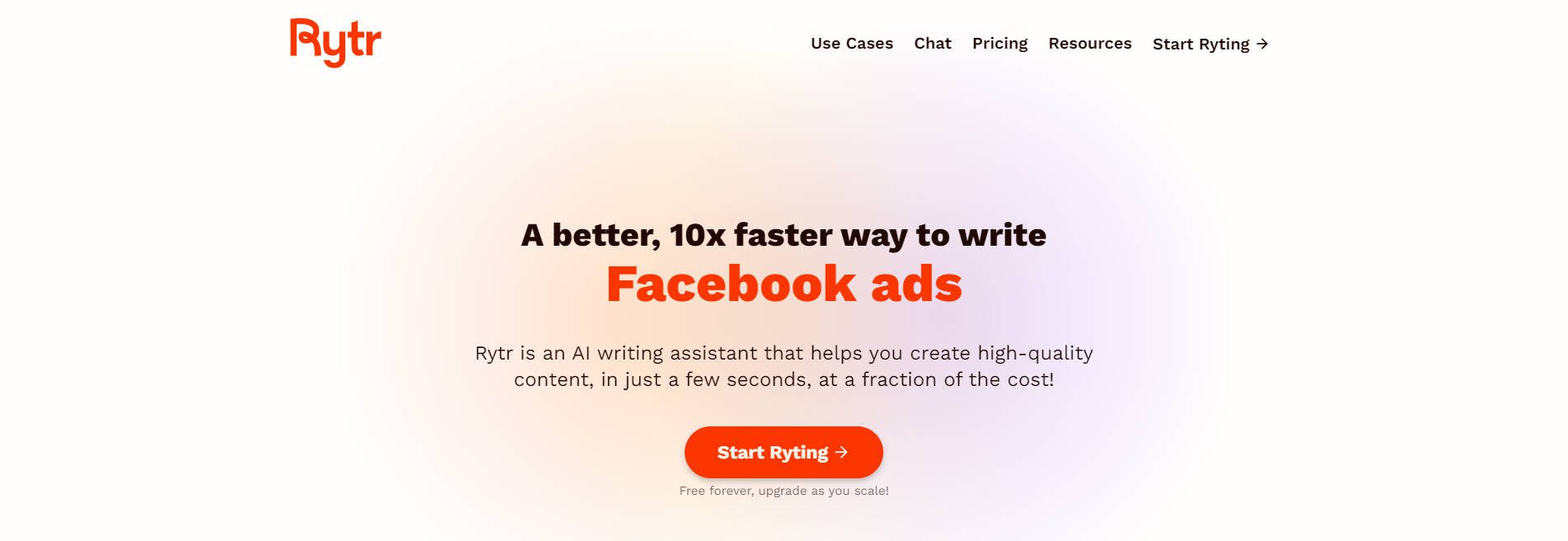
Rytr is an AI-powered writing platform with one of the largest footprints of all AI writing tools on the market. It’s an all-purpose AI tool that is handy for any diversified marketer. It has copywriting frameworks, templates for blog writing, and use cases for creating product descriptions. It also sports SEO integrations so you can write with the fullest confidence of keywords and semantic topical coverage in your work. You will never write quite the same again after using this.
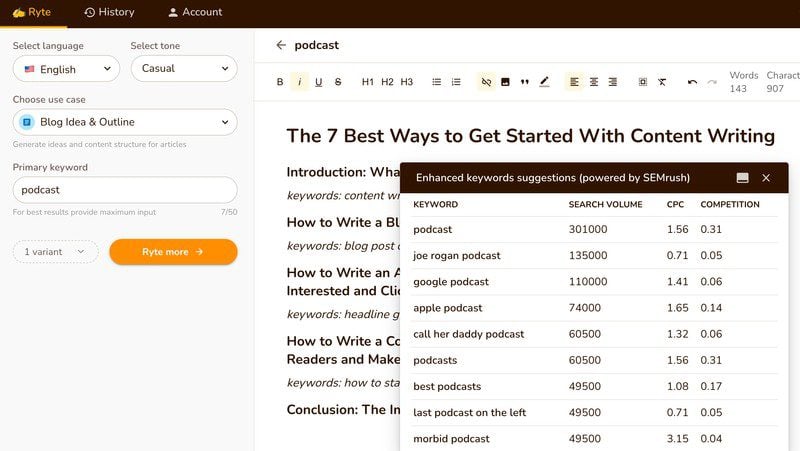
Rytr uses AI technology to create high-quality content quickly and easily. Users can generate content for various applications and industries, including marketing, eCommerce, and more. The easy-to-use interface makes it easy to start, even for users without previous AI writing (or writing!) experience.
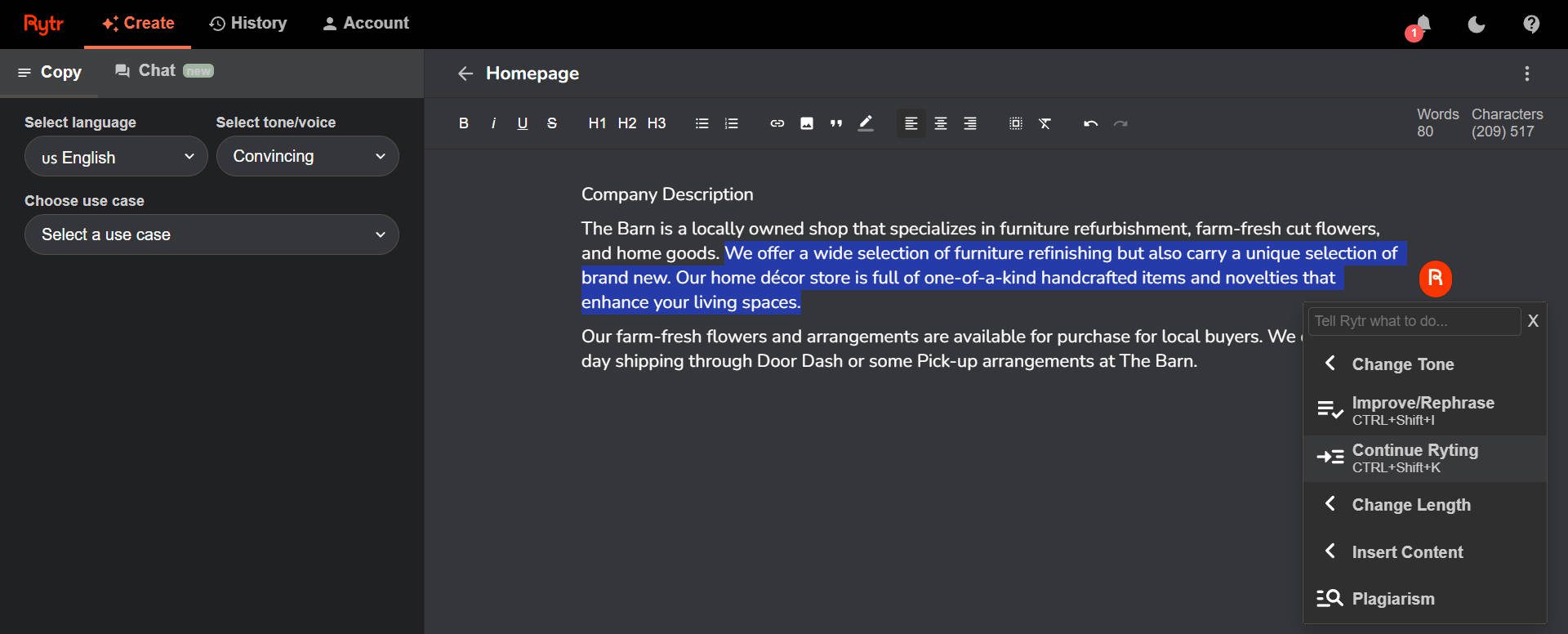
They’ve also launched Rytr Chat, which allows human writers to chat back and forth with its AI to generate tailored content iteratively that can be easily added to its long-form editor.
What We Like About Rytr
- Multilingual : AI-generated content is supported in over 30 languages, accommodating a broad user base.
- Templates : More than 40 templates and use cases are available, eliminating the need to write detailed prompts.
- User Interface : Features an easy-to-use interface, including a long-form editor and a dark mode option for eye comfort.
- Chrome Browser Extension : A Chrome extension is available that integrates AI writing capabilities into favorite apps like the WordPress editor and emails.
- SEO Integrations : It integrates with Semrush and SERPs for top content analysis to find accurate keyword research suggestions, which is beneficial with “Blog Idea” and “Blog Outline” templates.
- Plagiarism Checker: Rytr now includes a built-in plagiarism checker to compare its output against so that its AI-generated words are guaranteed to not sound like a robot.
- Tone of Voice Prompt: Like other top-tier AI writers, Rytr supports creating your own voice or tone settings. However, it does this via Prompt and not through uploaded sample content.
What Could Be Improved
- Content Depth : Rytr excels in generating short-form content but can struggle with depth and detail for more complex, long-form articles. Enhancing its algorithms to produce more in-depth analyses and comprehensive pieces would be beneficial.
- Contextual Understanding : While Rytr supports a wide range of languages and templates, improving its contextual understanding and accuracy in niche or technical subjects could make it more versatile and reliable for specialized content creators.
🥇 Why We Picked It
Rytr stands at the top of our list for a few reasons. It’s gathered millions of happy users worldwide while developing new tools and features. It is also one of the lowest-cost solutions on the market. Combining those things with its dead simple usability (not to mention its Chrome extension), Rytr doesn’t have many downsides.
Interested in learning about all Rytr has to offer? Catch our full Rytr review , where we go into every feature.
Who is Rytr Best For?
With over 7 million writers using Rytr, it’s hard to imagine someone who wouldn’t benefit from its AI writing platform. If you’ve never used an AI tool, this is one to start with—with a free plan available. It also has the cheapest starting price out of all the tools on this list. It’s the perfect tool for anyone looking to have AI improve their writing productivity. Whether you’re a freelancer, small business owner, or part of a larger team, Rytr is an essential tool for any writer looking to boost their efficiency and streamline their workflow.
Community Reviews and Ratings
People note how easy it is to use and love its price point. It is a very popular tool because it steadily adds advanced features while still keeping it simple.

Rytr offers a free plan, with its starter plan costing as little as $9 per month !
🥈 Best AI Writer for Businesses
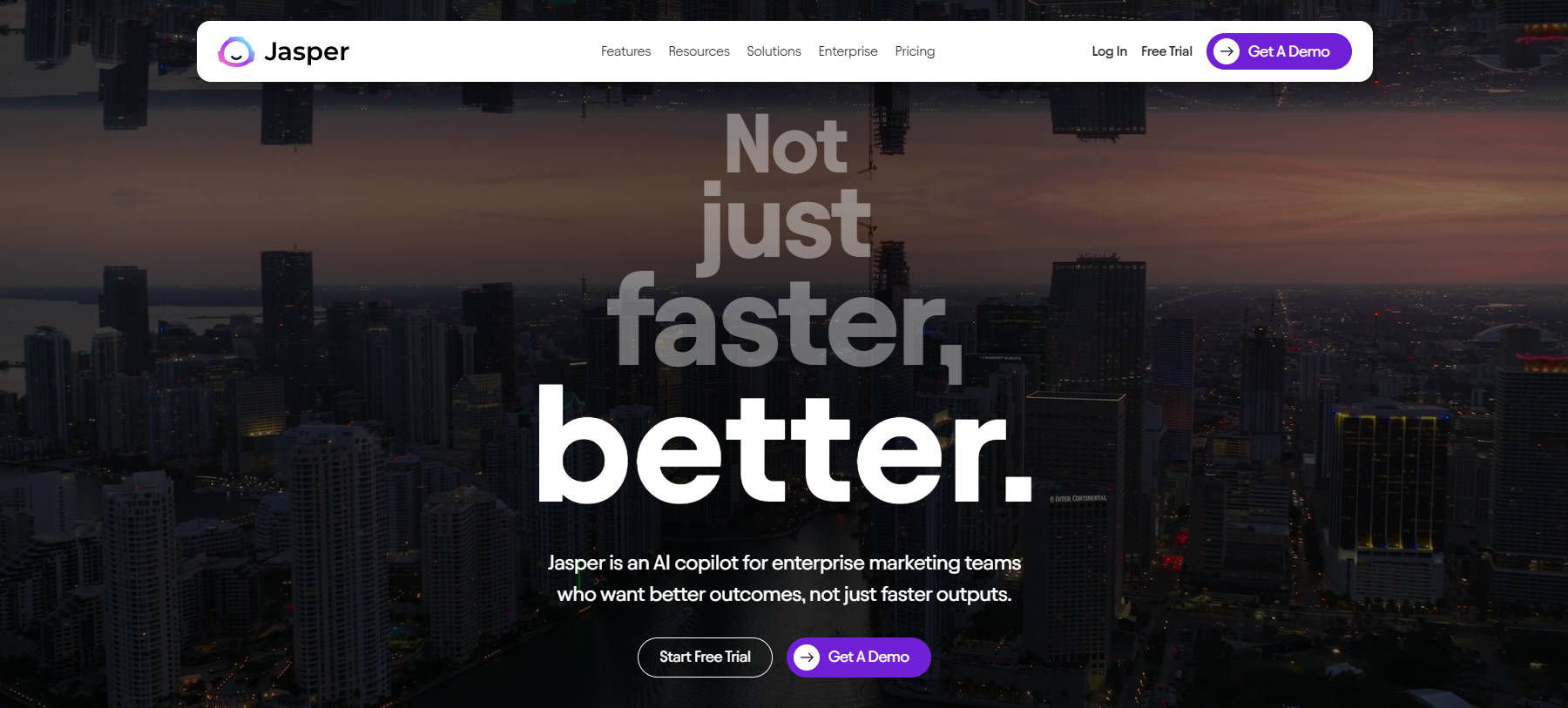
Jasper is another wildly popular AI writing platform (originally called Jarvis AI). It is home to some of the most powerful AI tools for writing long-format content, SEO content, blog posts, sales emails, and more. It also provides training, courses, and conferences around its feature set that gets a lot of traction among AI users. Jasper is probably among the more respected brands known for constantly iterating on their world-class AI solutions.
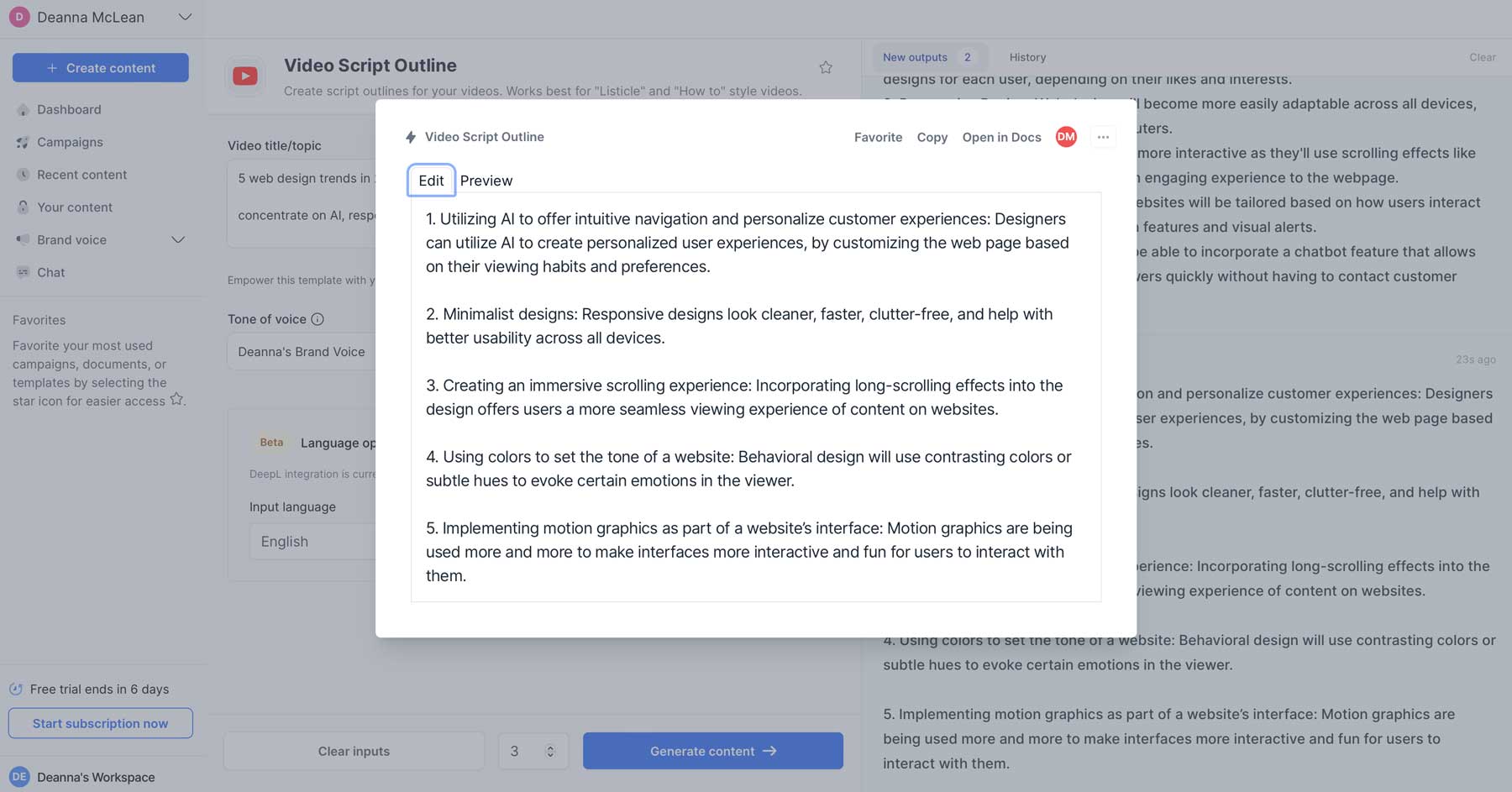
Jasper’s built for the more extensive writing operations among us. Generative content produced by Jasper is high quality, with plenty of tools that make the whole platform sparkle.
What We Like About Jasper
- Integration : Jasper integrates with powerful tools like Surfer SEO, Chrome, and Grammarly, enhancing its functionality at every turn.
- Support : Offers incredible documentation, support, and customer success training directly from the company.
- AI Art Generation : Includes AI-generated art with each plan, adding visual creativity to content.
- Collaboration : Provides advanced plans for team collaboration so multiple people can work on documents together (vital for teams).
- Up-to-date : It has access to real-time data via the internet, enabling it to write about news events from as recently as this morning.
- Company Knowledge: Not only can it write in your company’s brand voice, but it can save “memories” of important pieces of information that it can use while writing to have more accurate context and description of the particulars of your business.
- Pricing : Jasper’s is undoubtedly priced to be a business tool. They do not offer a free version or even something cheaper than ChatGPT, making other ChatGPT alternatives more attractive than Jasper on that point.
- Integration Depth : Jasper integrates with several tools for SEO and grammar, but deeper integrations, particularly with content management systems, could streamline the content creation process further. They’ve started this with Webflow , but more effort is needed for this to be a valuable enterprise tool.
🥈 Why We Picked It
Jasper has it all: a long-standing product with best-in-class features. It is widely used and has found its niche with enterprise and corporate marketing teams. It isn’t a copycat product of other popular AI writers out there, and it specializes in business use cases.
Who is Jasper Best For?
Jasper is best for businesses that need to speed up internal writing functions (like marketing, sales, support, and more). It’s relatively expensive, but you pay for its quality and simple editing workflow.
Still undecided? Take a look at our Jasper Review to see everything that it has to offer.
Besides a few mentions of it being hard to unsubscribe from, users love using Jaspers’s best-in-class features. They continually find value in the new features they release and how well done they are. Most customers are medium-to-large content or marketing operations.
No free plan with prices starting at $69 per month with a limited free trial
3. Sudowrite
🥉 best ai writer for novel & fiction writing.
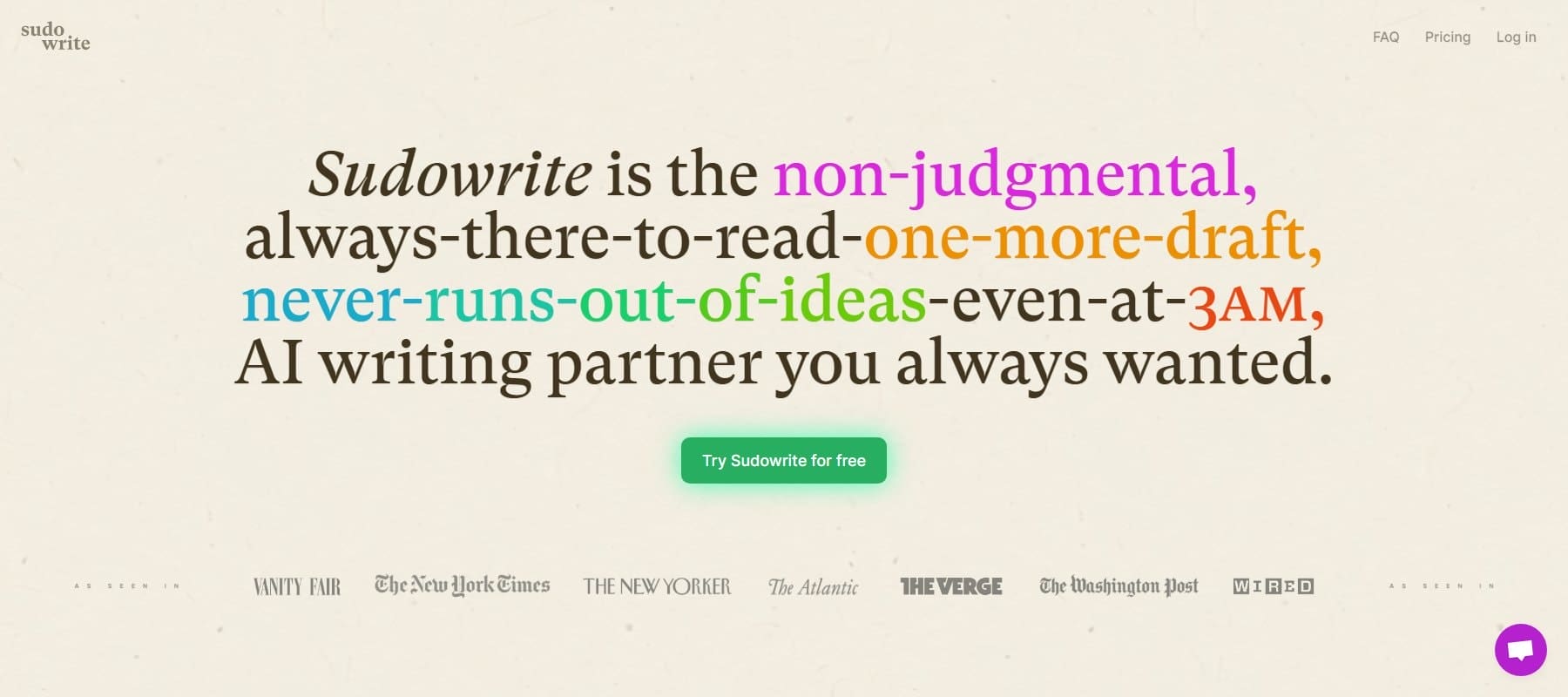
Sudowrite is an AI writing software built exclusively for stories and all content that uses even a little storytelling. It does not have the recipes/templates that some other platforms have but instead focuses more on a writing workflow than the parts and pieces of a particular work.
Sudowrite gives you a draft, suggestions, and editing advice, and it is more tailored toward creative and descriptive writing. While most other AI writing software focuses on business use cases and blogs, Sudowrite goes against the grain and offers something truly unique.
What We Like About Sudowrite
- First Draft : Sudowrite’s “First draft” feature can transform a simple prompt into 1000 words, streamlining content creation.
- Suggestions : Offers auto-complete and styled suggestions that are easy to integrate and relevant to your writing context.
- Enhancements : Utilizes “Describe” for adding captivating language and “Expand” for naturally extending sections of writing.
- Built for Writers: While some AI writers aim to replace writers, Sudowrite aims to make writers more efficient in their writing processes.
- Dialogue: Many people use AI for factual content, but Sudowrite helps with prose and narrative.
- Character Coherence : While Sudowrite is excellent with story writing, it can be pushed a little too hard if heavily used. This is noticeable in the discontinuity of characters and histories of events throughout an entire story.
- Credit System : Its credit system starts with a high dollar amount, where it would be better if there were entry-level plans that cost sub-$20 for hobbyists.
🥉 Why We Picked It
Writing takes many shapes, and just because you are reading an internet article right now does not mean that everything you wish to read and write is fact-based nonfiction. Sudowrites covers a massive corner of the market to help writers of fiction, poetry, and narrative with the projects they are passionate about.
Who is Sudowrite Best For?
Sudowrite is best for creative professionals in interesting brand writing positions or those crafting narrative, poetry, and other prose. It is also meant for storytellers of all kinds (poems, books, scripts) and delivers.
If you are on the fence about trying it, look at our Sudowrite review to see all its features and workflows that can help you with your creative writing adventures.
Not many reviewers have shared their experience with Sudowrite, but that makes sense for something created for creative writers. The cost can be a little high, and the writing tends to stray when the AI is forced to write too much.
No free plan with paid plans starting at $19 per month for 225,000 credits
Get Sudowrite

Copy.ai is a prevalent content generator (over 6 million users) specially tailored to optimize the workflows of many sales and marketing tasks (including systems and integrations). This connects its AI-generation prowess to many different applicants that can enhance sales-enablement and go-to-market strategies. This can dramatically increase an individual’s or team’s output for specific tasks with the help of ks.
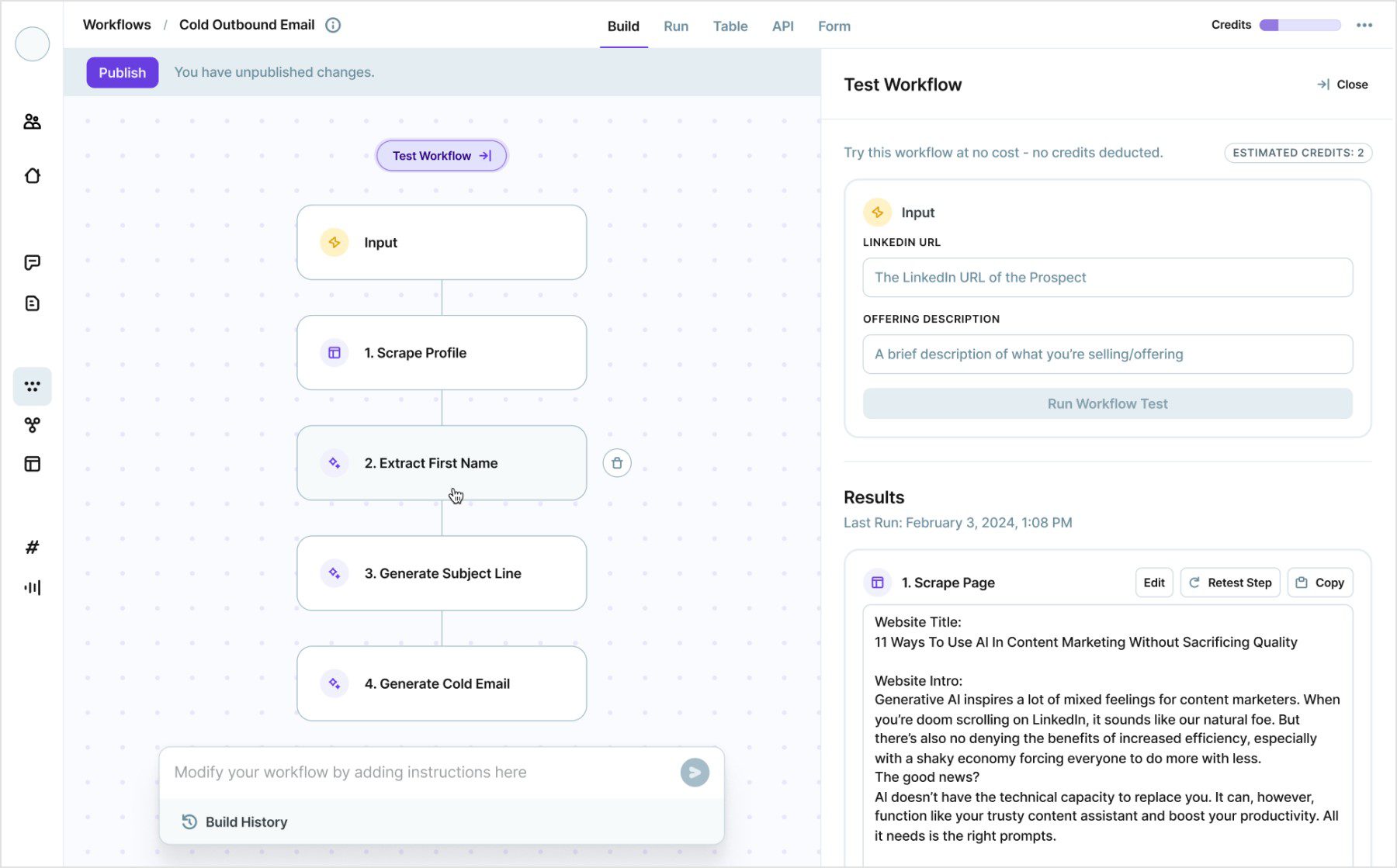
Its API for LinkedIn, for example, can pull prospect info from a CRMeir LinkedIn profile to help create a tailored cold-outreach message that is personalized and written with copywriting principles. It also includes a ChatGPT alternative with Copy.ai Chat .
What We Like About Copy.ai
- API & Zapier Integration : Copy.ai’s API/Integrations connect with CRMs, LinkedIn, and other sales/marketing tools for effective cold outreach.
- Chat Interface : Features Chat by Copy.ai, a ChatGPT-like interface optimized for sales and marketing tasks with a prompt library.
- Pricing Model : Offers a unique pricing model based on the number of fired automations (Workflows) with unlimited generatable words.
- Brand Voice + Infobase: Stores essential details about your business branding voice of important information that it should be aware of.
- Lack of Native Integrations : While impressive, Copy.ai’s workflows primarily run based on a limited number of integrations built into the system. Instead, users must know how to work with an API or use Zapier as an expensive connection solution.
Who is Copy.ai Best For?
Copy.ai is best for salespeople and marketers whether or not they work on a team. Teams stand to benefit from its Pro plan, which includes unlimited words, unlimited projects, and up to five user seats. See our article on how to use Copy.ai if you want more information.
Users of Copy.ai note its intuitive approach to content creation. The flexibility and its unique features make it well worth its time.
Offers a free plan with limited credit usage and a Pro plan starting at $49 per month .
Get Copy.ai
5. Writesonic

Writesonic is an AI writing software that packs a lot of features into its platform. Its free plan gives 10,000-word access to its optimized GPT 3.5 platform, while its paid plans can be powered by GPT 4. Writesonic also has innovative products like Photosonic and Chatsonic that bring even more AI-powered tools to its customers.
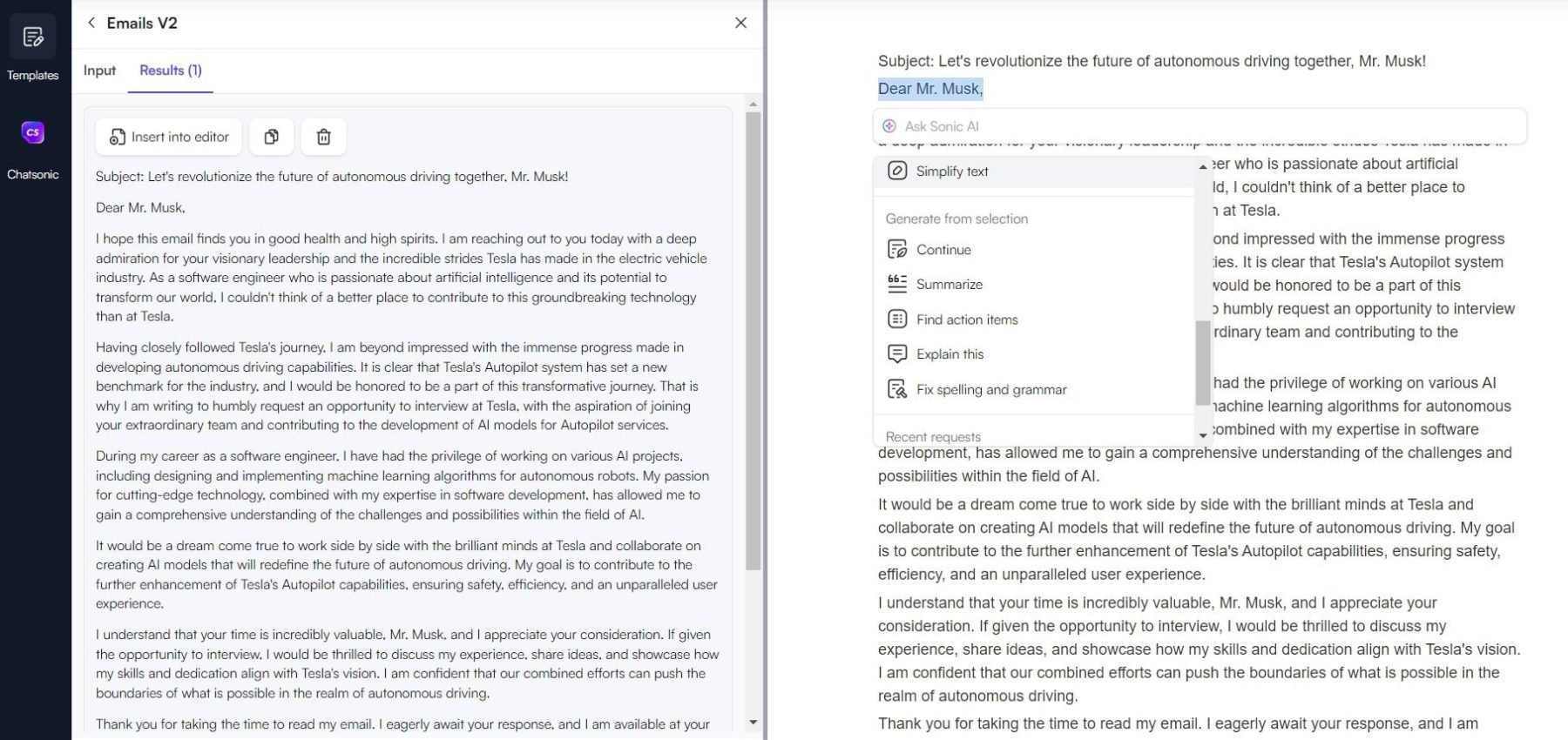
Learn more about Writesonic and its AI Chatbot, Chatsonic , with our detailed reviews.
Writesonic’s advanced AI technology allows users to generate high-quality written content quickly and easily. The platform also includes various advanced editing tools, enabling users to fine-tune their content perfectly.
What We Like About Writesonic
- AI Tools : Writesonic provides AI copywriting tools with over 100 templates for various content types, including blog posts and landing pages.
- Collaborative Editing : Features SonicEditor for collaborative editing, allowing multiple team members to contribute to a text.
- Landing Page Generation : Can generate and code out static landing pages along with the copy, integrating with Surfer SEO and Zapier.
- ChatSonic : All plans include access to ChatSonic, a GPT-4-styled chat solution with current trending topics awareness (also includes Photosonic for AI art generation).
- Brand Voice: Stores information about the way your business speaks with its brand voice feature.
- Cluttered UI : Writesonic packs so many features under the hood that it can be a messy and confusing platform to navigate. We wouldn’t say it’s hard to use, but it can be a lot to take in and find your way through.
- Confusing Credit System: Uses a crediting system where the base model used (GPT 3.5 and 4) can be toggled and those changes the amount of credits used per word.
Who is Writesonic Best For?
Writesonic is a comprehensive platform for marketers and content writers with AI tools for several writing tasks. Its fast pace of innovation means that any user needing generative AI content, images, or chat interfaces would likely benefit from the platform. It’s one of the better all-purpose AI writing websites with a free plan.
Overall, users love all the different features and sub-products available within Writesonic. Ultimately, its power as an AI writer is satisfying, and the output quality is quite good. Some have had issues dialing in their prompts, but that is an inherent challenge with any AI writer using foundation models.
Free plan with paid plans starting at $19 per month .
Get Writesonic
6. WordHero
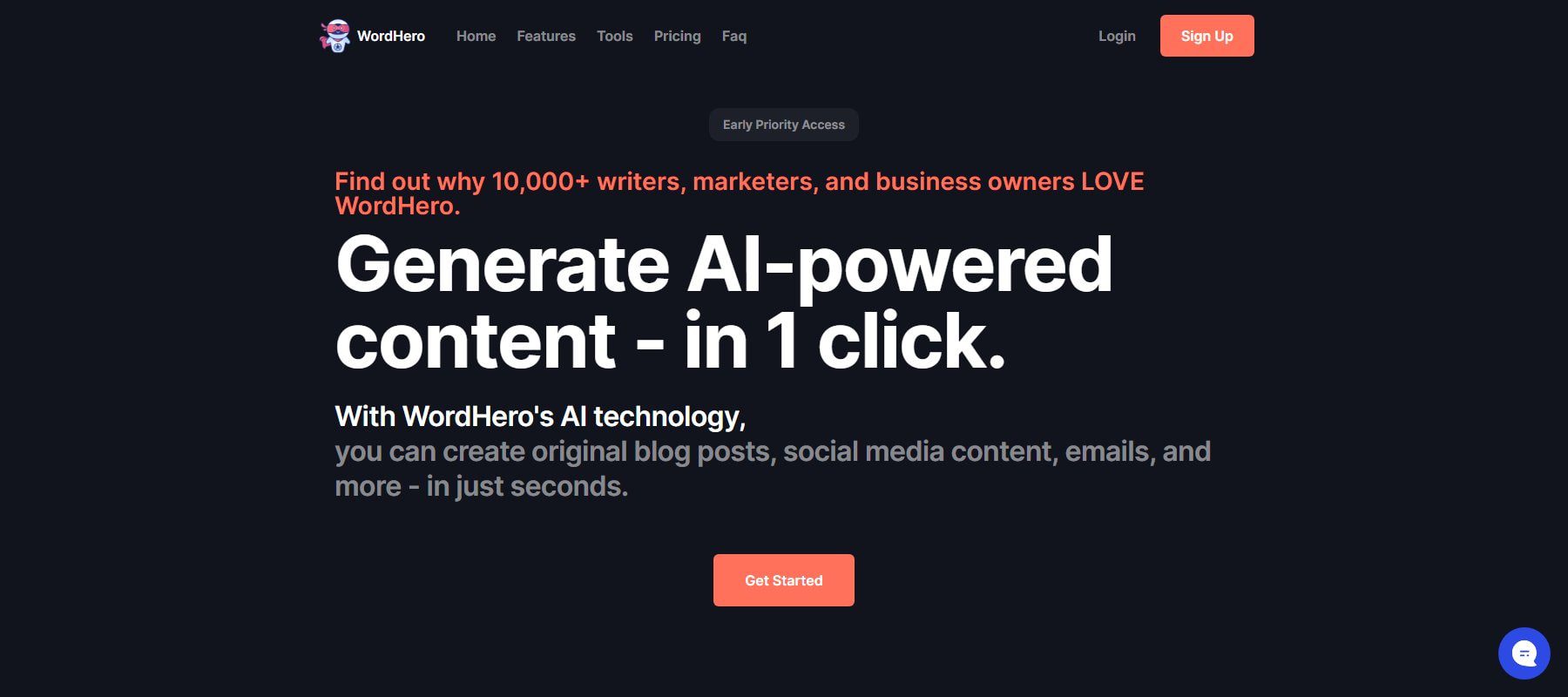
WordHero is another all-purpose AI writing tool particularly suited for business purposes. Launching on AppSumo with a lifetime deal with unlimited words, it’s quickly come into its own. WordHero suits on-the-fly content generation that you can paste into your documents of choice, like Word, a Slack channel, or a marketing campaign. Its long-form editor has come a long way and makes creating whole documents with the help of AI even easier.
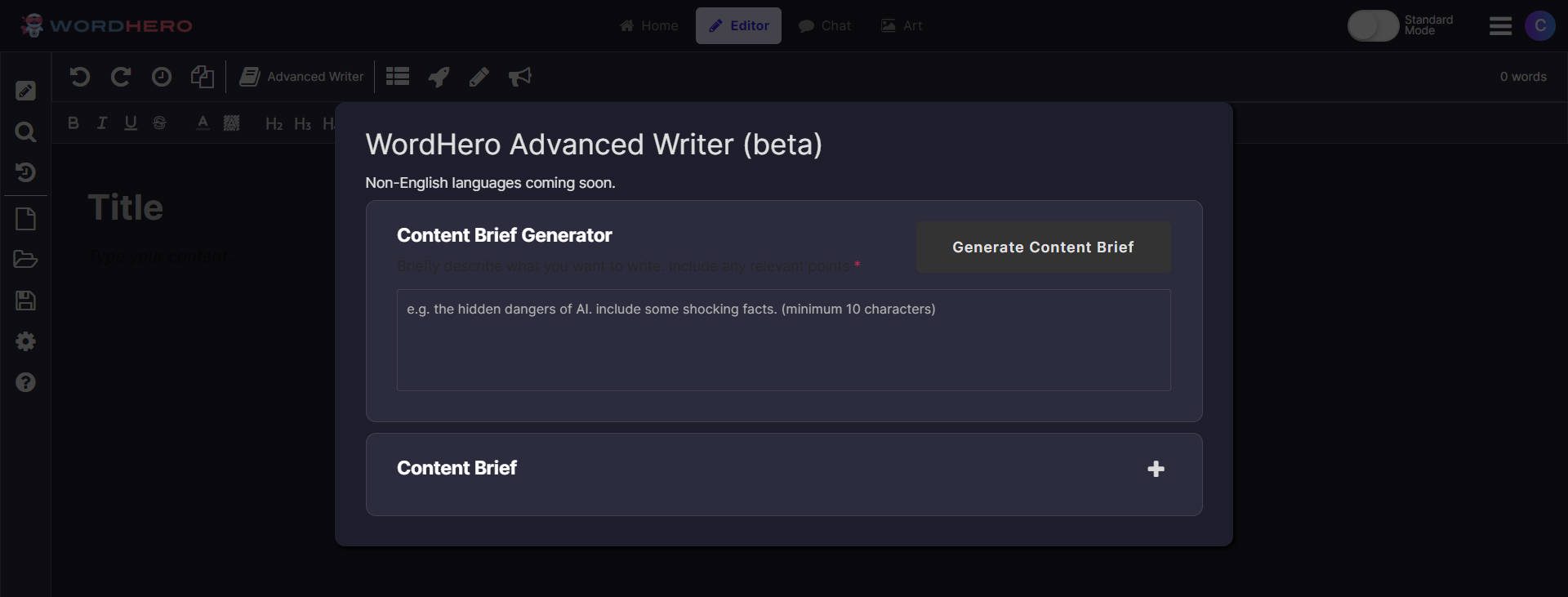
There’s a dedicated and loyal user base that constantly suggests improvements that the team takes into consideration. So, it is likely the platform will continue to improve as it has over the last couple of years.
What We Like About WordHero
- Templates : WordHero offers template-based AI outputs for immediate use or integration with its long-form editor.
- Blog Content : Surpasses Rytr in generating compelling blog introductions and conclusions.
- Unlimited Content : Allows for the generation of unlimited content, adhering to their fair use policy. Released “ Enhanced Mode ” which uses better AI models which may have monthly word limits.
- Multilingual Support : Supports over a hundred languages, placing it at the top of the list for language diversity.
- Brand Voice: WordHero has recently launched brand voice features, which have been some of the most important features for other AI writing platforms.
- Advanced Writer: AI writing workflow for having WordHero output a coherent 2,000-word article in one fell swoop. Go from zero to the first draft in under a minute with this feature.
- Frequent LTD Sales: WordHero has been on AppSumo multiple times and even sells lifetime subscriptions on their website currently. This is great for early adopters but is an unsustainable business model for a SaaS company with costs every time an AI request is generated. This makes the future of WordHero a little murky although a great deal for those willing to make the bet on a LTD.
- Dark Mode: Dark mode in the editor is lovely to have, but some text displays as dark gray over the black background, making it very hard to use aspects of its UI. This is an easy fix but one we would like to see sooner rather than later.
Who is WordHero Best For?
Like Rytr and others on this list, WordHero is best for those in business or marketing. It creates excellent blog section content and does a good job with copywriting frameworks and product descriptions. It does not currently have advanced integrations, so it’s ideal if this is the only AI writing tool you expect to use in your workflow.
There are not many reviews of WordHero despite its large userbase. But take it from the frequent product updates reflected in the changelog, and you can notice they are answering many of their customer’s wishes.
No free plan, with prices starting at $49 per month .
Get WordHero
7. Article Forge
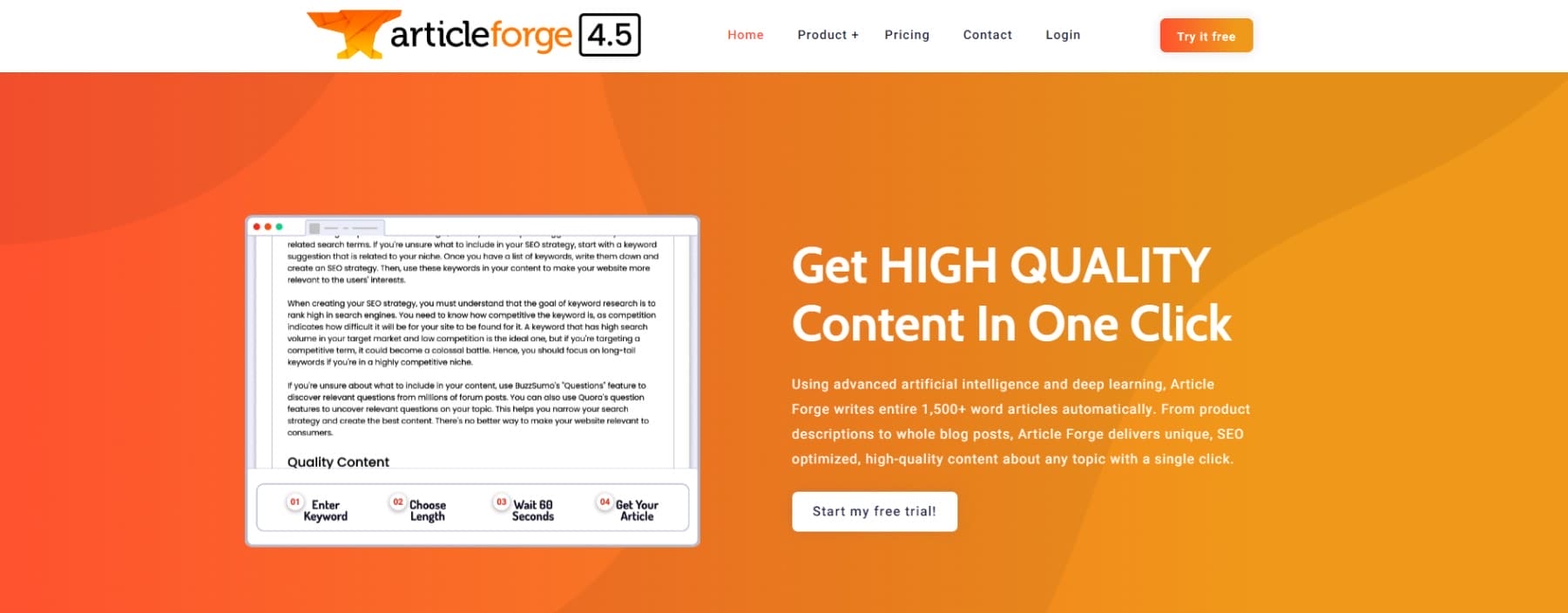
Article Forge is an AI writing software built for long-form content creation. Put in a keyword, select some basic parameters like length, and Article Forge will forge ahead with a fresh piece of generated content.
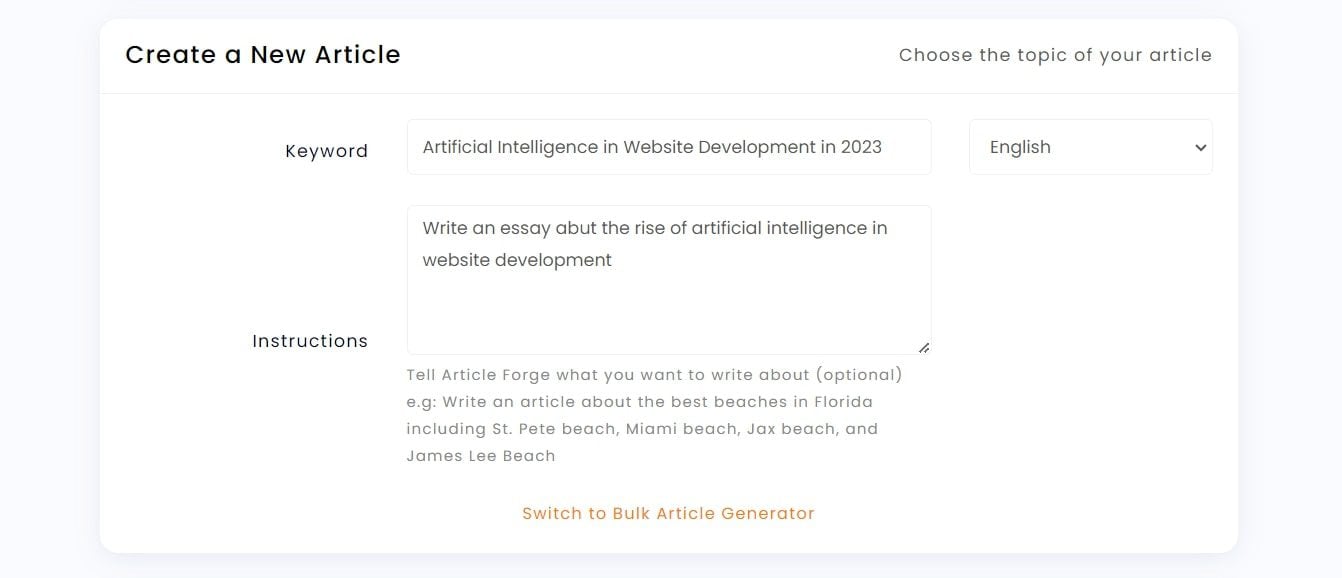
Article Forge’s power comes from its ability to create a lot of content simultaneously. That is also its sticking point, which places more responsibility on humans to read, edit, and substantiate what the AI generated. However, it’s a refreshing change of pace from other AI tools that build content sections at a time until you’re done.
What We Like About Article Forge
- One-Click Creation : Article Forge generates high-quality, long-form content (1,500 words) with a single click, simplifying content production.
- SEO Optimization : Features built-in SEO optimization to enhance content visibility.
- Topic Filtering : Enables adding negative or excluded topics to refine content relevance.
- Natural Flow : Automatically creates content and headings that naturally flow, improving readability.
- Copy-scape Pass : Guarantees content will pass Copy-scape, ensuring originality.
- Over-Reliance Risk: Because of the features that Article Forge markets, it’s easy to think that AI-generated content is good to publish as-is. With the recent news breaking over social sites about “SEO Heists” (stories of how companies used programmatic SEO to generate hundreds of thousands of visitors in monthly traffic with AI articles, only to have Google apply manual actions against those sites and drop visitors to mere thousands per month) users should be wary of unhelpful AI content and how it can affect your website.
- High Cost: Article Forge employs a credit system that lets a user write up to 25,000 words for $27 per month. This is a high price since it costs more than ChatGPT while inflicting higher limits.
Who is Article Forge Best For?
Article Forge is best for more extensive content operations that want to increase their editorial output dramatically. Great for creating supporting content (clusters) in quick succession. It still takes work to edit and fact-check the output correctly, and it works even better when a human writer overhauls every paragraph. It also scores high marks on all major review sites, which tells us they are doing something right.
Many users enjoy using Article Forge since it makes it so easy to generate a long first draft. Some have noted its high price tag and others that they can’t reliably get articles longer than 750 words to generate.
No free plan with paid pricing starting at $27 per month .
Get Article Forge
8. Frase.io
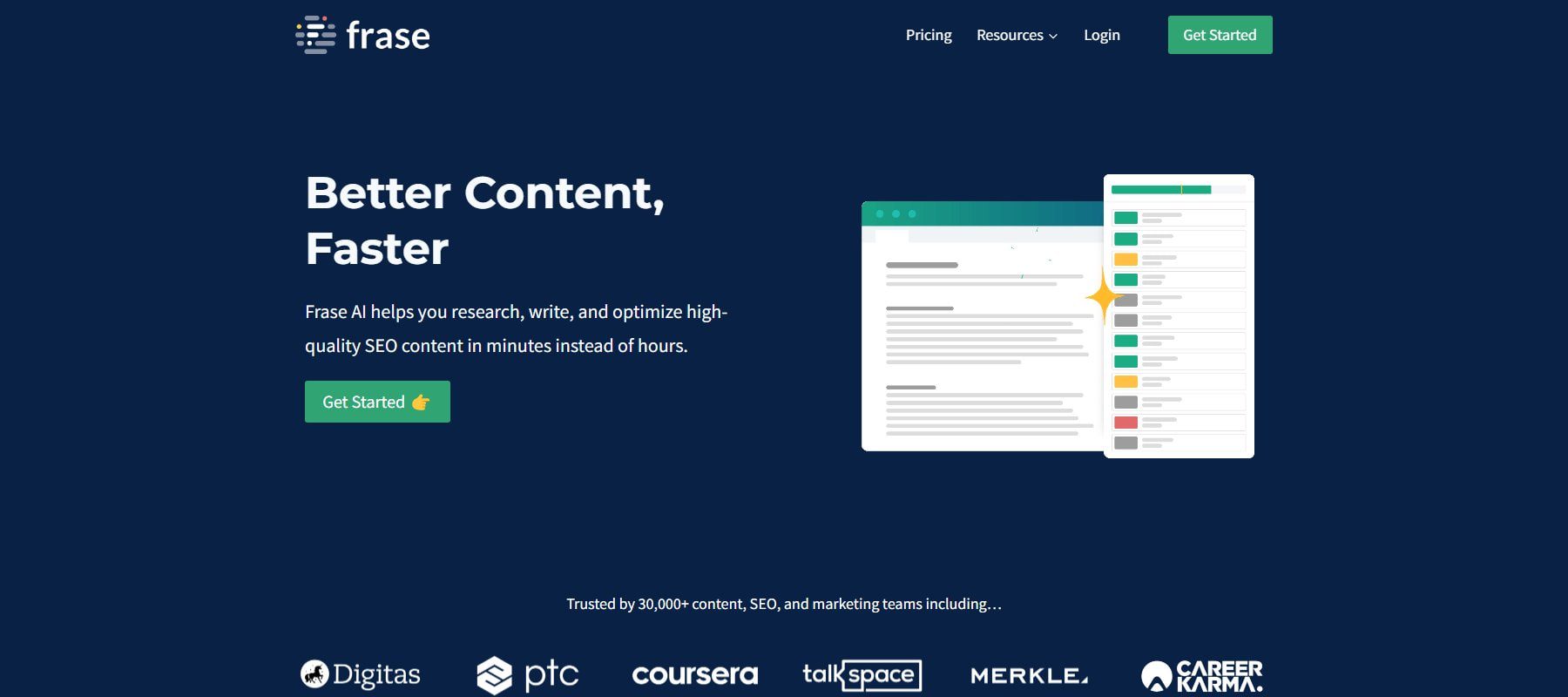
Frase.io is a powerful AI writing tool that can help you with all aspects of your content creation process. It can help you create high-quality content that will engage and inform your readers, from researching topics to writing and editing your content. Whether you’re a blogger, a content marketer, or just someone who wants to write better content, Frase can help you take your content to the next level.
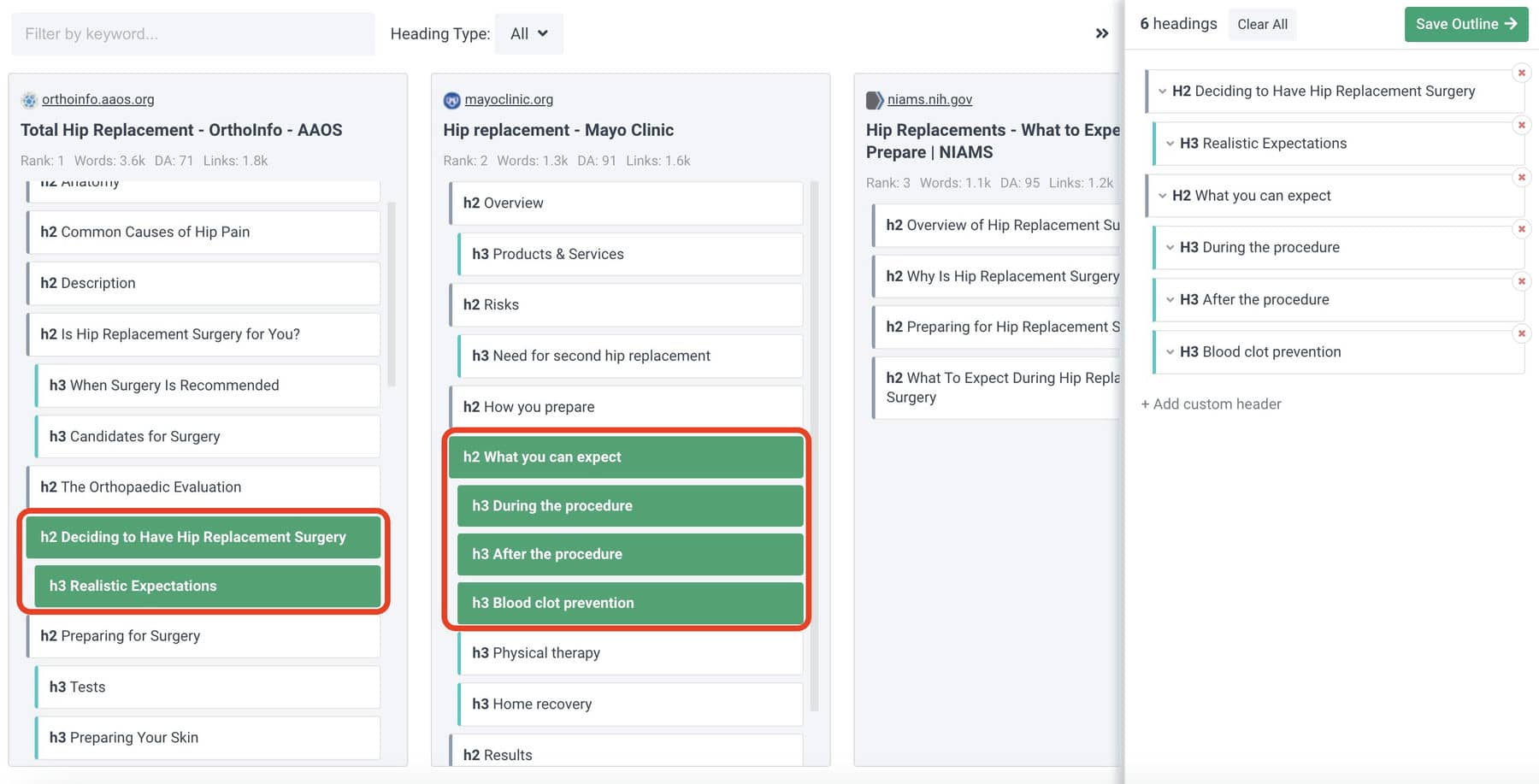
With Frase’s advanced AI technology, businesses can create high-quality content quickly and easily. Additionally, the advanced SEO tools ensure that the content is optimized for search engines. Frase analyzes published content and provides actionable, AI-generated next steps that save valuable time.
What We Like About Frase
- SEO Content Briefs : Frase can create content briefs from SERP research in just “6 seconds,” including customizable templates for frequent content types.
- Flexible Editor : Offers a long-form editor that allows for both manual writing and AI assistance at any point.
- Advanced SEO Content Optimization : Enables content optimization for SEO with NPL topic modeling and tracks performance with Google Search Console integration to identify and address content decay.
- Integrations : Frase offers some really nice integrations (like WordPress, Salesforce, and Google Search Console), but expanding its integration capabilities with more third-party platforms and tools could streamline users’ workflows even further.
Who is Frase Best For?
Frase.io is ideal for content marketers or teams who want to write quality SEO content with AI to rank well in organic search. With GSC integration included in every plan, Frase is particularly useful for large content sites that rely on content decay warnings without manually checking each post every quarter.
Frase has spectacularly good reviews, as people love its approach to creating SEO content. It gets the content writing workflow down pat, making it a breeze to work through creating something that is publishable. Some users want more file hierarchy in storing AI written materials inside the platform, but that is relatively minor.
Starts at $14.99 per month with an unlimited content generation add-on for an extra $35 per month .
9. Surfer SEO
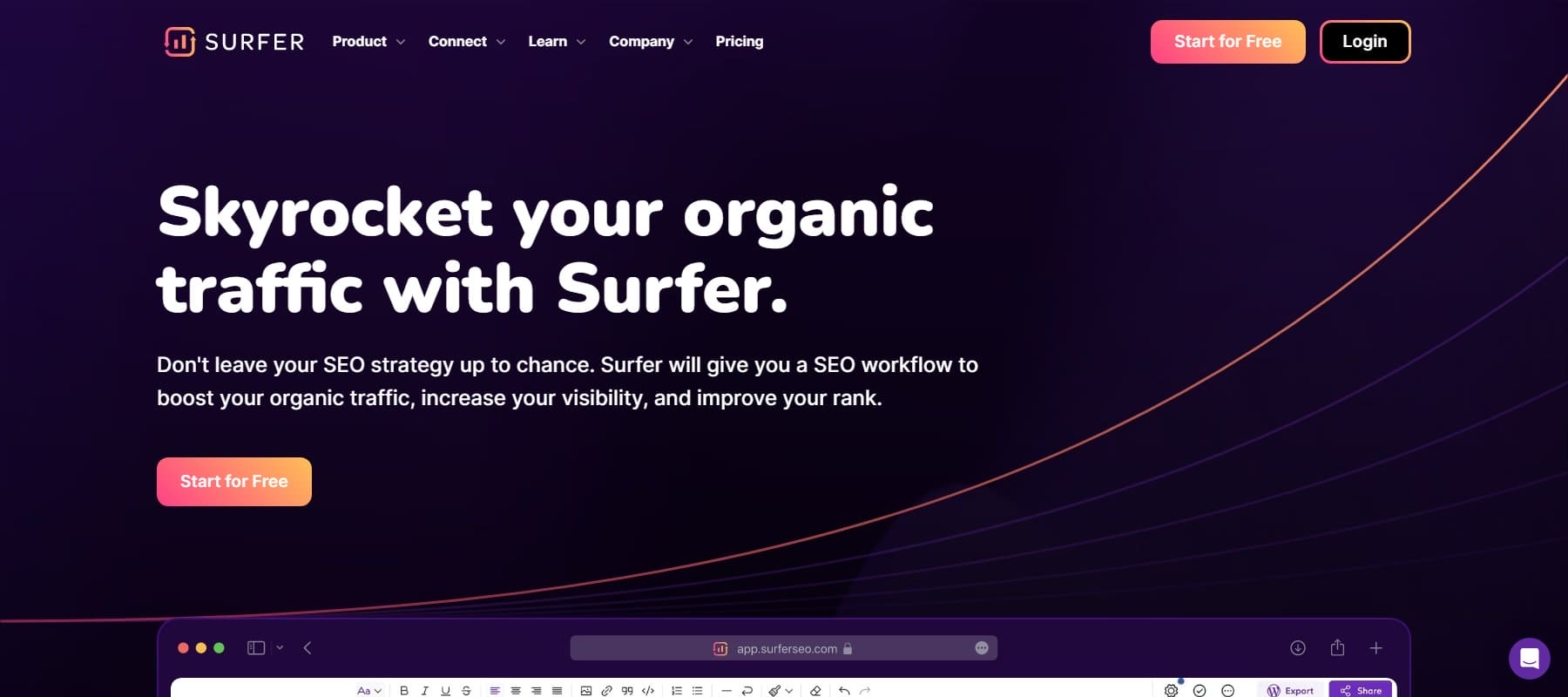
Surfer SEO is the premier writing AI that can help you rank #1 on Google. It does this by analyzing the top-ranking pages for your target keywords and then providing you with suggestions on how to optimize your content. This can save you a lot of time and effort and help you improve your chances of ranking higher in search engine results pages ( SERPs ). You may have noticed how many other AI writers integrate directly with Surfer—that’s a testament to what Surfer SEO can do for you and your websites.
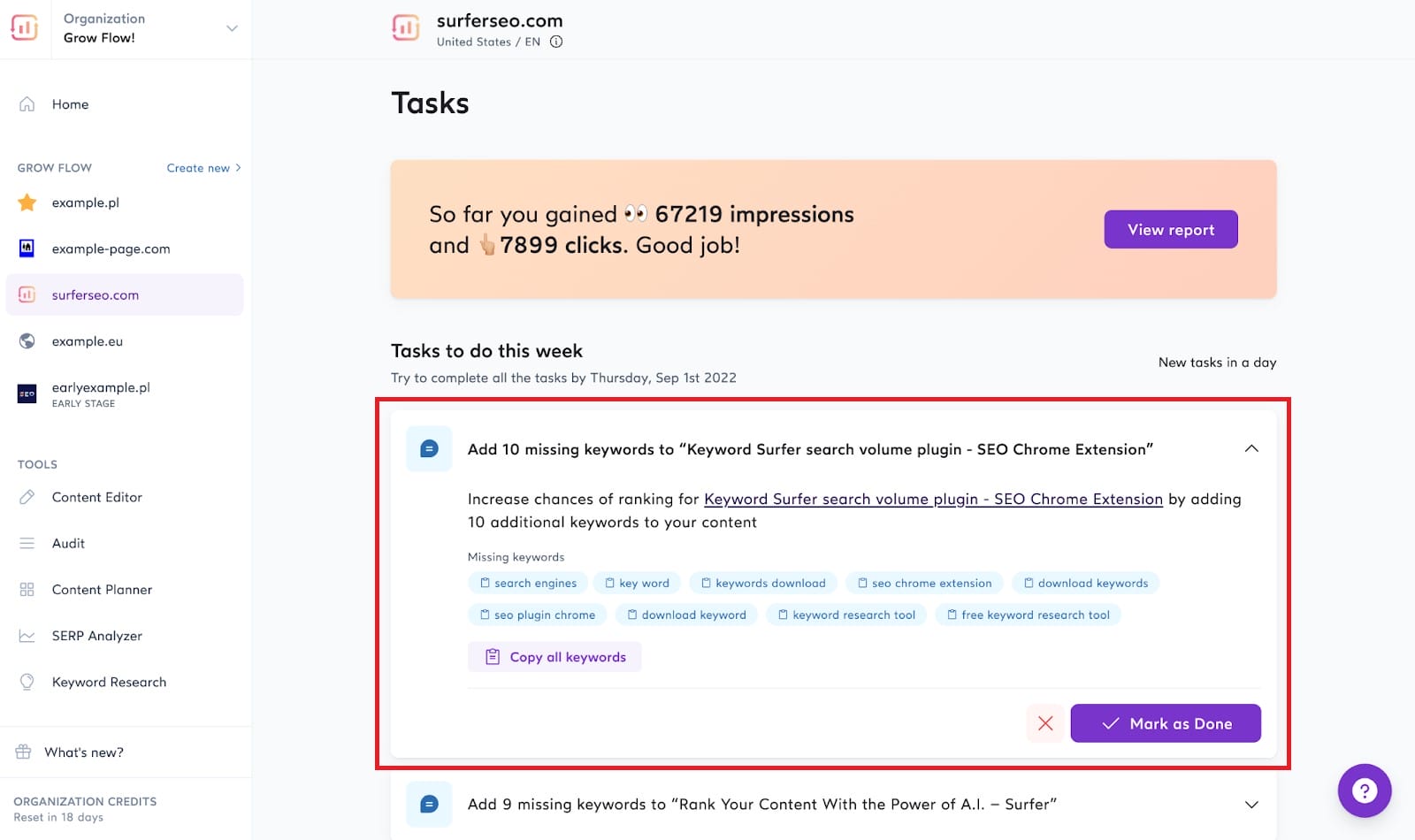
Surfer SEO’s advanced AI technology allows businesses to optimize their online content for search engines quickly and easily. The platform includes various advanced SEO analysis tools, content optimization recommendations, and competitor analysis tools to help businesses improve their online presence.
What We Like About Surfer SEO
- Content Strategy : Surfer SEO creates content briefs and outlines based on top-ranking SERP results for strategic content planning.
- Content Score : Offers a content score based on SERP analysis, NPL, and other key ranking factors to guide content optimization.
- Plagiarism Checker : Includes a plagiarism checker to avoid ranking penalties and maintain content integrity.
- Integration : Integrates with top AI writing software, Google Docs, Semrush, and WordPress, enhancing content creation and publishing workflows.
- Pricing: SurferSEO can be quite the investment, with the lowest-priced service at $89 per month. This lets users write, edit, and analyze 30 documents.
Who is Surfer SEO Best For?
Surfer SEO, right now, is the go-to AI and NPL tool for SEO content writing. Likely, you want to pair Surfer with an advanced AI writer like Jasper or Rytr. Surfer SEO is the perfect companion for these fantastic tools and helps keep your AI content in the good graces of Google and other search engines.
Another SEO AI writer that scores really well with customers is Surfer. Surfer was one of the first mega-popular SEO writers, and it shows in their mature feature set. There are some idiosyncracies, among them being the price tag, but users love using it.
No free options with paid plans starting at $89 per month .
Get SurferSEO
10. Scalenut

Scalenut is another world-class AI writing assistance created explicitly for SEO and content marketing. It does this by analyzing the top-ranking pages for your target keywords and then providing you with suggestions on how to optimize your content. It can do this for one article or an entire cluster for a full-fledged content strategy that builds topical authority.
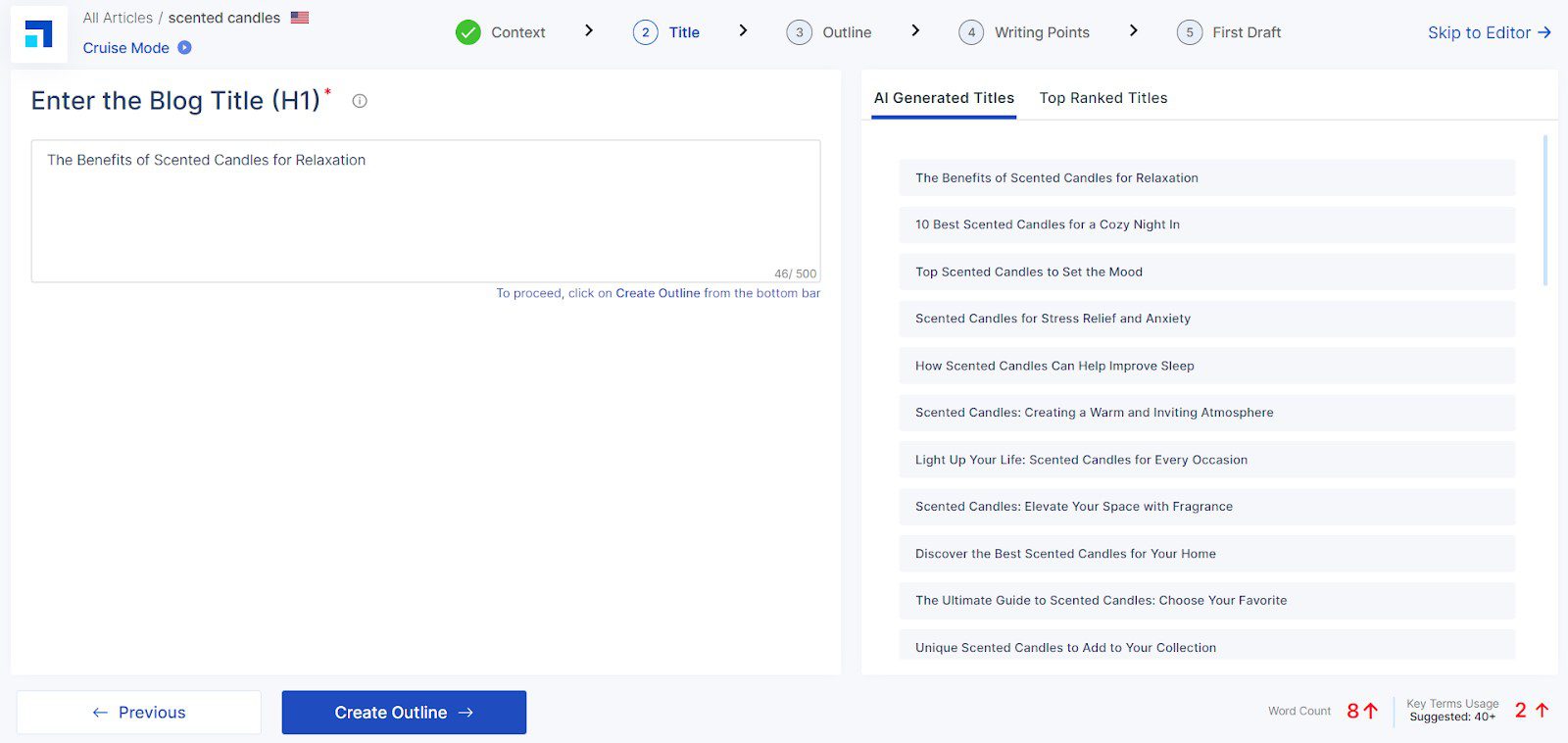
Using Scalenut, businesses can automate their entire content lifecycle to streamline planning, keyword research , writing, and optimization. This is great for reducing the workload on human staff and improving overall efficiency while not replacing your team.
What We Like About Scalenut
- Content Strategy : Scalenut builds content strategies and keyword clusters swiftly using AI, streamlining the planning process.
- Audience Analysis : Analyzes audience search intent and competitors in SERPs to devise the best plan for each content piece.
- AI-Guided Writing : Offers AI-guided writing with real-time optimization, SERP stats, and content scoring for enhanced content quality.
- Marketing Templates : Provides over 40 marketing task templates for creating diverse content, including product descriptions and newsletter emails.
- Depth of Analysis : While Scalenut offers comprehensive SERP and audience intent analysis, the depth of competitor content evaluation could be enhanced to provide more nuanced insights for content differentiation.
- Template Diversity : Although Scalenut provides a robust selection of marketing templates, expanding the range to include more varied content formats could further cater to the diverse needs of content creators and marketers.
Who is Scalenut Best For?
Scalenut is there for businesses looking to rapidly create content at scale to build topical authority and start winning in the SERPs. Lower pricing for SEO content than Surfer SEO, though with fewer integrations. It can be used by itself since it has plenty of AI content creation capabilities.
Users love Scalenut and say that its AI does a good job of writing articles. The only qualms are the high prices and the low credits available in their pricing tiers. That makes it a little less competitive, even though its feature set is top-notch.
The Essential plan starts at $39 per month for 100,000 AI-generated words.
Get Scalenut
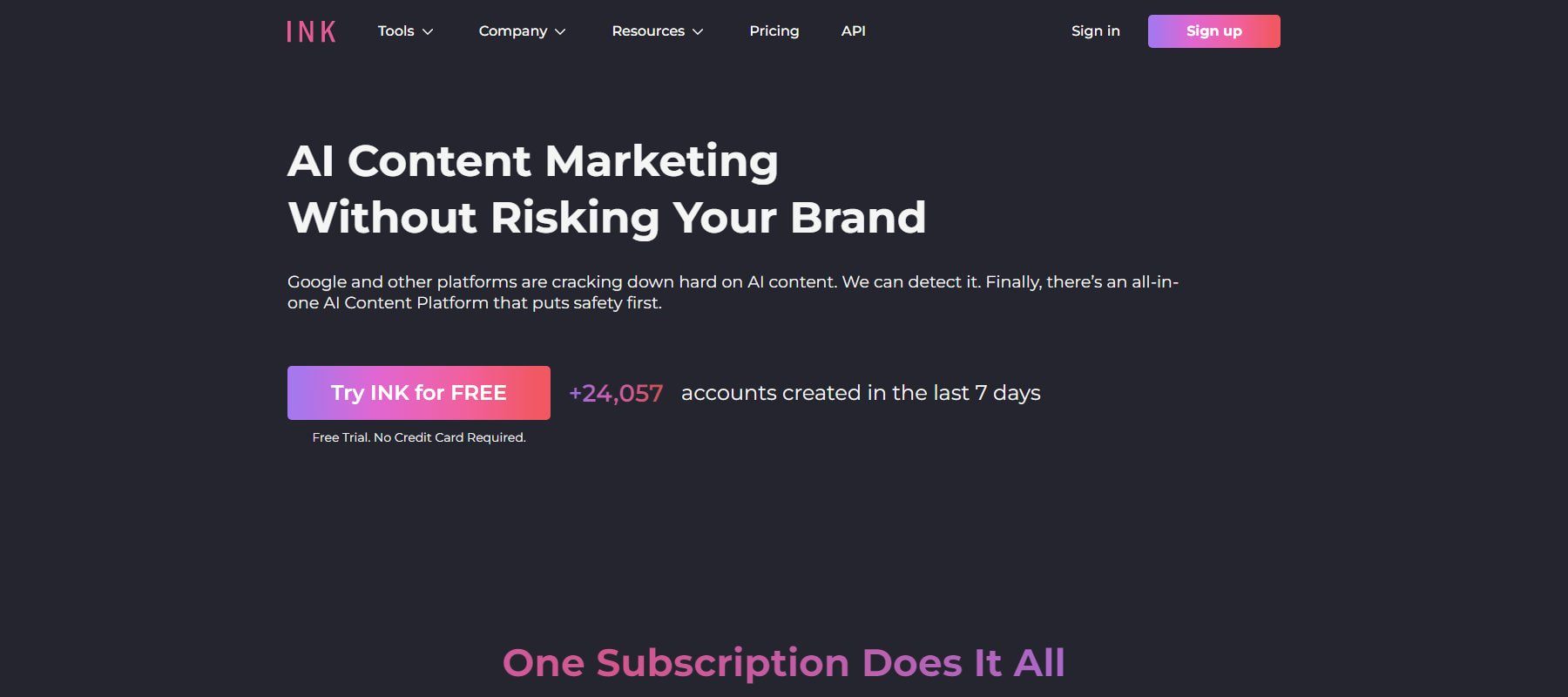
INK is an AI writing tool that can help you create high-quality content in minutes. Any paid plan allows the generation of unlimited words and images, making it an exciting platform to try out. It specializes in content for ranking well with SEO.
INK’s Content Sheild adds a lot of protection so that you can use AI responsibly without wreaking havoc by garnering penalties on your content. It scans unlimited content, finds plagiarism, and detects if common technologies will likely mark the content as written by AI. Performing these checks gives you even more peace of mind as you schedule or hit publish on your Ink-guided content.
What We Like About INK
- Content Shield : INK protects website reputations with Content Shield, ensuring content is plagiarism-free and passes “Written by AI” detection tests.
- AI-Generated Images : Creates AI-generated images based on text prompts, offering visuals that complement your content at affordable prices.
- Keyword Research : Conducts keyword research, pulling search volume, trend, and CPC data to support data-backed content creation.
- SEO Scorer: Gives an easy-to-understand content score for each article so you know it might fare in the SERPs once published.
- Long-Form Writer : The article rewriting features and shorter content writing seems to work better than when it creates long amounts of it.
- Integrations : While INK offers great content creation tools, it could do better at integration with more content management platforms .
Who is INK Best For?
INK is best for individuals and businesses needing unlimited content generation through 130+ marketing templates, a long-form editor, or fast paraphrasing. It’s also of great value with the addition of data-informed SEO tools and a plagiarism detector, and it generates AI images and written content.
Users enjoy INK and are glad that they’ve introduced a SaaS-based writer instead of relying on their legacy desktop application. Some do wish that its integration with WordPress was more reliable. In addition to that, more CMS integrations have commonly been asked for t o make the publication as easy as the writing.
No free plan, and INK starts at $49 per month for unlimited words, articles, and images.
12. WriterZen
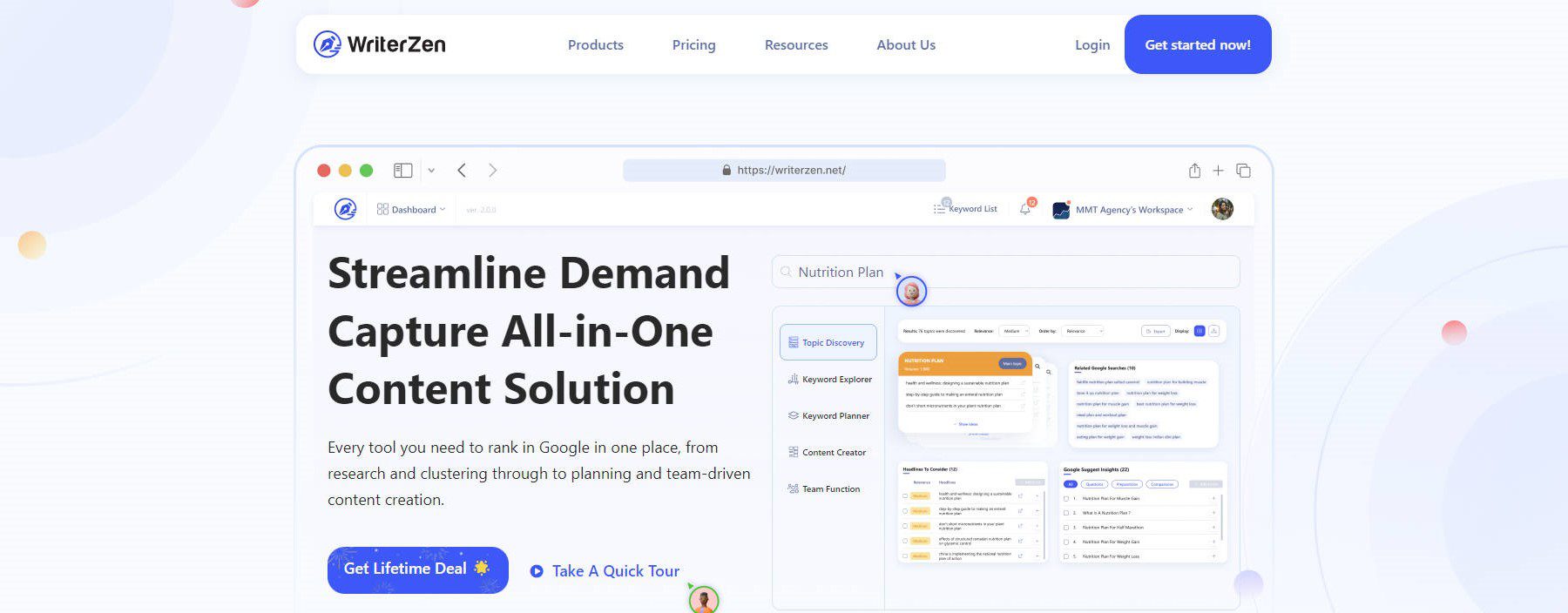
WriterZen is a powerful AI-based SEO writing tool that stands out from many other platforms because of its data-based approach. Anyone creating SEO content for websites, landing pages, and authoritative blogs should consider adding WriterZen to their workflow.
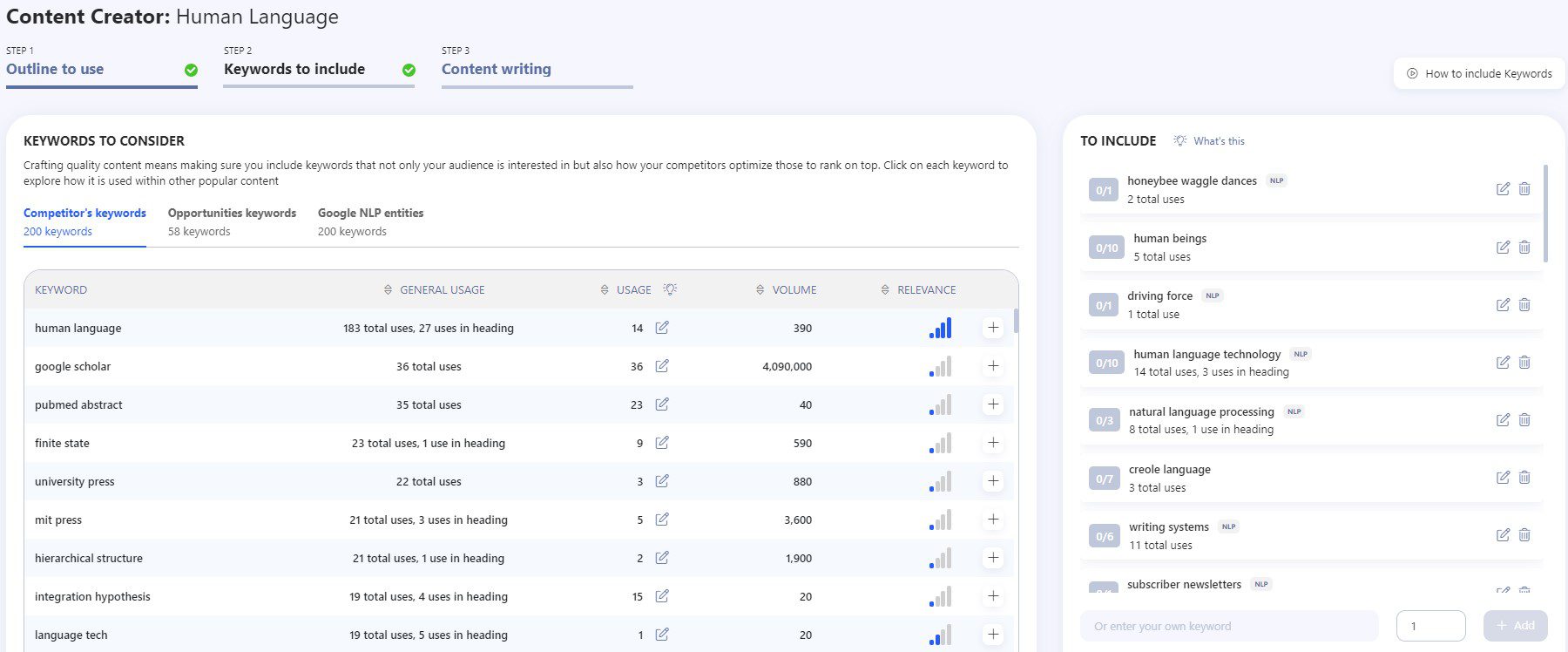
WriterZen’s AI-informed workflow helps you create content that enables you to score valuable organic traffic. Based on SERP data, WriterZen scores keywords on its “Keyword Golden Score” metric, which shows you the best ratio of keyword competition, traffic, CPC, and ranking difficulty. SEO-informed content gets a degree easier with WriterZen.
What We Like About WriterZen
- Keyword Discovery : WriterZen finds high-traffic/low-competition keywords, aiding in targeted content creation.
- Content Outlines : Generates content outlines using advanced NPL analysis of top search results for strategic content structuring.
- Keyword Clusters : Identifies relevant keyword clusters from Google Keyword data and Google Suggest Database for comprehensive content coverage.
- Plagiarism Detection : Features plagiarism and originality detection, ensuring the content’s integrity before publishing.
- User Interface : The platform’s user interface, while functional, can be slow at times, especially when working with keywords.
- Overcrowded Editor : The article editor could use some visual decluttering to make it an efficiency powerhouse.
Who is WriterZen Best For?
WriterZen is built for content teams and websites, pushing out a lot of SEO-optimized content. Bringing SEO tools into a writing platform speeds up content creation. It reduces the work of SEO analysis of content (though it doesn’t replace the need for skilled search specialists and SEO strategies).
Users say the learning curve for WriterZen is a little high just because of the way the UI is set up. In addition, it would be nice if they had more team and collaboration features to work with. Other than that, its performance as an AI writer pleases most users.
No free plan, but paid plans start at $23 per month .
Get WriterZen
13. ClosersCopy

ClosersCopy is one of the more celebrated general-purpose and marketing AI content writers on the market. It specializes in sales and marketing copy but is also very good for blog content using its long-form editor.
ClosersCopy’s ability to create and share frameworks means that there are even more possibilities and use cases for using AI to write niche content. Frameworks specially train ClosersCopy AI to do a particular writing task (such as AIDA copywriting or creating a product description). Most AI writing software limits users to the frameworks (often called use cases or recipes) to what is officially released by the platform. ClosersCopy gives users control over sharing their best frameworks that others can benefit from. It has put together its AI tools into a unique pricing model that many will find compelling.
What We Like About ClosersCopy
- Frameworks : ClosersCopy boasts over 700 frameworks, including those submitted by the community, offering extensive versatility.
- SEO Insights : Provides NPL-guided SEO insights within the text editor, leveraging live search results for optimized content creation.
- Workflows : Enables the stringing together of various ClosersCopy frameworks into a single generative output, streamlining the content creation process (ex., Blog Title -> Blog Outline -> Blog Introduction -> Blog Conclusion, all in a single Workflow).
- Slow Development : Some users have noticed slower development of new features. This is likely due to the developer switching priorities to a new AI writing platform called Copyspace. This has disappointed long-time users of ClosersCopy and is the reason why this product has moved down our list since our last publishing.
Who is CloserCopy Best For?
ClosersCopy is best for salespeople and marketers who need high-quality sales copy. Blog writers and affiliate marketers also benefit significantly from this software. For those looking for a more affordable option, Rytr has fewer features but a much cheaper rate.
There aren’t many reviewers for ClosersCopy, but the few that have left their opinions wish that there was more ongoing development and new features. They say that what once was an excellent AI writing platform has slipped into mediocrity a bit.
High starting price of $49.99 per month .
Get ClosersCopy
14. HubSpot AI Blog Writer
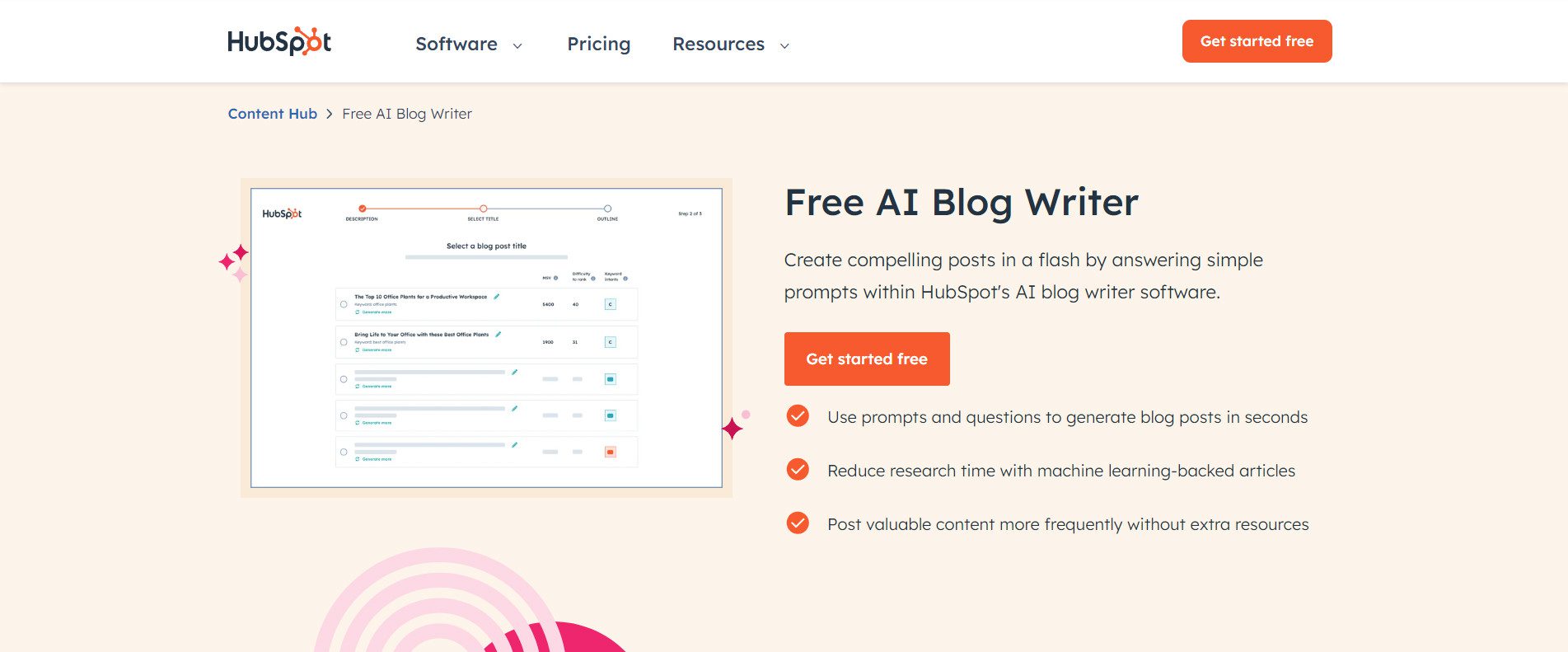
HubSpot’s Free AI Blog Writer is an innovative solution that revolutionizes how businesses approach blog content creation. By using the power of artificial intelligence, this tool simplifies and accelerates the process of generating engaging, high-quality blog posts. It’s an integral part of HubSpot’s suite, aimed at enabling marketers, bloggers, and business owners to maintain a consistent content schedule without compromising on quality or spending excessive time on content creation.
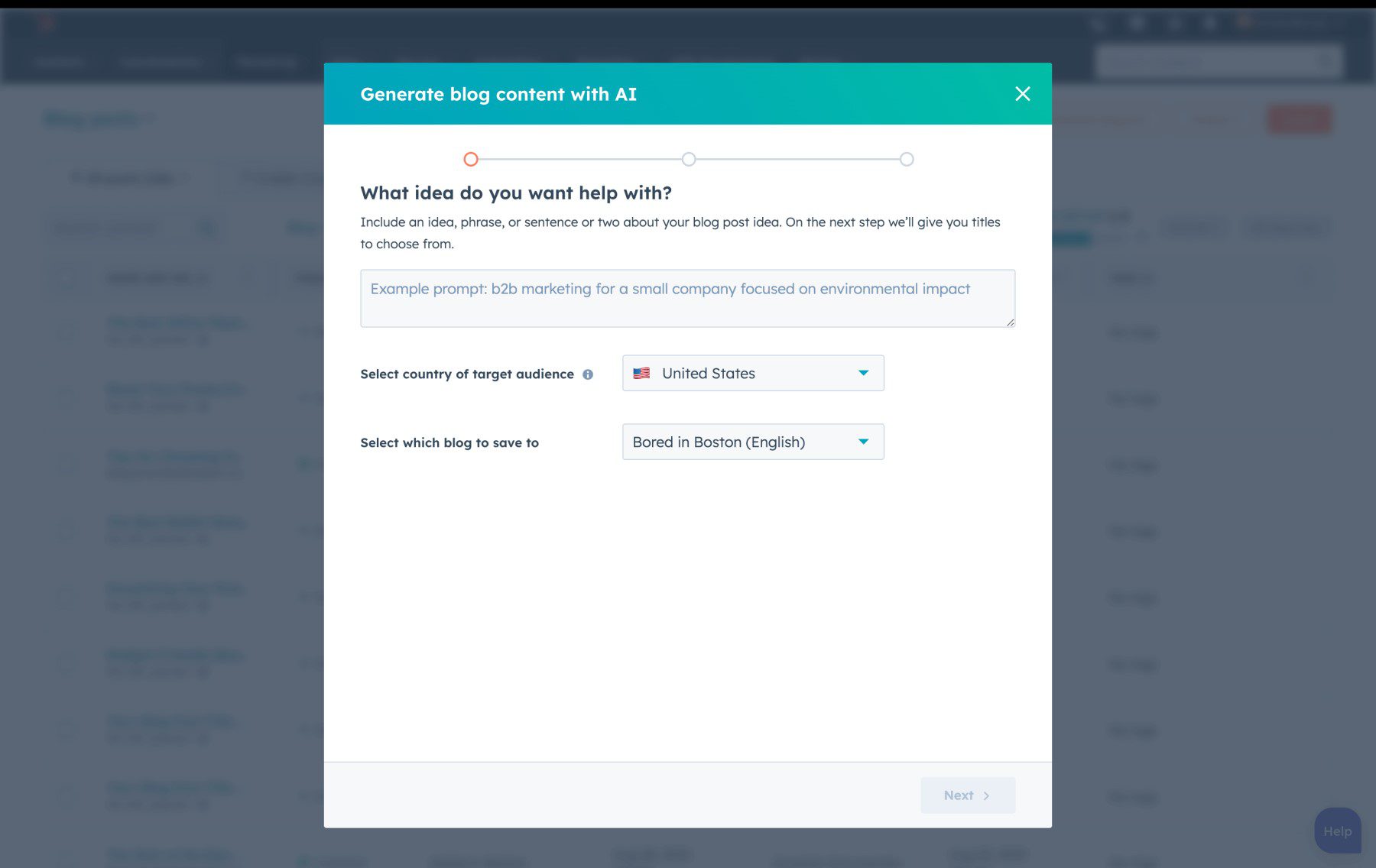
What We Like About HubSpot
- AI-Powered Content Creation: This tool leverages advanced AI algorithms to generate blog post drafts, saving time and effort in the content creation process.
- SEO Optimization: It assists in optimizing content for search engines, helping your blog posts to rank higher and reach a wider audience.
- Tone and Style Customization: HubSpot offers options to adjust the tone and style of the generated content to match your brand’s voice.
- Content Improvement Suggestions: Provide intelligent suggestions to improve existing blog content for readability and engagement.
- Limited Focus: Its AI writer is focused on blog posts, so it isn’t the most valuable tool, but it excels at what it does.
Who is HubSpot Best For?
HubSpot’s Free AI Blog Writer is best suited for content creators, digital marketers, and small to medium-sized business owners who are looking to streamline their content creation process. It’s an ideal tool for those who want to consistently produce high-quality blog content but are constrained by time or lack in-house writing resources. Whether you’re looking to boost your content marketing strategy, increase your website’s SEO presence, or simply maintain an active blog with less effort, this AI-powered writer can significantly ease the content creation burden.
There are no separate reviews for HubSpot’s AI writing tool, but there are plenty of reviews for the broader HubSpot platform.
The core functionality of HubSpot’s Free AI Blog Writer is available at no cost, making it an accessible option for businesses and individuals looking to enhance their content strategy without immediate financial investment.
Get HubSpot’s AI Writer
How AI Can Help Your Writing Workflows
AI writing platforms provide various solutions, which makes sense considering all the different types of writing and writing tasks people encounter daily. For instance:
- Faster Content Marketing: There are copywriting AI tools to help your marketing strategy by generating high-quality content faster for marketing, product descriptions, and sales copy .
- Easy Content Updates : There are AI tools for rewriting existing content so your content remains fresh and relevant.
- SEO Content Optimization: SEO AI tools can use Natural Language Processing (NPL) based on keywords to help create quality SEO content . All the best SEO tools already use AI to help with advanced SEO techniques .
- Enhanced Creativity: Story and creative AI writing software quickly generates innovative ideas and helps write illustrative content.
- Automate Editing Tasks: There are proofreading AI tools (like Grammarly ) that offer real-time spelling, grammar, and plagiarism checks to improve your content and ensure it is fit for publishing.
Suppose you’re someone in charge of writing or editing multiple types of content (on-brand copywriting, ad copy, long-form articles, stories, PR). In that case, you’ll probably benefit from having various AI writing assistants. With that in mind, let’s explore some of the best.
Comparing the Best AI Writers
With so much AI writing software to choose from and so many details listed above, we thought we’d give you a 30,000-foot view of the products we covered in this article.
Feature Comparison of Best AI Writers
Feature coverage is an important aspect of any tool. But, the highest number of features don’t always “win”—sometimes, the right few features are all it takes. Anyway, here is a feature comparison of our top three choices of AI writers. See if any of these tools has the right mix for you.
| 🥇 | 🥈 | 🥉 | |
|---|---|---|---|
| Starting Price | $9/mo | $69/mo | $19/mo |
| Free Plan Available | ✔️ | ❌ | ❌ |
| Multilingual Support | ✔️ | ✔️ | ✔️ |
| SEO Integrations | ✔️ | ✔️ | ❌ |
| Templates and Frameworks | ✔️ | ✔️ | ✔️ |
| Long-Form Content Generation | ✔️ | ✔️ | ✔️ |
| Chrome Extension | ✔️ | ✔️ | ❌ |
| Real-Time Content Collaboration | ❌ | ✔️ | ❌ |
| AI Art Generation | ✔️ | ✔️ | ❌ |
| Built-in Plagiarism Checker | ✔️ | ✔️ (Copyscape) | ❌ |
| Customizable Brand Voice | ✔️ | ✔️ | ❌ |
| Community Rating | ⭐⭐⭐⭐ | ⭐⭐⭐⭐⭐ | ⭐⭐⭐⭐ |
Price Comparison of AI Writing Tools
AI writing tools have pricing that is all over the board. From low-cost solutions to enterprise-level products, there is everything on this list. See which ones are closest to your price range.
| Best AI Writers | Starting Price | Free Plan | Reviews | Visit | |
|---|---|---|---|---|---|
| 🥇 | $9/mo | ✔️ | ⭐⭐⭐⭐⭐ | ||
| 🥈 | $69/mo | ❌ | ⭐⭐⭐⭐⭐ | ||
| 🥉 | $19/mo | ❌ | ⭐⭐⭐⭐ | ||
| $49/mo | ✔️ | ⭐⭐⭐⭐ | |||
| $19/mo | ✔️ | ⭐⭐⭐⭐ | |||
| $49/mo | ❌ | ⭐⭐⭐⭐ | |||
| $27/mo | ❌ | ⭐⭐⭐⭐⭐ | |||
| $14.99/mo | ❌ | ⭐⭐⭐⭐⭐ | |||
| $89/mo | ❌ | ⭐⭐⭐⭐⭐ | |||
| $39/mo | ❌ | ⭐⭐⭐⭐⭐ | |||
| $49/mo | ❌ | ⭐⭐⭐⭐⭐ | |||
| $23/mo | ❌ | ⭐⭐⭐⭐⭐ | |||
| $49.99/mo | ❌ | ⭐⭐⭐⭐ | |||
| Free | ✔️ | N/A |
What is the Best AI Writing Software?
Rytr is an excellent starting point for those looking for a budget-friendly, all-purpose AI writer. Jasper (with Boss Mode) and Article Forge are worth considering if you need to produce long-format writing. For creative writing, Sudowrite is the standout tool. We’d also be remiss if we didn’t say that Surfer SEO is one of the best companions for an AI writer, and if your writer has an integration, definitely consider getting it.
Are you looking for more amazing AI tools? Take a look at the top AI tools that are changing the way we work and live.
Frequently Asked Questions (FAQs)
Before we wrap up, let’s answer some of your most commonly asked questions regarding AI writing software. Did we miss one? Leave a comment below, and we’ll reply!
What is the best AI writing software?
What is the best free ai writing tool, what is the best long-form ai writing assistant, what is the best creative writing ai software, how can i detect ai-generated content, how can i avoid ai detection in writing, how much do ai writing tools cost, what are the risks associated with ai writing, can i use ai to write blog posts, what is the best ai writing software for landing pages, can i use ai writing software to make money, what is the best ai writing software for seo.
Featured Image via BestForBest / shutterstock.com

Explore Our Top Picks
Here are our favorites! 👇
Get Rytr Today!
With so many great options available, it can be hard to pick one. find out why rytr is our favorite. 👇.

By Christopher Morris
Christopher Morris writes about the intersection of Marketing and Websites. He loves to help people gain the confidence to move their passions online. He can be found strolling around LinkedIn as well as the Rocky Mountains in Colorado when he is recharging.
Explore Divi, The Most Popular WordPress Theme In The World And The Ultimate Page Builder

Check Out These Related Posts

Best AI Tools For Social Media Content Creation in 2024
Updated on June 5, 2024 in Marketing
Are you struggling to develop fresh ideas for social media posts regularly? AI tools can help you brainstorm new ideas and overcome creative block. These tools are changing how people make content for social media. You can create posts that catch attention, determine what’s popular, and...
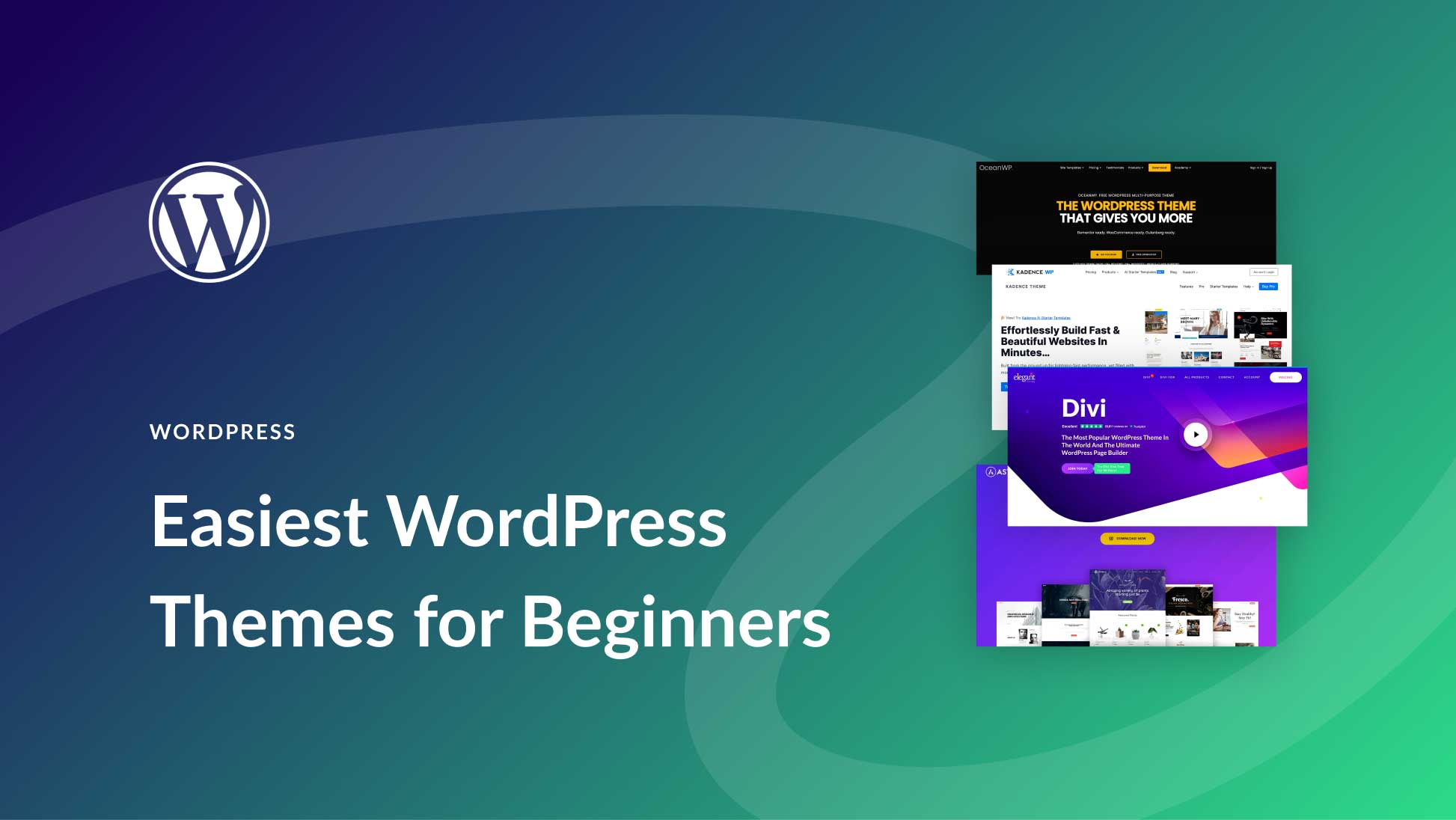
Easiest WordPress Themes for Beginners in 2024 (Compared)
Updated on May 30, 2024 in WordPress
Choosing a WordPress theme can be overwhelming, especially for a beginner. No need to worry, though. We’ve combed through hundreds of popular WordPress themes to showcase free and premium options suited to those new to WordPress. Whether you need a free or a premium option, the products on...

8 Best AI Scheduling Assistants in 2024 (Compared)
Posted on May 5, 2024 in Business
Daily planning can be challenging, especially when managing appointments, scheduling meetings, and preventing calendar conflicts across multiple time zones and commitments. AI scheduling assistants can help by streamlining the process, considering your availability, time zones, and preferences, and...
Interesting article. Thank you. Any particular reason why you didn’t include Agility Writer?
Sandra, there are just too many to cover them all. Plus, others on this list are similar in scope to the tool you mentioned. Glad it was helpful.
Have you had any experience with Bard AI yet? I was expecting to see it on your list but maybe that’s because it hasn’t rolled out to everyone yet.
Susan, I have used Bard, but we will include that on a different post coming out in the coming weeks. Bard is solid, but it’s still early days. I like using it over ChatGPT when I need a concrete answer. I don’t like using it for any task that requires too much creativity. We’ll see how it only improves over time.
A really useful article to read, I’ve been using the Bertha AI toolkit now for some time, before the AI world exploded. Also well worth a look!
Hey Steve, there really are so many great (and not-so-great) options out there these days. Bertha AI looks like a great AI Chatbot for WordPress. Here in a few days, we’ll have a post dedicated to chatbots. Thanks for your thoughts!
Lol.. great article… and of course I desperately need to know how you did that “expand list” functionality in the introduction!
What about Katteb? It is a Long-Form AI writer that aims to provide fact check information and does some more job to enhance the quality of work.
Thanks Outboxed! In the spirit of AI tech, you could consult ChatGPT and see if it can help you create something like that for your sites.
Leave A Reply Cancel reply
- Recent Posts
- Get a Free Chinese Restaurant Layout Pack For Divi
- How to Make a Church Website with WordPress (2024 Tutorial)
- Do You Need a WordPress Page Builder in 2024?
- Download a Free Spa Theme Builder Pack for Divi
- WordPress Pricing: How Much Does WordPress Cost? (2024)
- Divi Resources
- Theme Releases
- Tips & Tricks
974,872 Customers Are Already Building Amazing Websites With Divi. Join The Most Empowered WordPress Community On The Web
We offer a 30 Day Money Back Guarantee, so joining is Risk-Free!
Divi Features
- All Features Explore Divi
- Divi Modules
- Divi Layouts
- No-Code Builder
- Ecommerce Websites
- Theme Builder
- Marketing Platform
- Speed & Performance
- Premium Support
- Divi Marketplace
- Divi AI Brand New!
- Divi Hosting
- Extra Theme
- Bloom Plugin
- Monarch Plugin
- Plans & Pricing Get Divi Today
- Documentation
- Help Articles & FAQ
- 24/7 Support
- Developer Docs
- System Status
- Product Updates
- Best Plugins
- Best Hosting
- Divi Meetups
- Divi Facebook Group
- Divi Examples
- Divi Integrations
- Divi Reviews
- Community Forum
- Affiliate Program
- Terms of Service
- Privacy Policy
Copyright © 2024 Elegant Themes ®

IMAGES
VIDEO
COMMENTS
Creative writing is an art form that transcends traditional literature boundaries. It includes professional, journalistic, academic, and technical writing. This type of writing emphasizes narrative craft, character development, and literary tropes. It also explores poetry and poetics traditions.
Last updated on Feb 14, 2023. 10 Types of Creative Writing (with Examples You'll Love) A lot falls under the term 'creative writing': poetry, short fiction, plays, novels, personal essays, and songs, to name just a few. By virtue of the creativity that characterizes it, creative writing is an extremely versatile art.
Types of Creative Writing. Examples of creative writing can be found pretty much everywhere. Some forms that you're probably familiar with and already enjoy include: • Fiction (of every genre, from sci-fi to historical dramas to romances) • Film and television scripts. • Songs. • Poetry.
An example of creative writing, a novella is essentially the love child of a short story and a novel. Although the novella does feature a plot, the plot is typically less complicated compared to that of a novel. Usually novellas are about 50 pages. 21. Genre Writing.
5 Key Characteristics of Creative Writing. Creative writing is marked by several defining characteristics, each working to create a distinct form of expression: 1. Imagination and Creativity:Creative writing is all about harnessing your creativity and imagination to create an engaging and compelling piece of work.
One example of creative writing is fiction writing. Fiction includes traditional novels, short stories, and graphic novels. By definition, fiction is a story that is not true, although it can be ...
Authors will often use creative storytelling or creative writing skills to tell engaging, interesting stories, or to convey information in an interesting manner. The Creative Pen by Joanna Penn. The Artist's Road by Patrick Ross. terribleminds by Chuck Wendig.
Creative writing is a written art form that uses the imagination to tell stories and compose essays, poetry, screenplays, novels, lyrics, and more. It can be defined in opposition to the dry and factual types of writing found in academic, technical, or journalistic texts.
Creative writing is the art of creating original works of self-expression that entertain and give voice to the human experience. Unlike technical or academic writing, the purpose of creative writing is not to present facts but to give rein to the writer's imagination through poetics and storytelling.A creative writer invites the reader to step out of reality and enter a fantasy realm created ...
Read through the following examples to get ideas for your own writing. Make a note of anything that stands out for you. 1. Novels and Novellas. Inspiring novel-writing examples can come from the first paragraph of a well-loved novel (or novella), from the description on the back cover, or from anywhere in the story.
Literary techniques you develop with writing plays and screenplays can include satire, motif, dramatic irony, allusion, and diction. 5. Personal essays. Focusing on the author's life and experiences, a personal essay is a form of creative non-fiction that almost acts as an autobiography.
1. Novels. There is hardly a 21st-century teenager who hasn't laid their hands on a novel or two. A novel is one of the most well-loved examples of creative writing. It's a fictional story in prose form found in various genres, including romance, horror, Sci-Fi, Fantasy and contemporary.
Creative writing examples. Creative writing covers more than just fiction, or even just novels. Here's a quick rundown of some types of creative writing you might encounter. 1. Novels. Novels (which fall under the 'fiction' umbrella) are a type of creative writing where the reader follows a character or characters through a plot.
The final example of creative writing is twofold; poetry and songs. Both of these formats are similar to one another, relying on creativity to deliver a combination of things. Poetry can take so many forms and styles, but it aims to inspire readers and get them thinking. Poems often have hidden meanings behind them, and it takes a great deal of ...
Creative Writing is a form of art that allows people to express their thoughts, ideas, and emotions through the written word. It is a mode of self-expression that combines imagination with linguistic skills to create compelling narratives, poems, and other forms of literature. A Statista survey found that 76,300 Authors, Writers and Translators ...
What is creative writing? The answer can be simple, but breaking it down is far more useful. Learn more and gain some insightful tips for yourself, as well! ... This excerpt from Lewis Carroll's "The Walrus and the Carpenter" is an example of creative writing because it is not based in fact and uses a lot of imagination. If seven maids with ...
Creative Writing is a diverse and exciting art that demands Writers to look into their imagination and express their thoughts in unique ways. From short stories to poetry, different Types of Creative Writing which cater to different styles and preferences. In this blog, we will delve into the different Types of Creative Writing, offering insights and examples to help you navigate the world of ...
Scripts: Hit the screen or the stage by writing scripts for film, television, theater, or video games. Beware: film is a director's medium, not a writer's medium, but movies have the potential to reach a non-reading audience. Storytelling: Storytelling is the most popular form of creative writing and is found in the realms of both fiction ...
3. Throw perfection to the wind. Separate your writing from your editing. Anytime you're writing a first draft, take off your perfectionist cap. You can return to editor mode to your heart's content while revising, but for now, just write the story. Separate these tasks and watch your daily production soar.
Creative Writing Examples. Image: freepik 4/ Screen Writing - Creative Writing Examples: Screenwriting is a unique form of creative writing that brings stories to life on big and small screens. Here are a few famous examples of screenwriting from iconic films and TV series: 1/ Movie - "Get Out" (2017) Script - Written by Jordan Peele:
Creative Writing Examples are the beacons of literary artistry. These examples showcase the kaleidoscope of human thought and emotion across genres and styles. From the pages of classic novels to the verses of poignant poetry, the world of Creative Writing Examples offers a tapestry of narratives, each a unique exploration of the human ...
What is Creative Writing? Creative writing is a genre of writing that seeks to evoke emotions and feelings in its readers. It surpasses the limits of traditional forms of literature and emphasizes narrative craft, character development, and the use of literary tropes and poetic traditions.
The Online Writing Lab (the Purdue OWL) at Purdue University houses writing resources and instructional material, and we provide these as a free service at Purdue. Students, members of the community, and users worldwide will find information to assist with many writing projects.
Combining art and a play-based approach to creative writing in first grade can set students on a path to success by building on their confidence, creativity, imagination, and sense of accomplishment. I have witnessed that the integration of art and writing has helped my students discover how writing can be a joyful and memorable experience ...
50 Writing Prompts to Spark Creativity at Work. Here's a list of diverse writing prompt examples to help you get started. You can use them as is, customize them, or take inspiration from them to build or expand your own prompts.
Entertainment. One of the primary and most recognisable objectives of Creative Writing is to entertain. Creative writers craft stories, poems, and essays that are designed to captivate readers, transporting them to different worlds, evoking emotions, and engaging their imaginations. At its heart, Creative Writing is the art of storytelling, and ...
Writing prompts can help you keep your target language in shape. Skills can slip over time, so continuing to practice your writing can help prevent backsliding. Using writing prompts can help make it so that writing in your target language feels easy and requires less conscious effort. Writing in a foreign language is a skill like any other ...
Examples of resume objectives for creative jobs 16. Content writer. Results-driven content writer with two years of experience writing for blogs and websites. Skilled in SEO, creative copywriting, and storytelling, looking forward to applying my skills and creative ideas to help XYZ build an engaged audience. Find content writer jobs on The ...
Drawing, music and writing can elevate your mood. Here are some easy ways to welcome them into your life. ... creative writing, drawing and singing we used to enjoy as children. ... for example ...
The best creative AI writing tool is Sudowrite. It uses GPT 3 and proprietary AI models to generate content and offers features like "first draft" and "describe," which add descriptive creative writing to a section of text. Sudowrite is designed to help writers overcome writer's block and generate new ideas for their writing.